
| JAPANESE | TOP PAGE | |
|---|---|---|
| 0 | 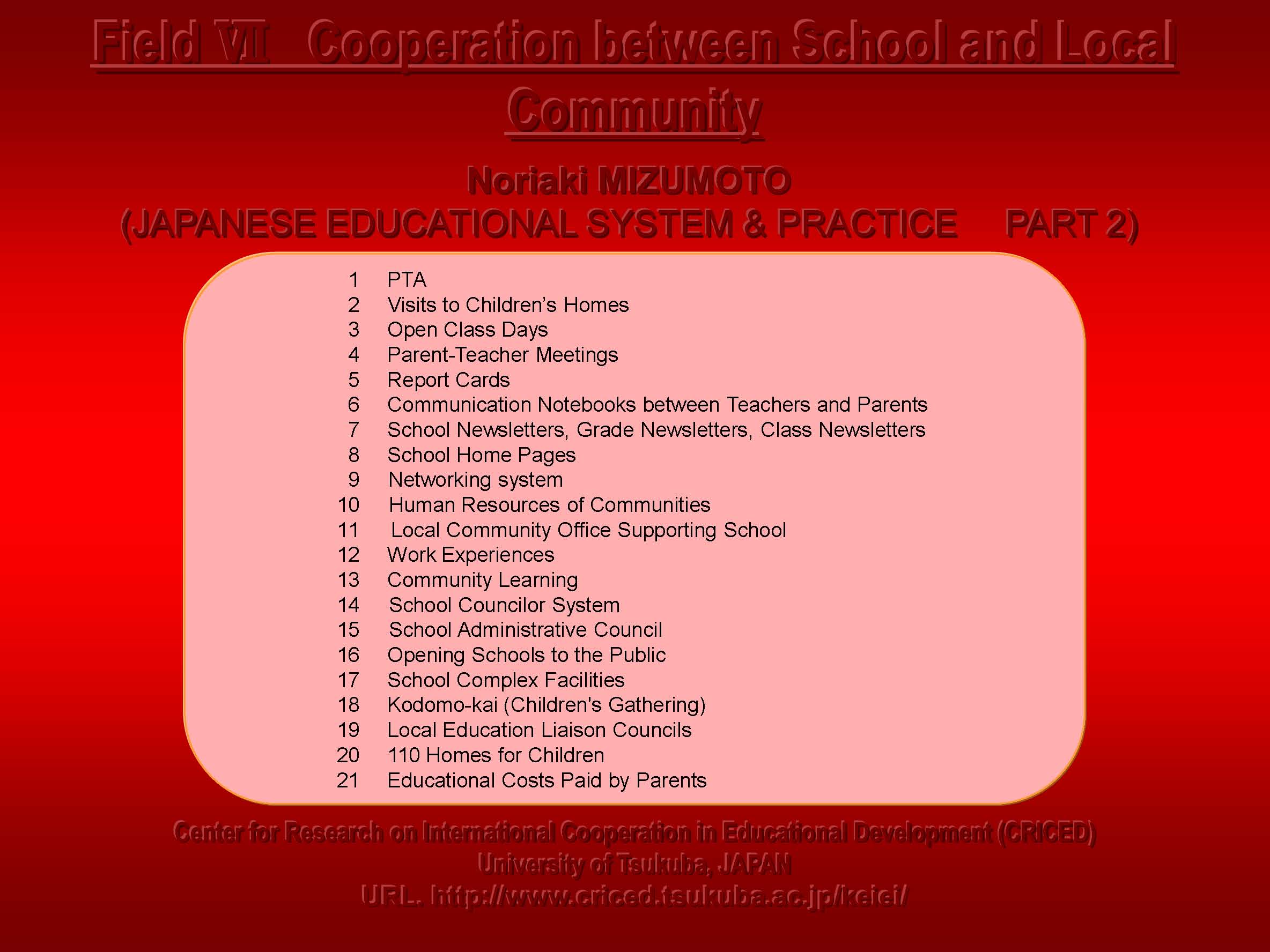 |
Download : VII Cooperation between School and Local Community |
| 1 | 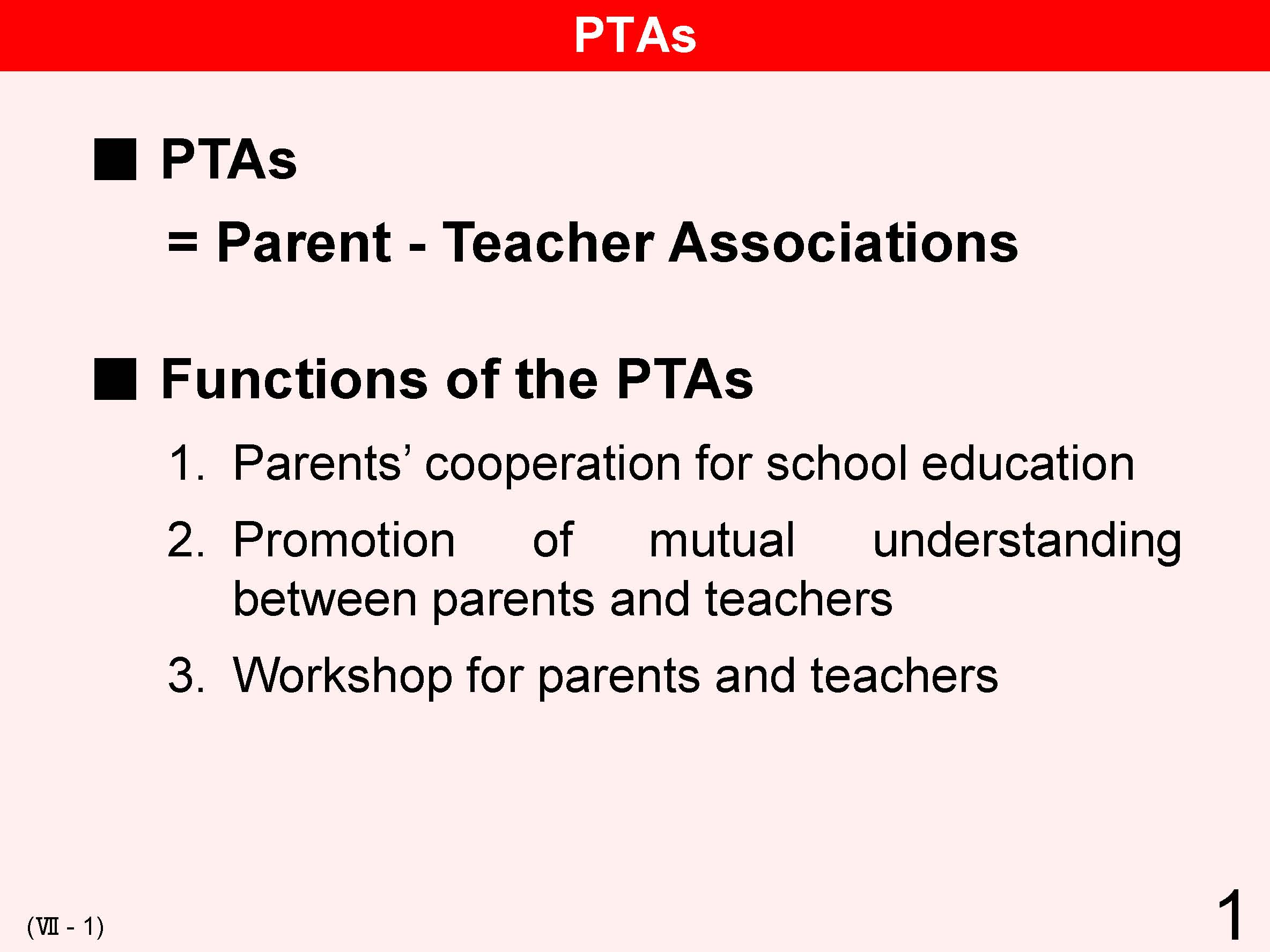 |
PTAs are organizations comprising parents (guardians) and teachers. Some PTAs, however, include families who have no children. Roles of PTAs include: (1) To obtain cooperation of parents to maintain positive local educational environments, and to curry out educational activities; keeping up schoolyards, educational volunteer work (for example story teller classes), collection of bell marks, etc. (1) To inform teachers about parents’ opinions or requests, to inform parents about school policies and ideas regarding school activities in order to promote mutual understanding between parents and teachers; to hold parent-teacher meetings in which board meeting officers forward parental requests to schools, publication of PTA news (3) To hold workshops about education and parenting for parents and teachers; lectures, study tours |
| 2 | 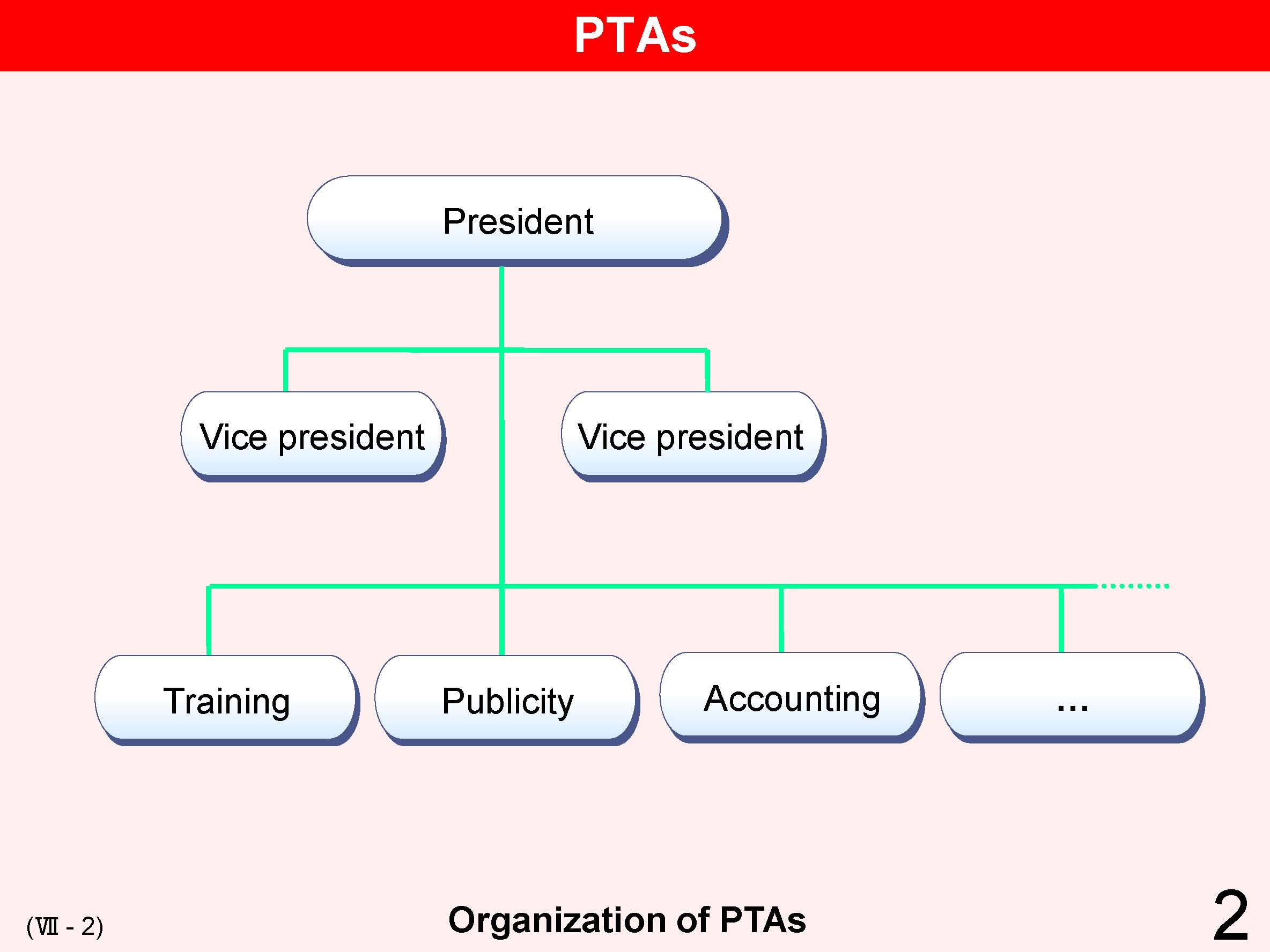 |
There are many committees and persons involved in Parent - Teacher Associations (PTAs). PTA Presidents are representative of and responsible for the PTAs, and are usually elected from among students’ parents. PTA Vice presidents are elected from teachers, and in many cases, from vice- principals. PTA Vice presidents also may be composed of two people: one is a teacher, the other is a parent. The PTA vice presidents assist the presidents. PTAs are divided into committees such as workshop, publicity and accounting committees. Committees for each grade and class are also formed in the associations and function as individual PTAs for grades or classes. (School management duties -->Ⅵ 19) |
| 3 | 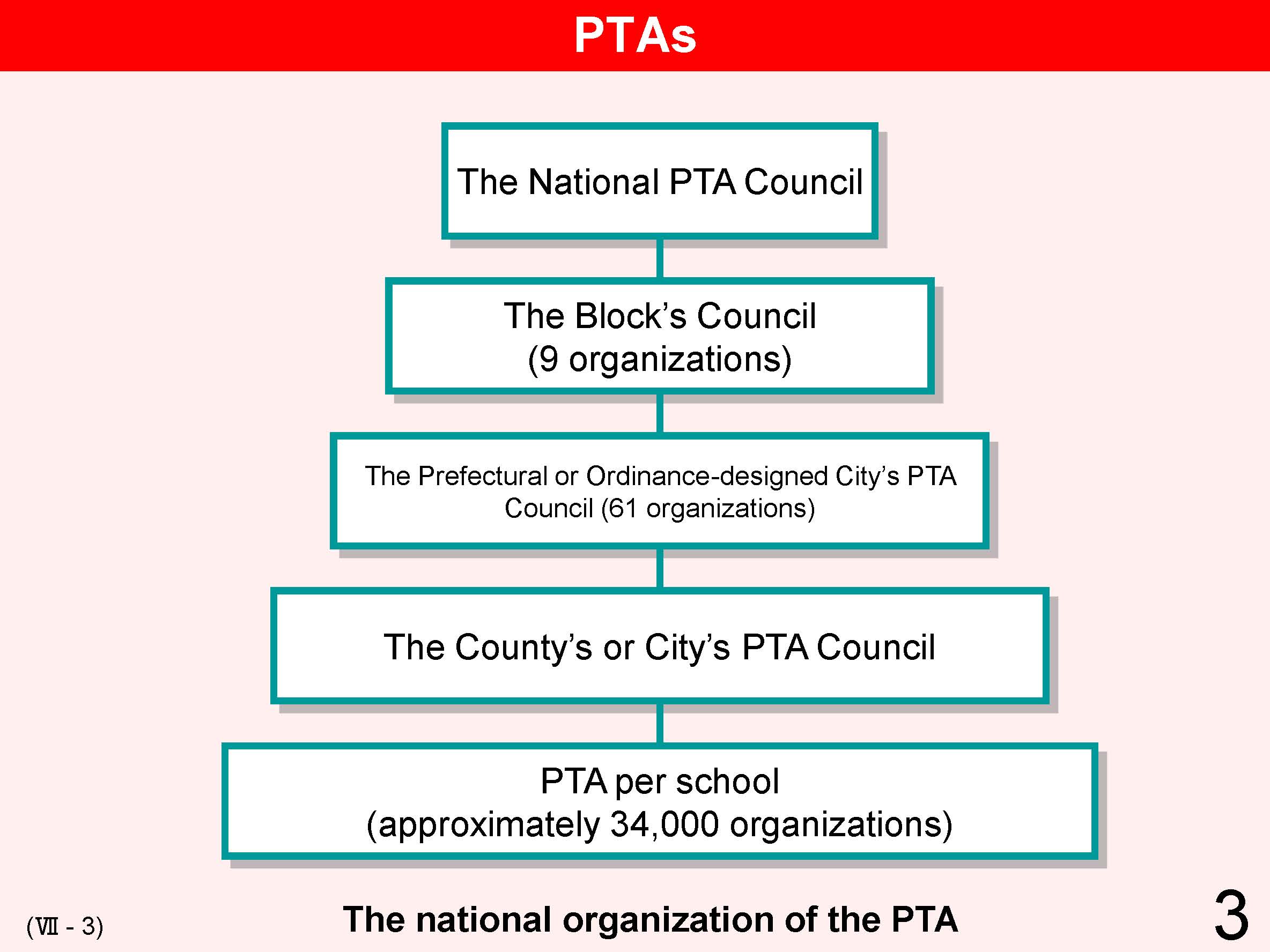 |
A single Parent-Teacher Association (PTA) is established per school, and PTAs are also set up at national, block, prefectural, and local levels. The national PTA organization provides training and conducts public relations. The National PTA Council, as a PTA organization for elementary schools and lower secondary schools, holds national conferences and workshops, publishes journals and case studies, conducts youth civilizing projects, and commends excellent PTAs and people for distinctive merits. This is designed to promote a combination of school education, social education and home education to promote sound youth development and to improve welfare. In the National PTA Council of upper secondary schools, there are similar activities. |
| 4 | 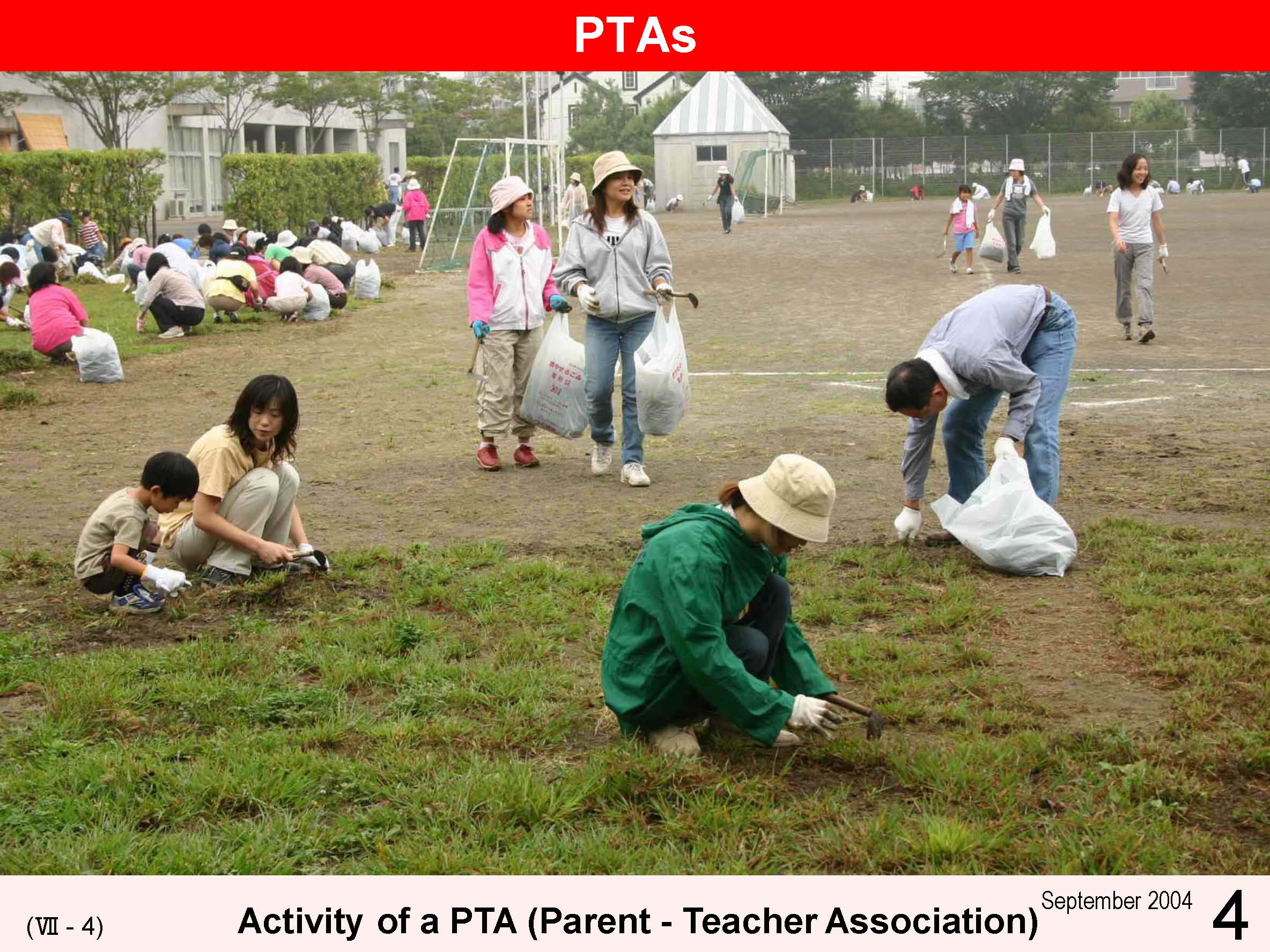 |
Picture: shows volunteer work organized as a cooperative activity for schools by PTAs. It includes cleaning-up a playground and school buildings and helping to maintain facilities. By engaging in work in a cooperative manner, positive effects include deepening of mutual understanding and friendship between parents and teachers. September 2004 |
| 5 | 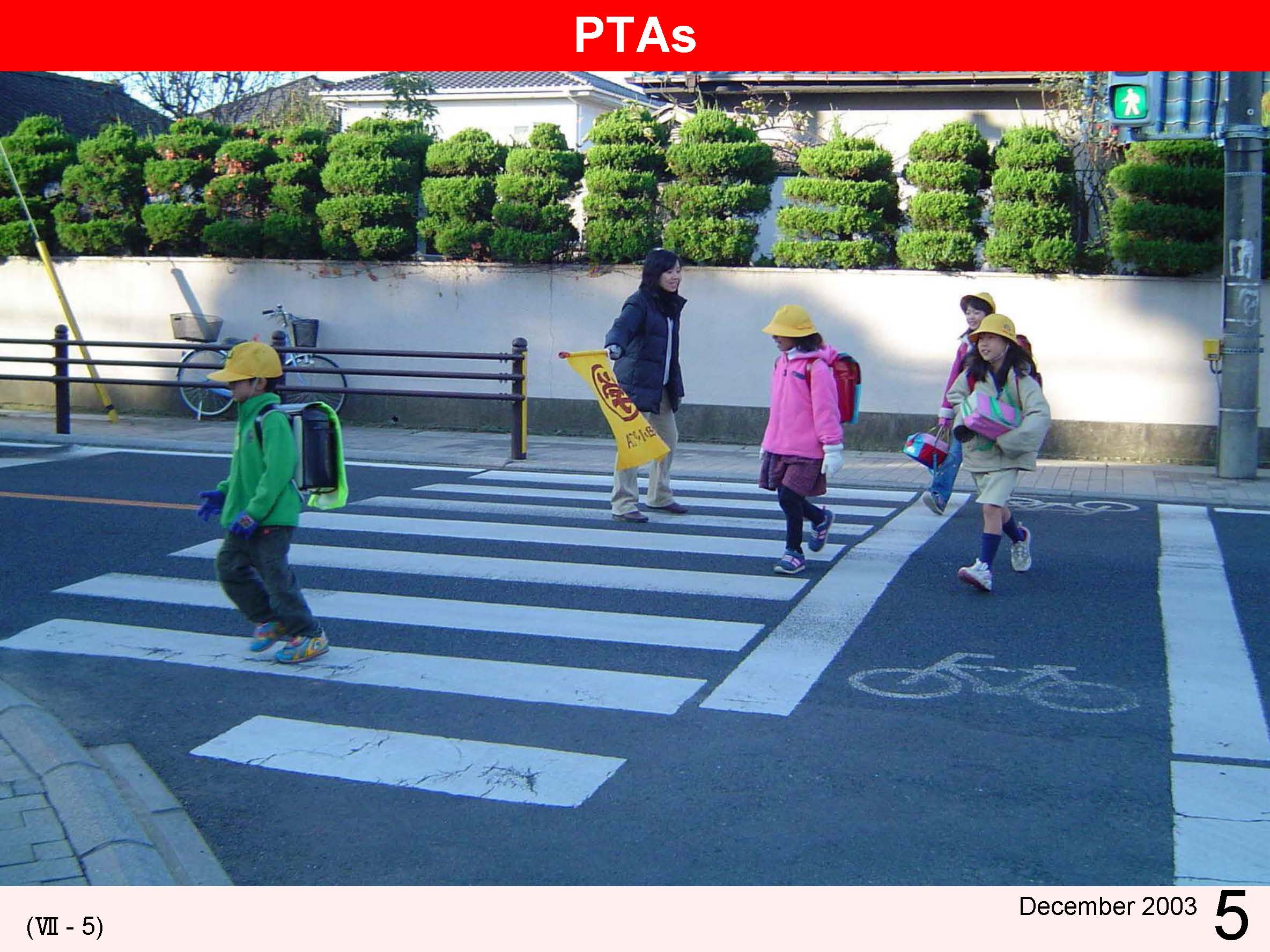 |
Road safety guard duties by a PTA |
| 6 | 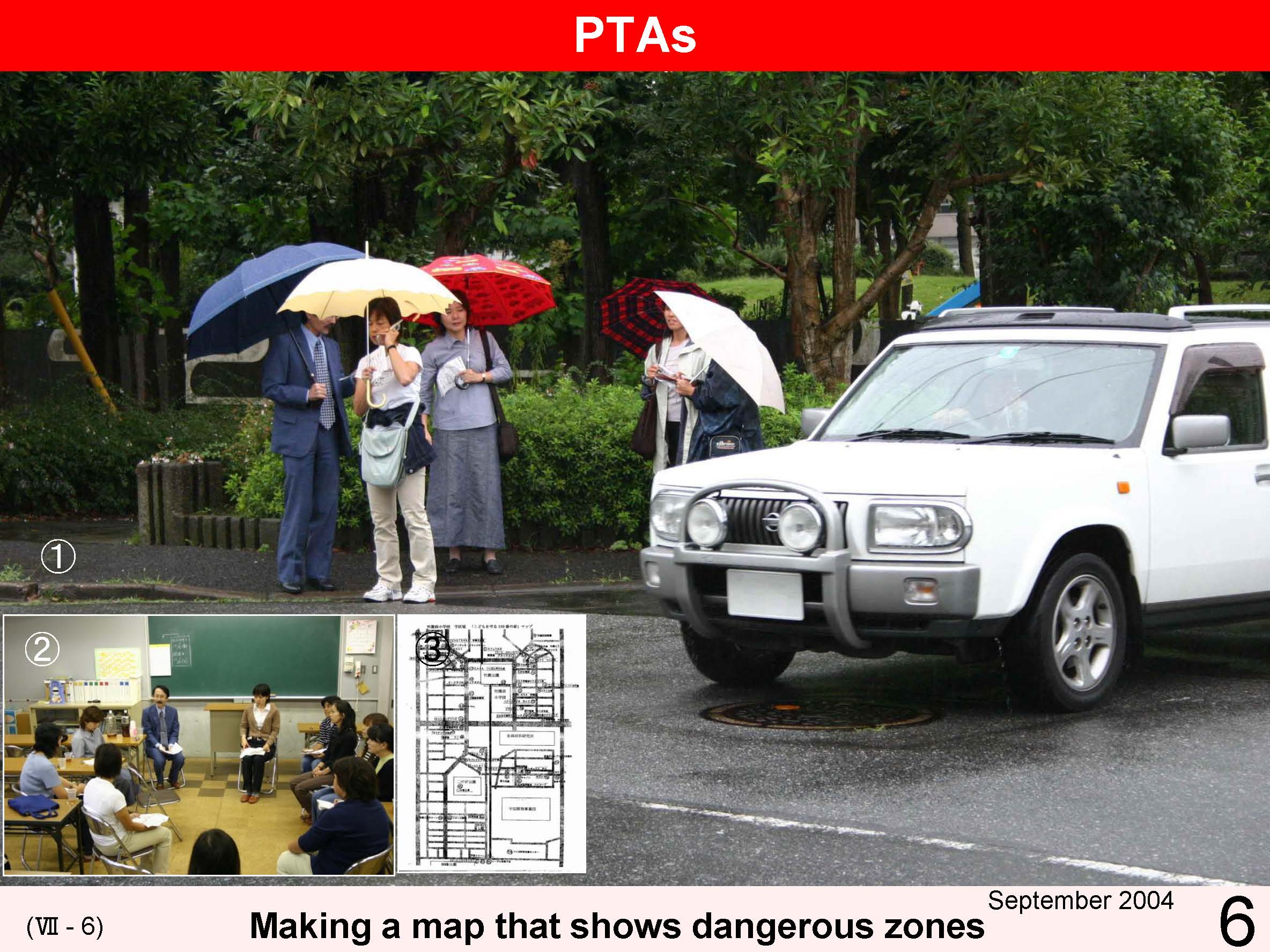 |
(1) Representatives of the PTA inspect dangerous areas near a school. (2) They report dangerous areas after their inspection and information attained by police officers. (3) They make a dangerous zone map that will be given to each student’s family. |
| 7 | 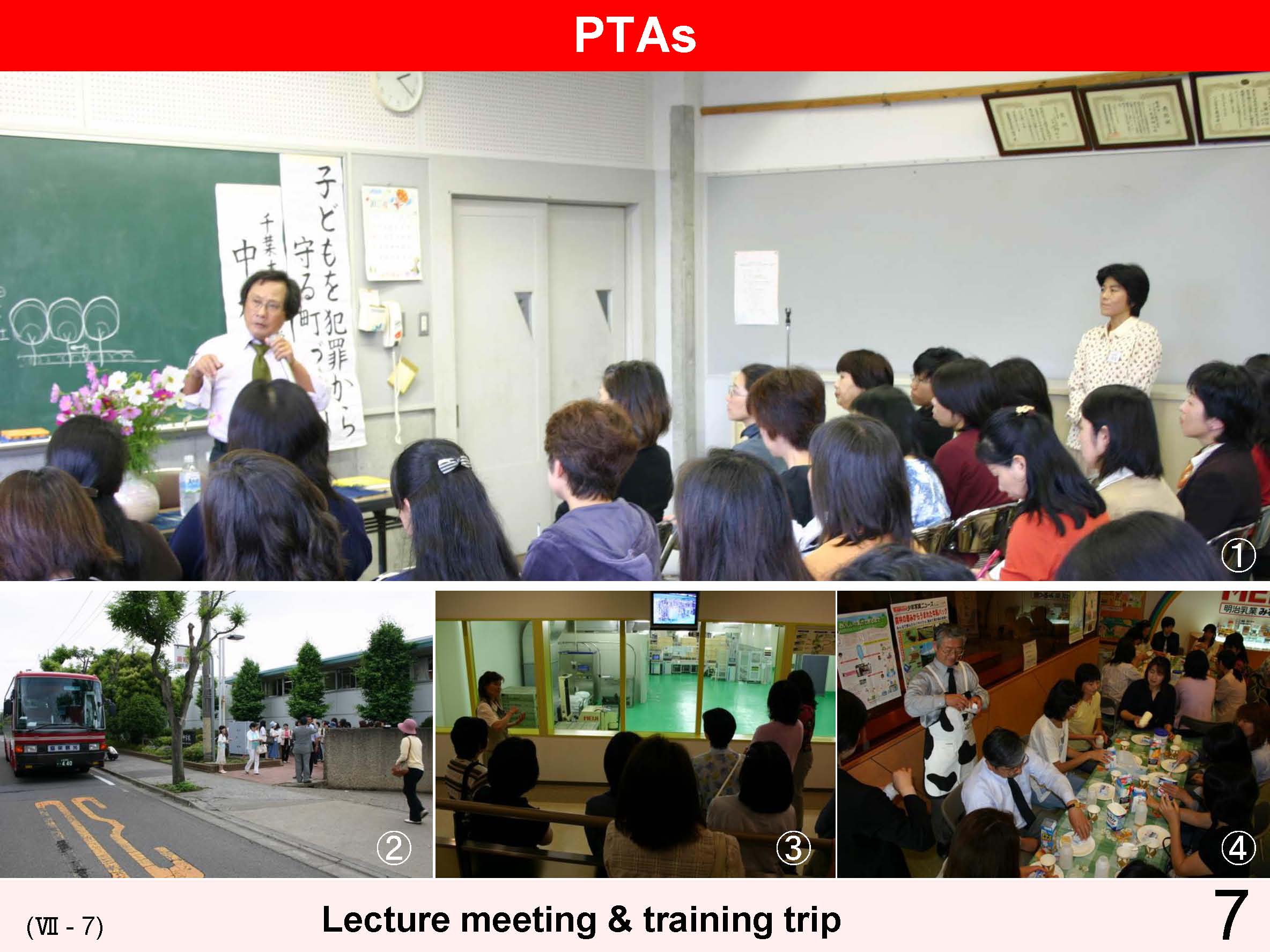 |
(1): A lecture meeting about safety measures is held in an elementary school room. The lecturer is an university professor invited as an expert on this subject. Lecture meetings are managed by the PTA, and school teachers do not get involved. Elementary school, October 2004 (2)(3)(4): shows a study trip that parents and teachers go on together. They visit schools, education facilities and cultural facilities by chartering a bus. In addition to training on educational problems and cultural education, such joint trips help to promote communication and mutual understanding between parents and teachers as well as to deepen their friendship. (2) Start from the lower secondary school. June 2005 (3) Parents are listening to an explanation about a recycling system and watching automatic machines in a beer factory. June 2005 (4) Parents are listening to explanations on how to taste dairy products. The principle participates in this study trip. June 2005 |
| 8 | 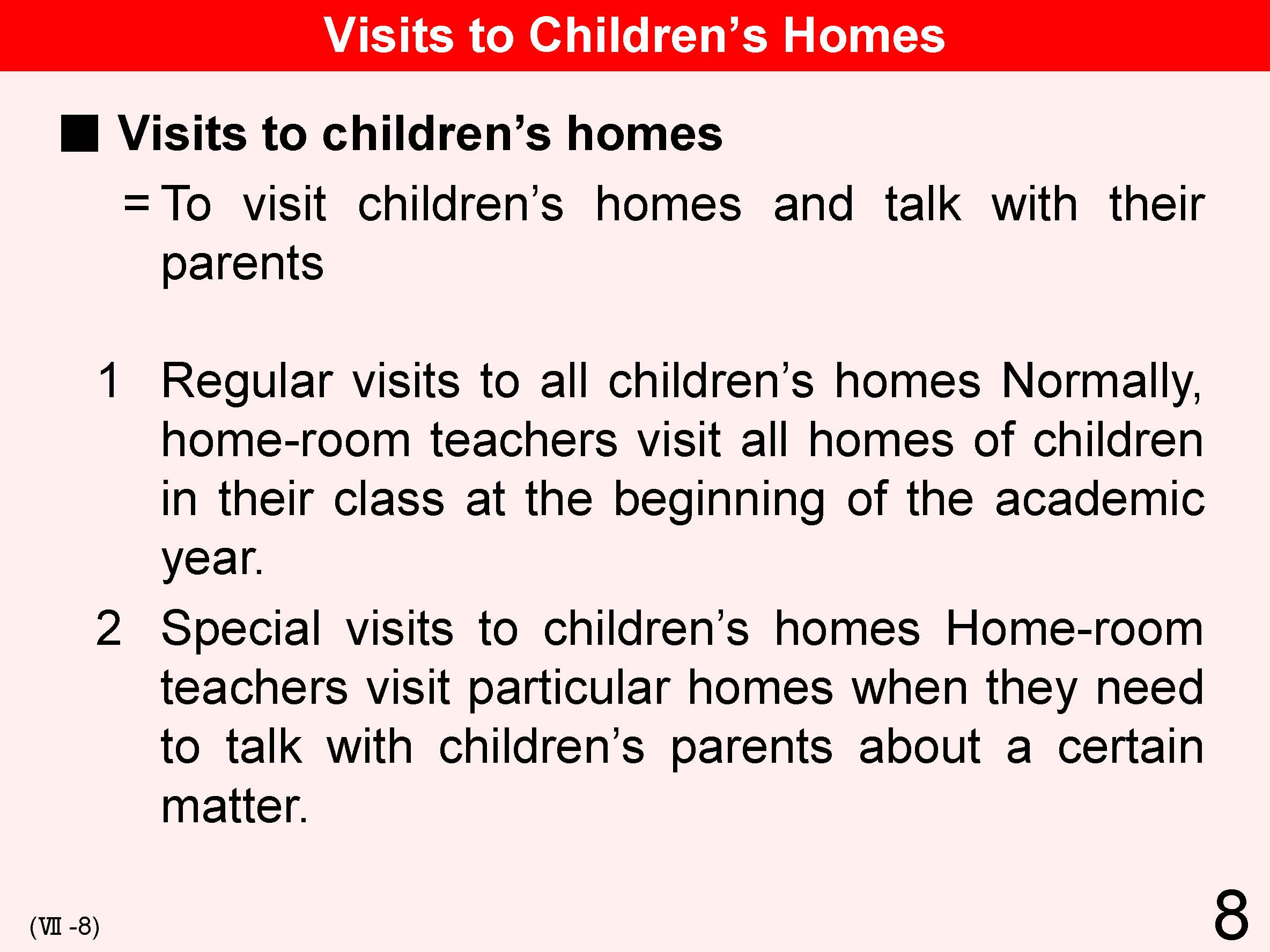 |
Home-room teachers regularly visit their students’ homes and talk with their parents around the beginning of the school year. In addition to regular visits, home-room teachers, guidance teachers and chief teachers also visit students’ homes whenever they think it is necessary, for example, when students have a long-term absence, have troubles or accidents at school and have behavioral problems. In these special cases, it is important for teachers to have a common understanding about students’ problems with their parents, to understand the desires of the parents and to relay the principles and views of the school to the parents. |
| 9 | 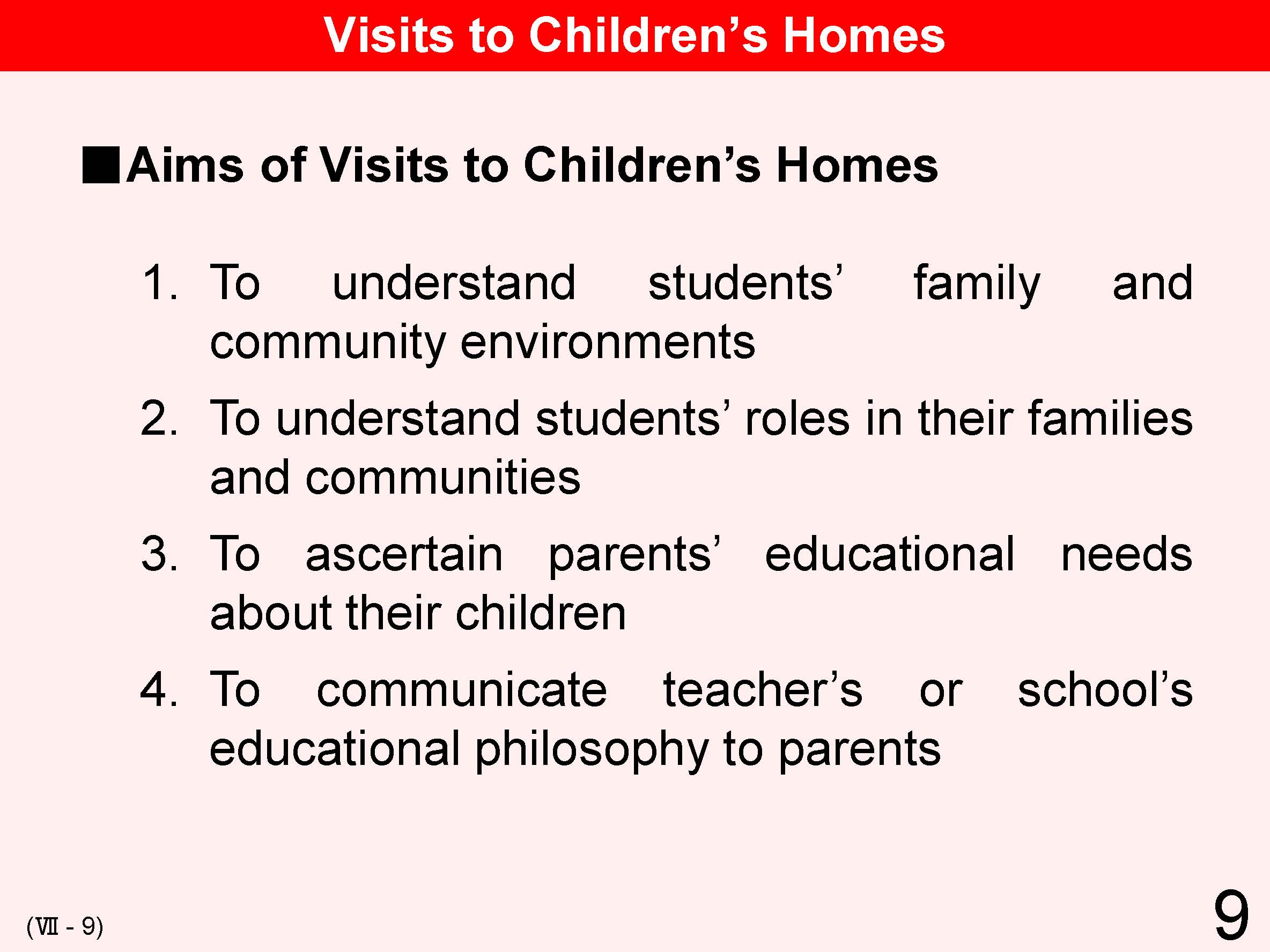 |
Visits to students’ homes by teachers have four aims: (1) to understand students’ family and community environments, (2) to understand students’ roles in their families and communities, (3) to ascertain parents’ educational needs for their children and (4) to communicate teachers’ or schools’ educational philosophy to parents. (Visits to children’s homes --> Ⅴ 31 - 32) |
| 10 | 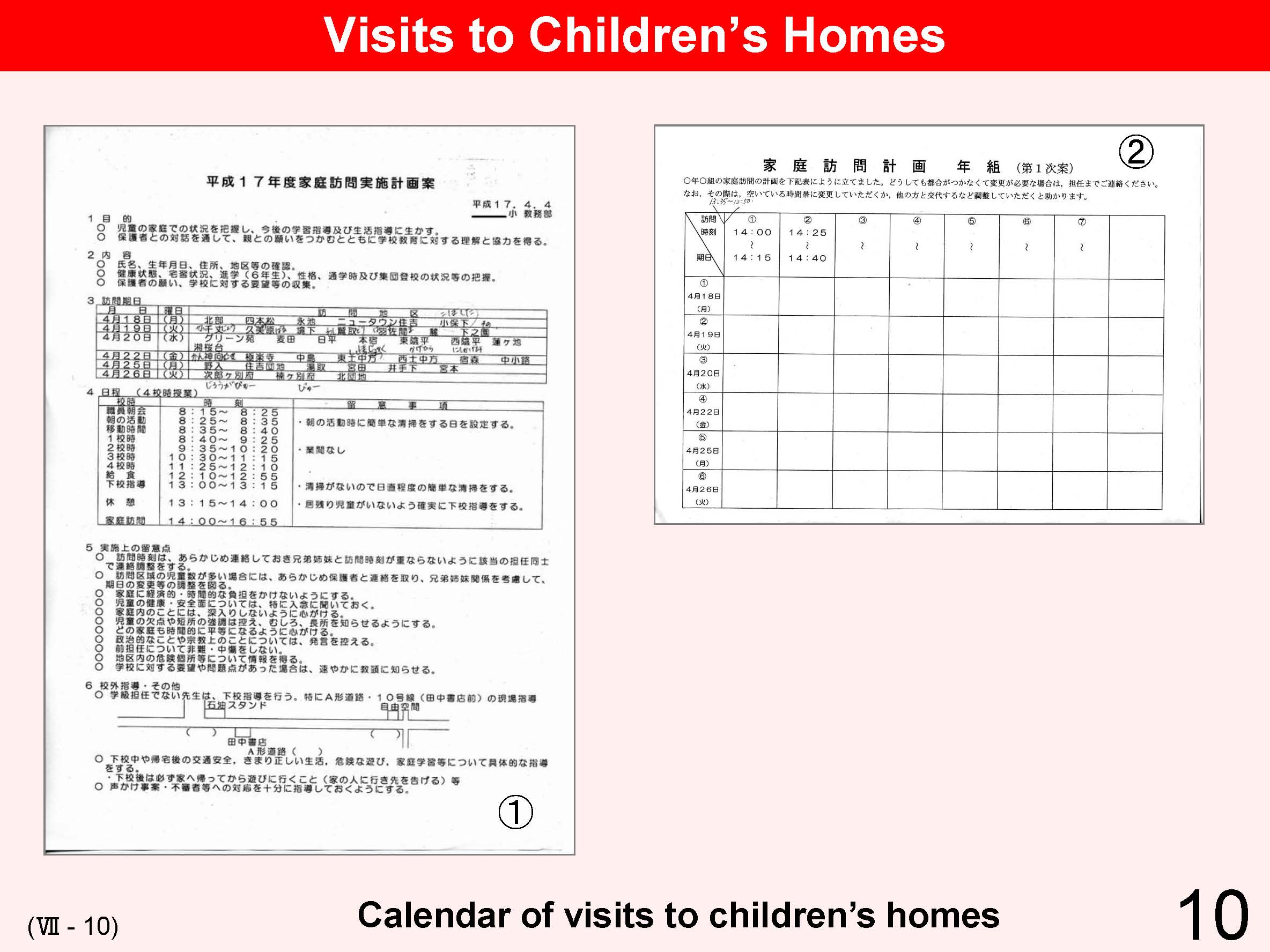 |
During the one to two week period when home-room teachers visit students’ homes to provide guidance at the beginning of the school year, school hours are shortened and club activities are canceled. It is common for teachers to visit a few homes per day in their free time after school. Teachers contact parents and schedule their visit in advance. Teachers also consider the geographical efficiency when visiting students’ homes. (1) Plan for visits to children’s homes (2) Schedule of visits to children’s homes |
| 11 | 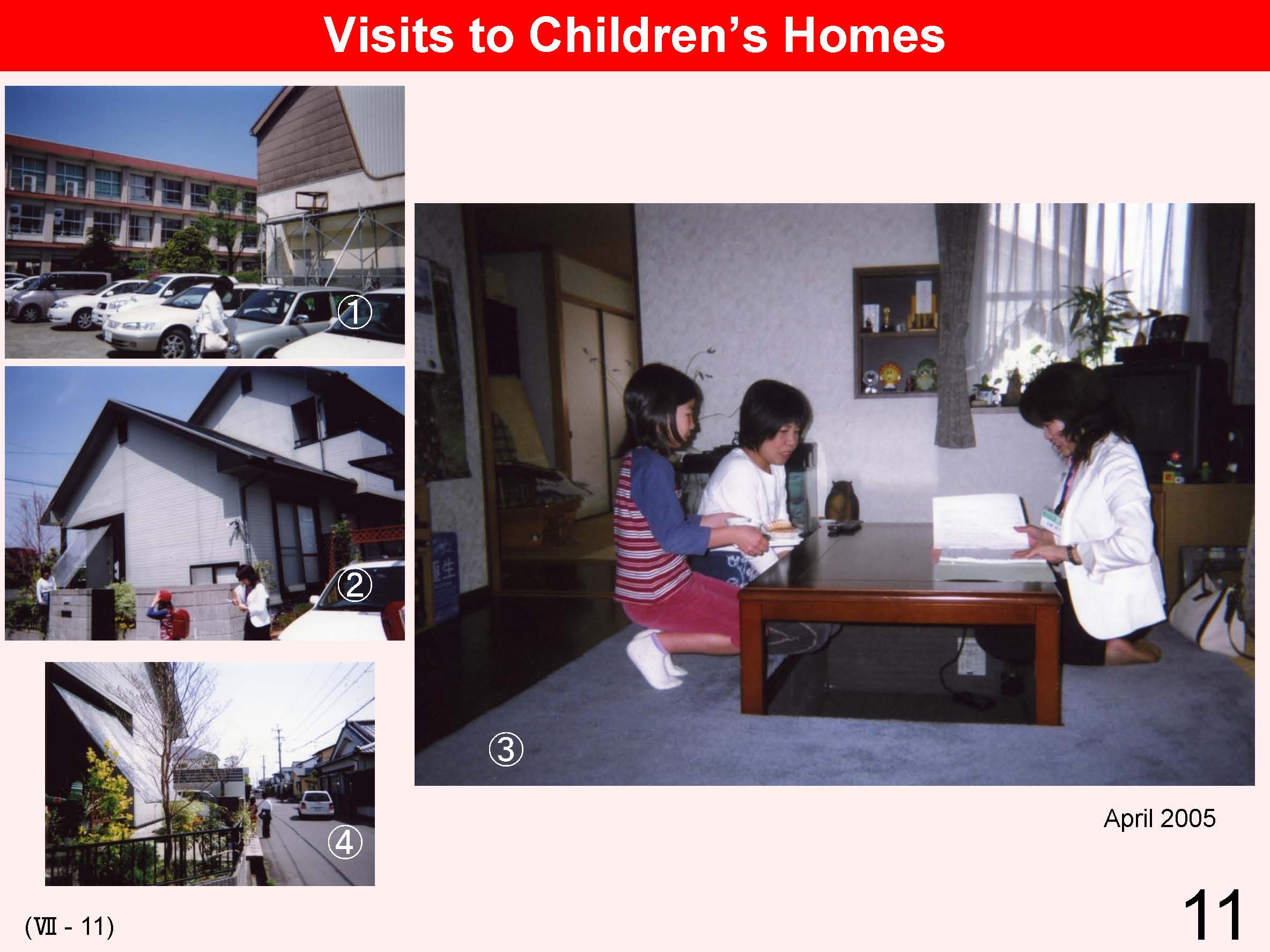 |
On their visits to students’ homes, it is important for home-room teachers to exchange frank opinions with the parents. It is also important not only to ask them about their children’s roles at home and in the community, to solicit parents’ requests, and to convey teachers’ thoughts and views clearly, but also to actually observe the atmosphere in students’ homes and communities, and to learn their characteristics. In situations where students’ families give a special and excessive reception, teachers must refuse it politely. April 2005 (1) Depart from school (2)(3) House of a student (4) Go to next student’s house |
| 12 | 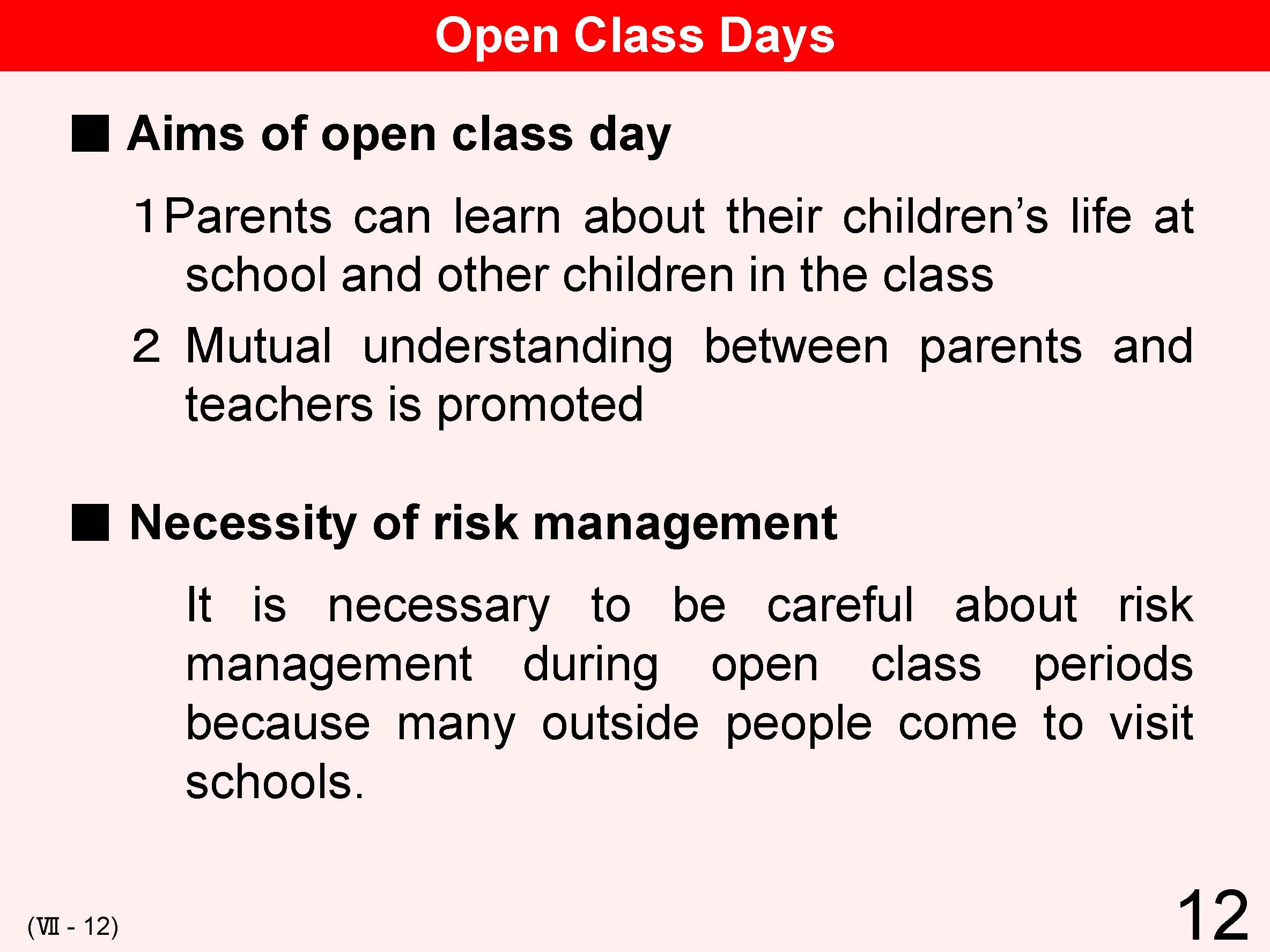 |
The aims of open class days are to inform parents about their children’s life at school and other children in the class, and to promote mutual understanding and cooperation between parents and teachers. It is important to prepare crisis management on an open class day because the presence of many visitors at schools. Therefore, to prevent problems from happening, schools are required to check visitors by asking them to write their names and to wear a badge to show that they are visitors. |
| 13 | 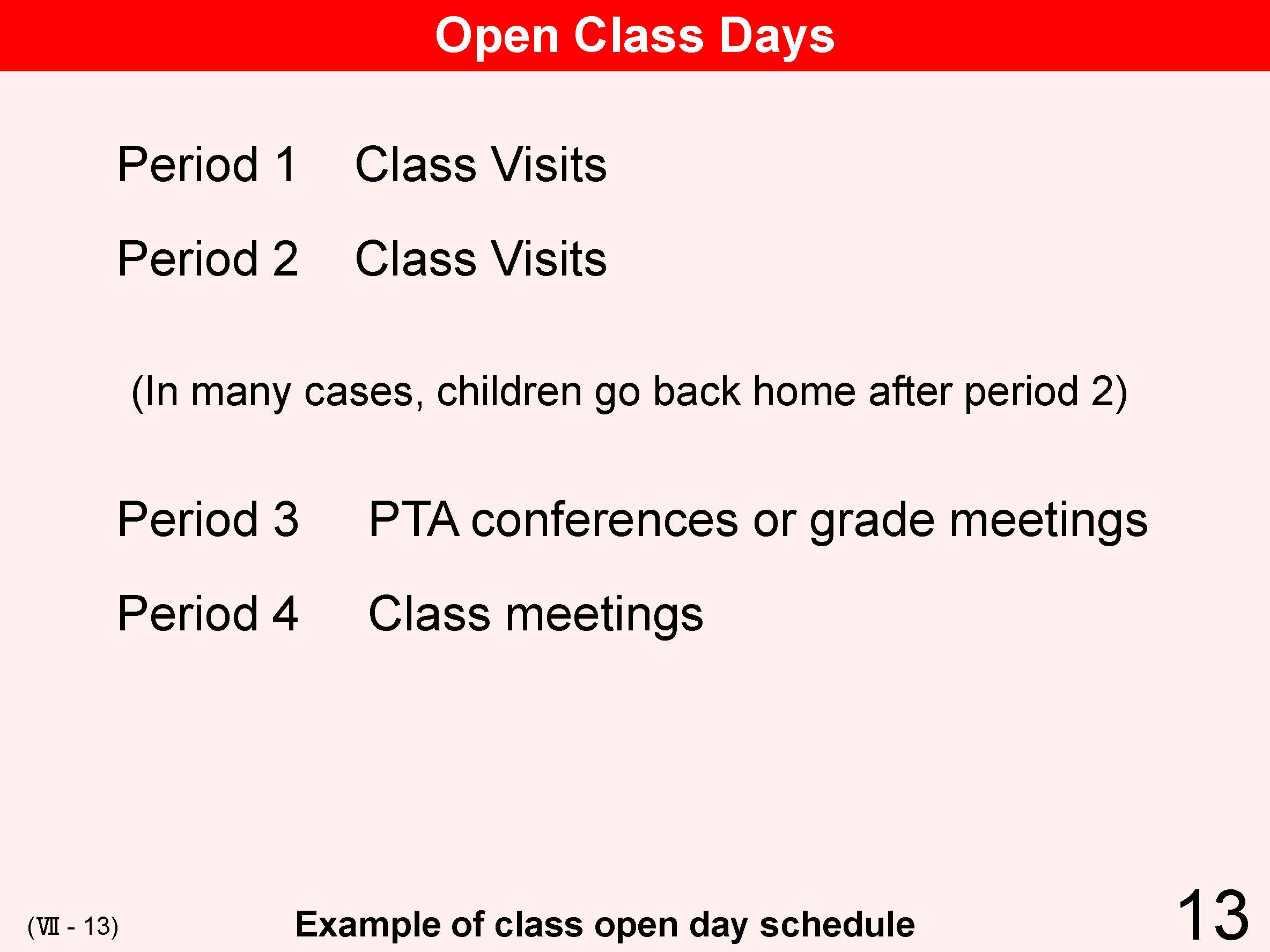 |
Open class days for students’ parents are mostly held once a term at schools. The schools are required to inform the parents of the schedule including subjects being taught on open class day beforehand, including events such as PTA conferences, grade meetings and class meetings which may be held on the same day. When schools hold open class days in which visitors are expected to visit the schools for a certain period of time, schools need to announce open class day objectives and the way to undertake visits widely in and outside the school. When classes are open to local people, the school should provide information on the time schedule of classes and the content of subjects being taught in each class for visitors through newsletters or website. On open class days, it is very crucial to strengthen safety controls by checking visitors at the school entrance and by patrolling on school premises in order to prevent potentially dangerous people from sneaking into the schools. Moreover, It is also important to receive feedback from visitors in order to improve classes and the school in the future. |
| 14 | 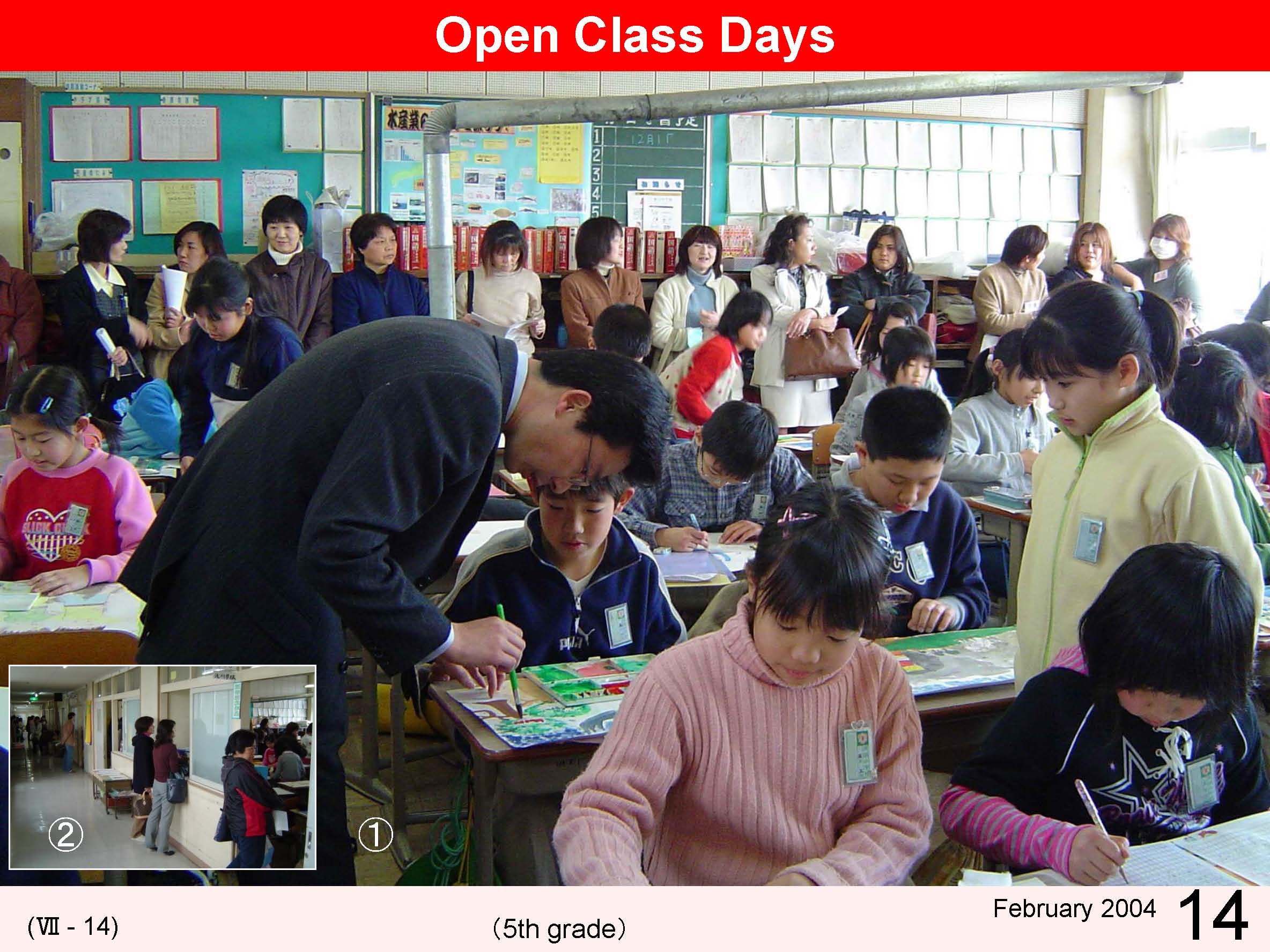 |
Students’ parents observe classes or participate in study activities with their students and teachers on open class days. In the former case, parents generally stand and observe a class from the rear of a classroom. If there are many students and inadequate space in a classroom, open spaces are created for parents. Parental silence is important for classes to proceed so as not to be interrupted or disrupted by parents taking pictures of their children, or recording classes with video cameras or by private chatting. Meanwhile, it is useful for teachers to prepare name lists for parents to check so that homeroom teachers can find which parents are present during open class days. |
| 15 | 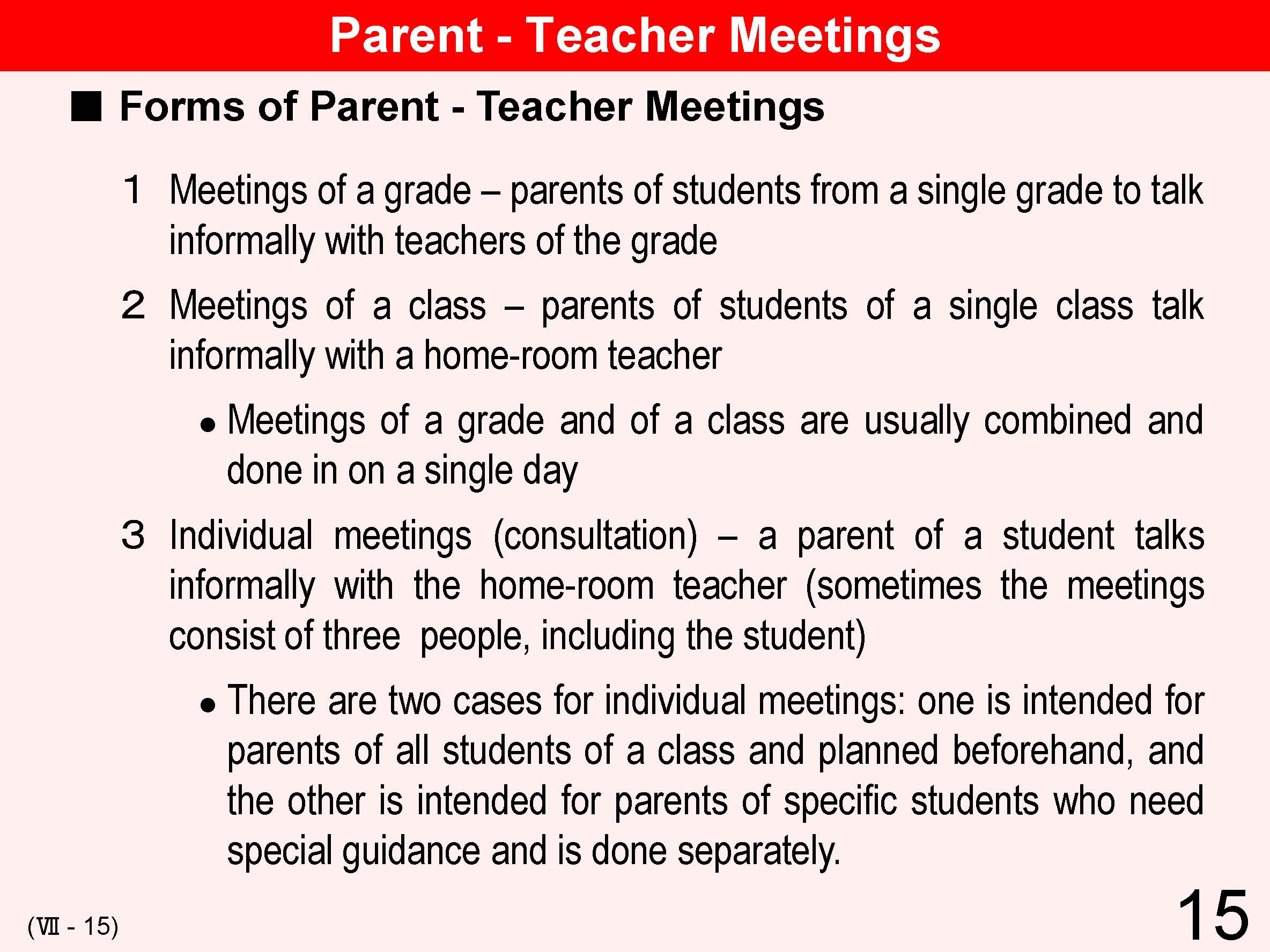 |
Parent-Teacher Meetings provide an opportunity for a teacher and parents to consult directly at school. Teachers may have a meeting with parents of students of whole classes or of whole grades. They may also hold meetings with individual parents (individual meetings), or with individual students and their parents (3-person consultation). Individual meetings and a 3-person consultation are planned beforehand, or may be held when parents are called to schools. Meetings involving whole grades and classes are usually held during open class days. For pre-planned meetings involving individuals / 3-person meetings, teachers clarify the objectives of the meetings and schedule them in advance. |
| 16 | 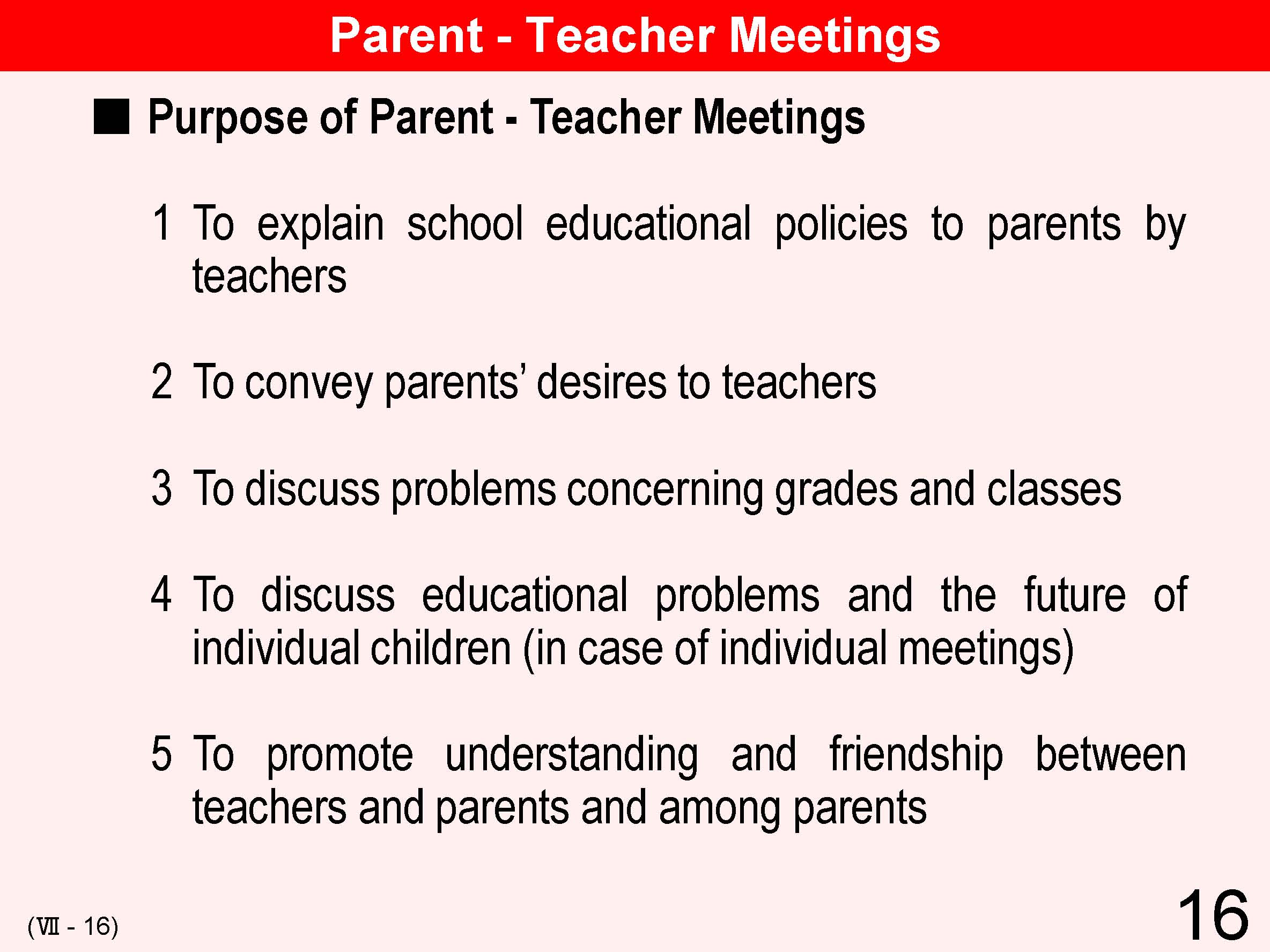 |
At parent-teacher meetings, while teachers explain school educational policies to parents, students’ parents inform leaders, guardians and teachers of their desires. Teachers may discuss problems in grades and classes and school educational problems, and exchange information about these problems. By staging parent-teacher meetings, mutual understanding and friendship can be promoted between teachers and the parents, and between parents. At individual meetings, students’ educational problems and futures are discussed individually and mutual understanding is built. For example, home-room teachers explain specifically about individual student achievements and help to facilitate efforts by the schools to respond to the desires of children and their parents. |
| 17 | 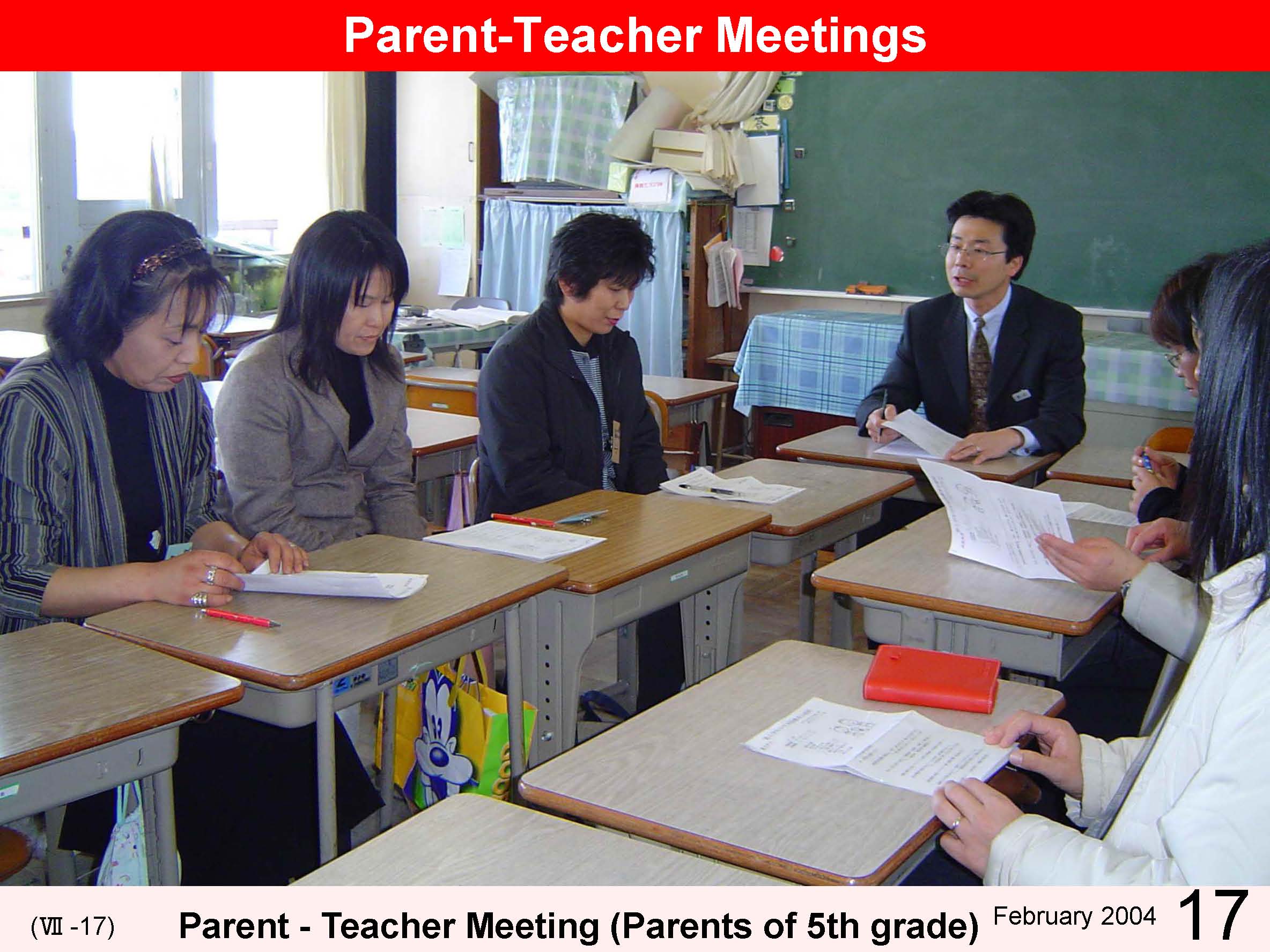 |
A parent-teacher meeting is held on a class open day after parents’ visit to a class |
| 18 | 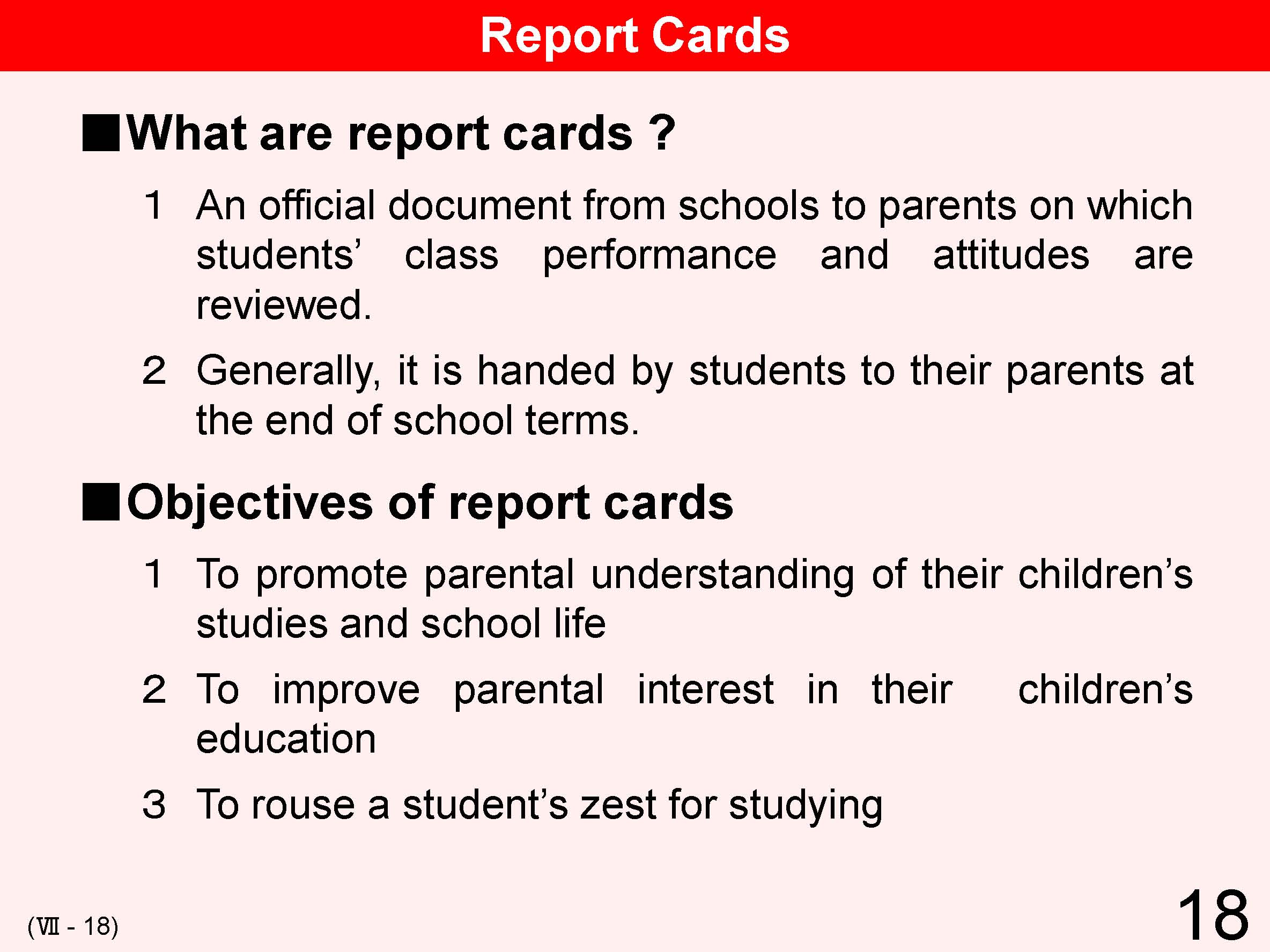 |
Report cards are documents of individual student achievement score and class attitudes made by the school for parents. They are prepared based on standard guidelines such as students’ attendance records, guidance courses and performance results. There is no fixed format in writing a report card. Some schools use their own formats, and others follow regionally fixed formats. Some schools in Japan have no report cards. Instead, opportunities are provided for home-room teachers to explain individual student achievements and attitudes to parents by holding individual meetings at the end of each school term. (Evaluation of students -->Ⅳ 25) |
| 19 | 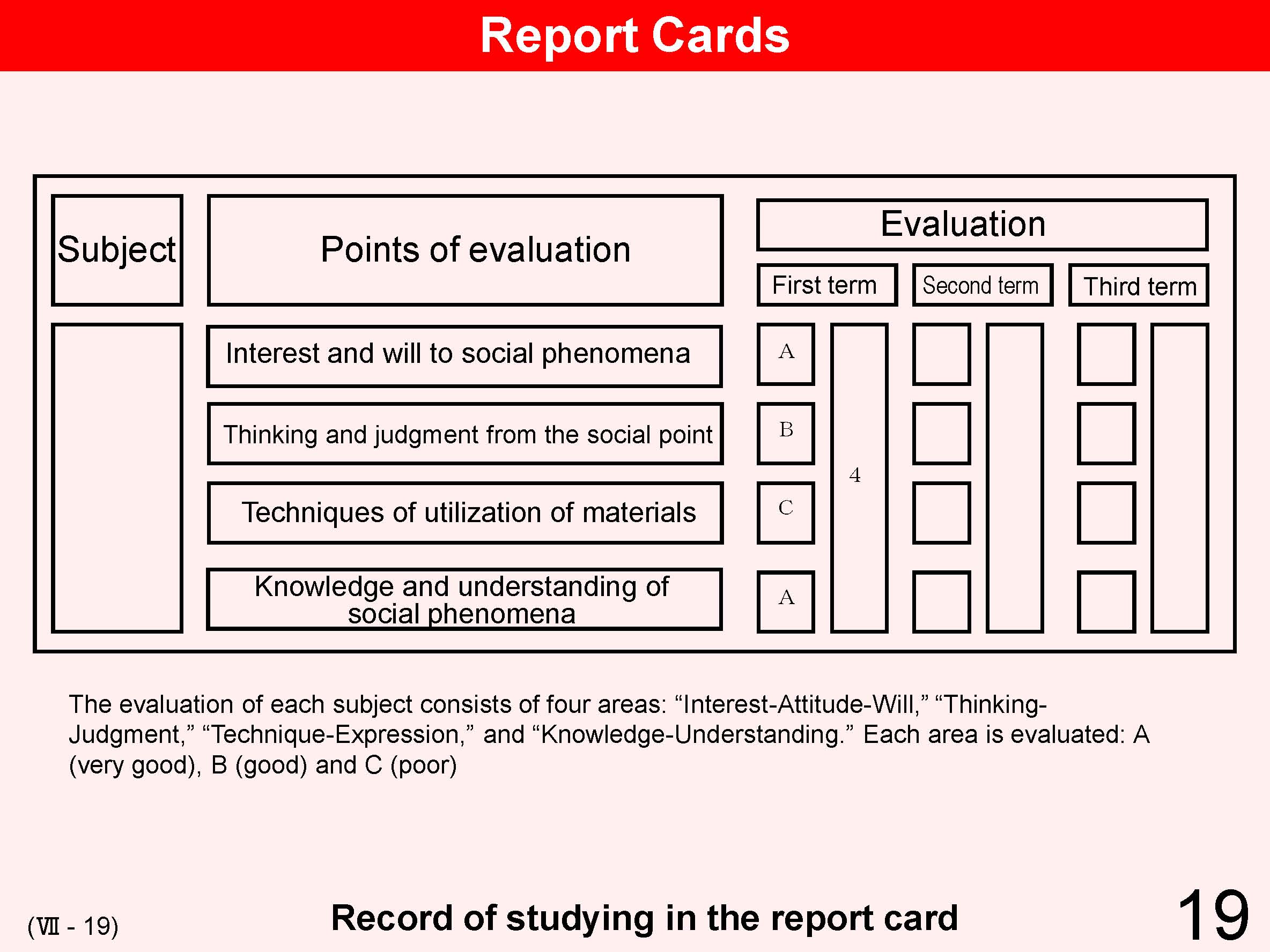 |
On a report card, (1) Evaluations of each subject taken, (2) Reports about the period of integrated study are also written. The evaluations of each subject are absolute evaluations. |
| 20 | 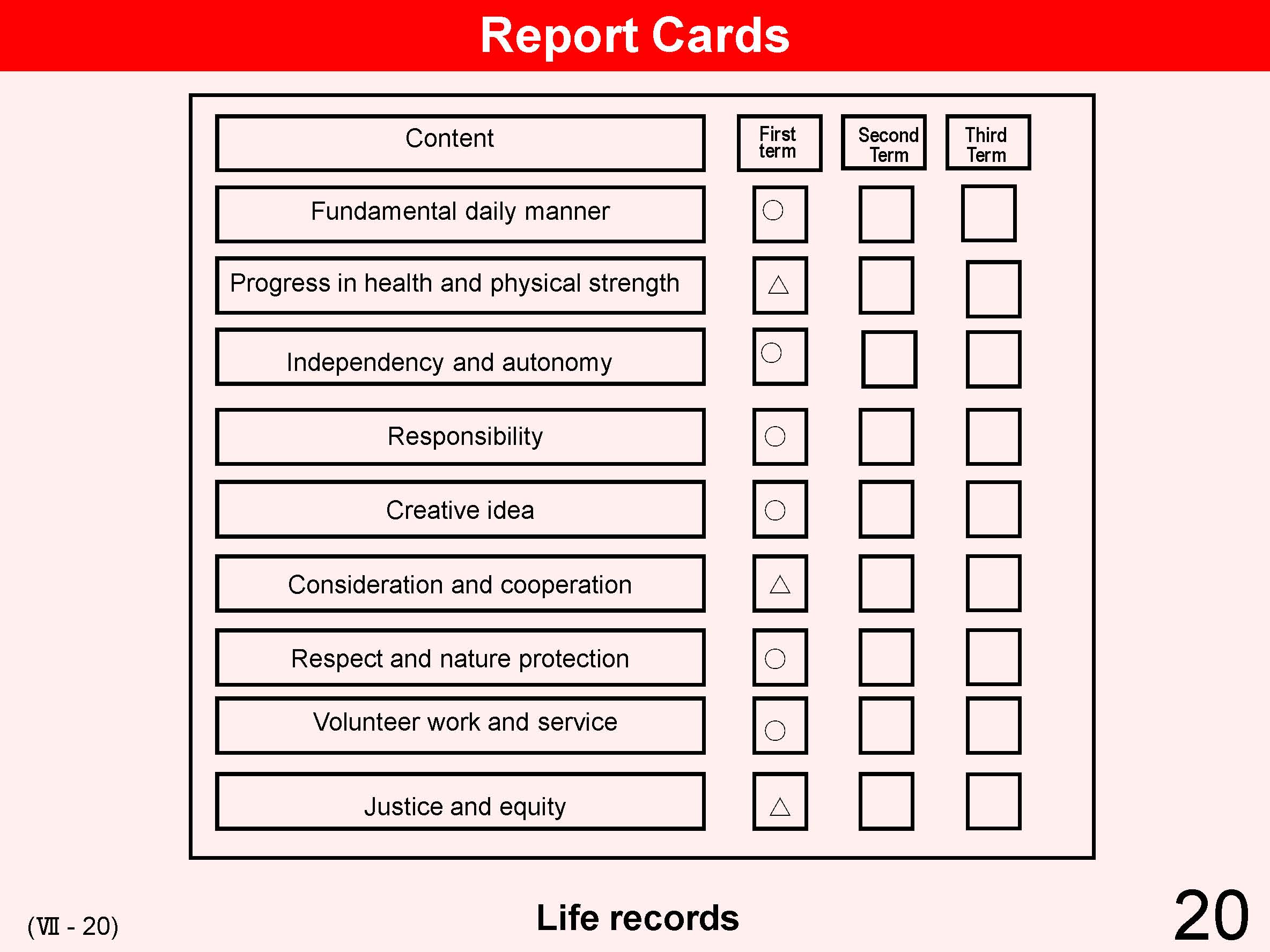 |
A life record includes children's behavior and attitude at school, records of special activities, attendance, and comprehensive evaluations. Report cards are prepared by home-room teachers, approved by a principals, and handed over to individual students. Parents seal the report cards after checking them. |
| 21 | 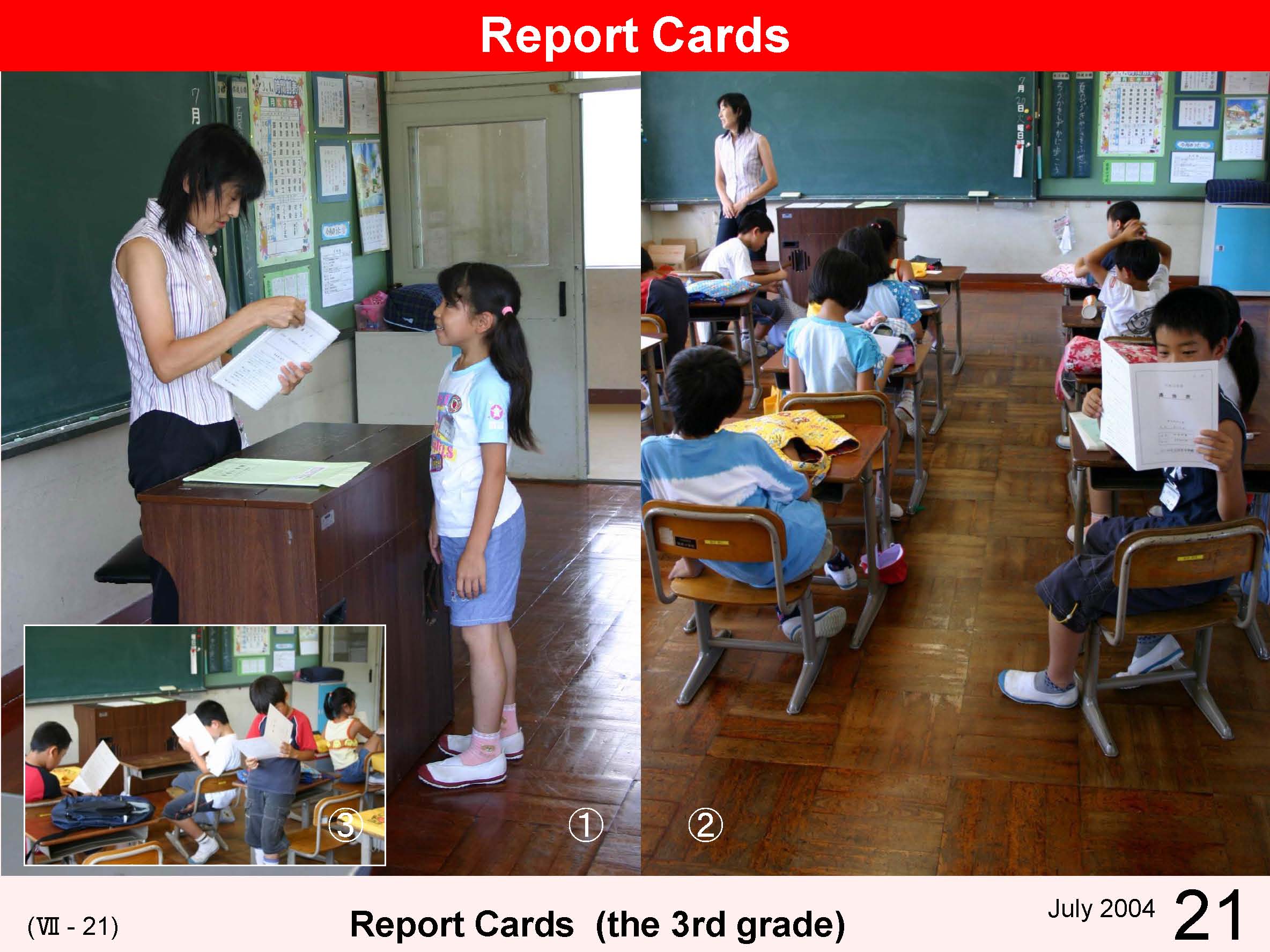 |
Students and their parents tend to be concerned about superficial evaluations of students written on report cards. There is always a need to respond to point out strengths and progress of individual students, indicating areas and leeway for improvements. It is also important to inform parents about the intent of the report cards and how to read them. This school shows student’s evaluations occurring ○ in the first and second grades, and at levels of 1, 2, 3 from the third grade. |
| 22 | 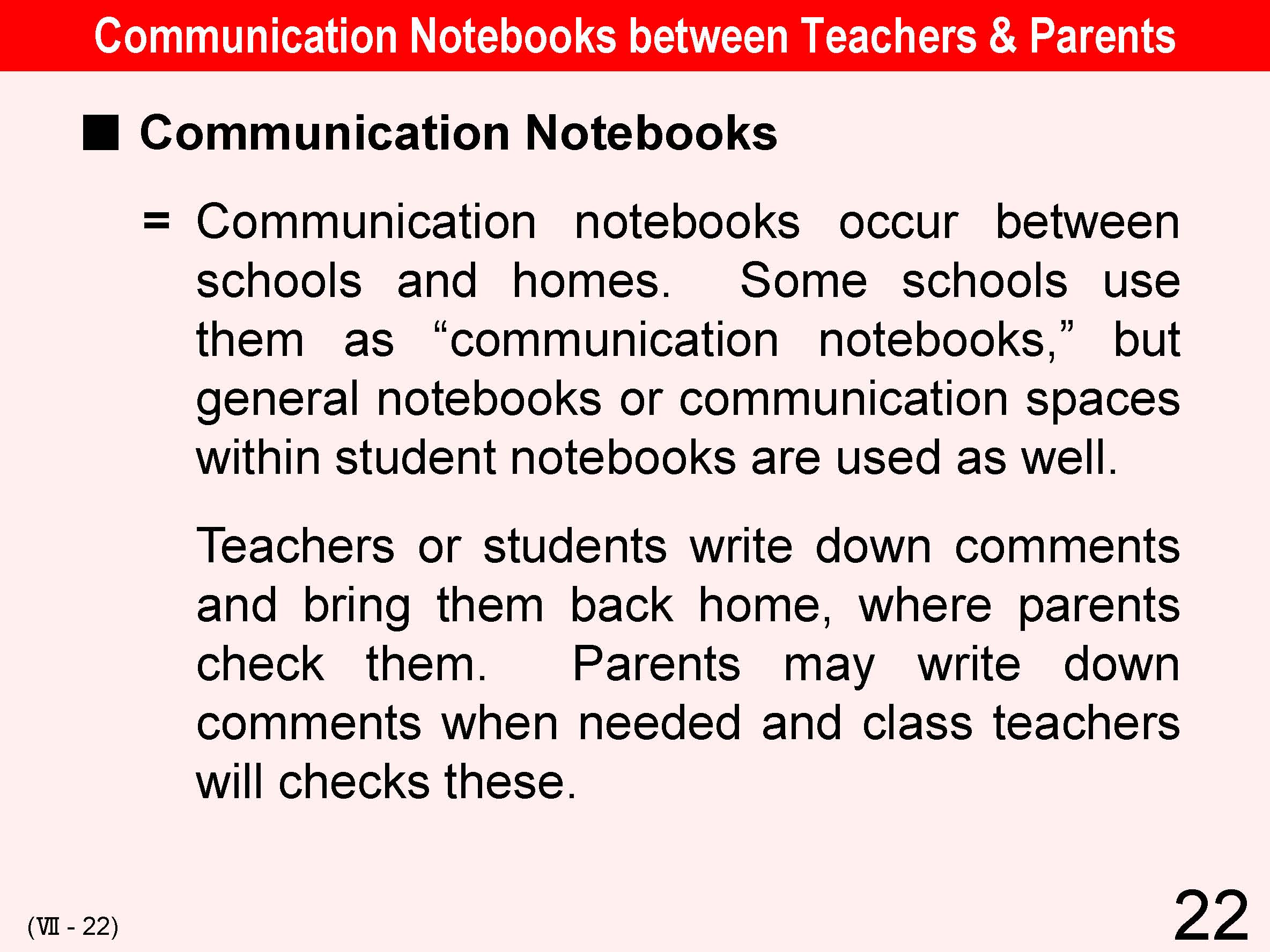 |
Communication notebooks between teachers and parents are designed to smoothen two-way communication between schools and students’ homes. They are used especially for lower grades in elementary schools. Students themselves transcribe daily notes in their notebooks based on what their home-room teachers write on blackboard for students to copy. At the beginning of the 1st grade when students cannot write letters, they paste a piece of paper with tomorrow’s schedule written down on a communication notebook. For comments for individual students, teachers will write them down on the notebooks directly. Later at home, parents check the notebooks, sign them, and then write down requests or messages to the teachers. When students go to school the next day, the home-room teachers checks the comments in their notebooks. |
| 23 | 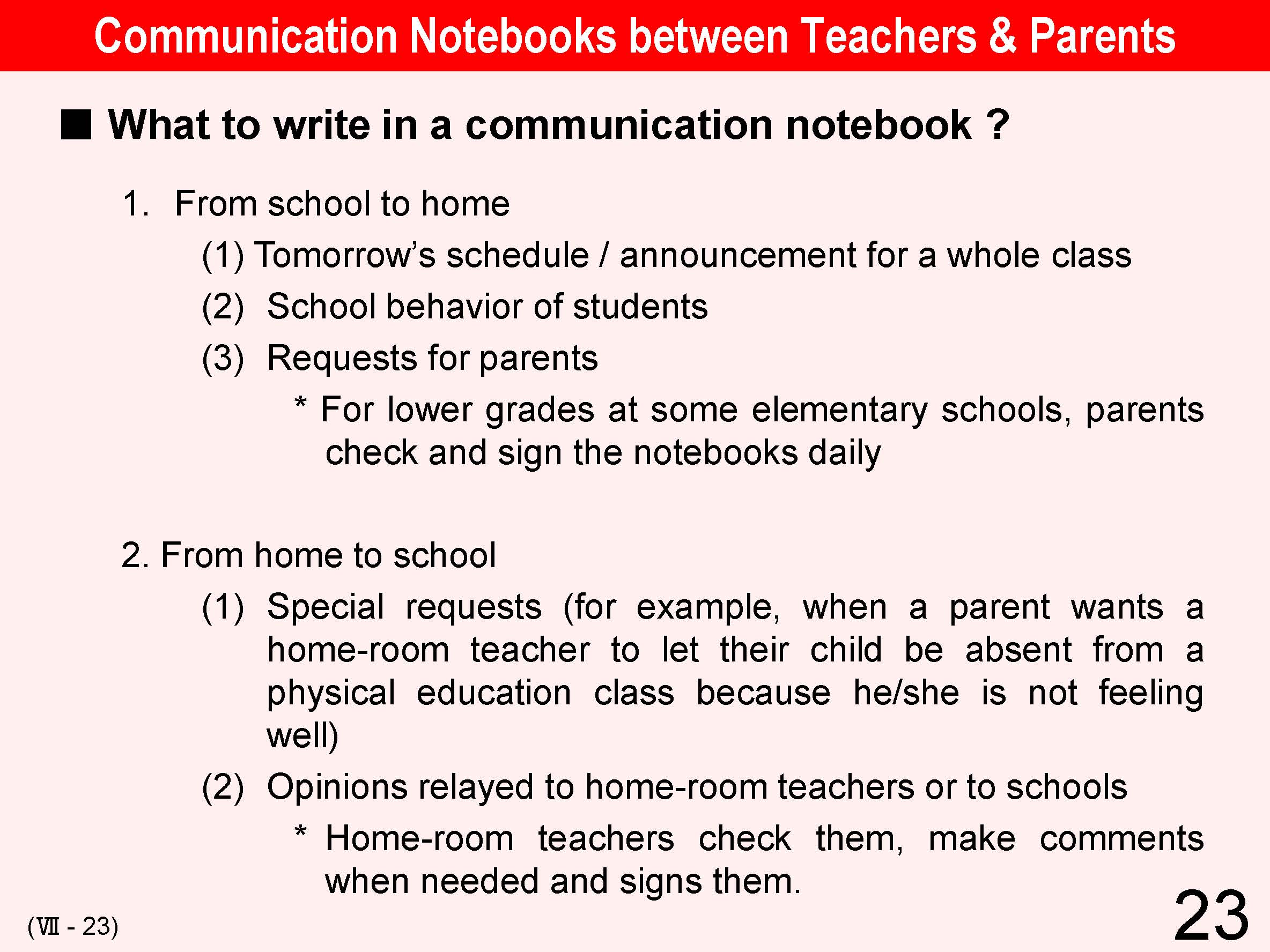 |
|
| 24 | 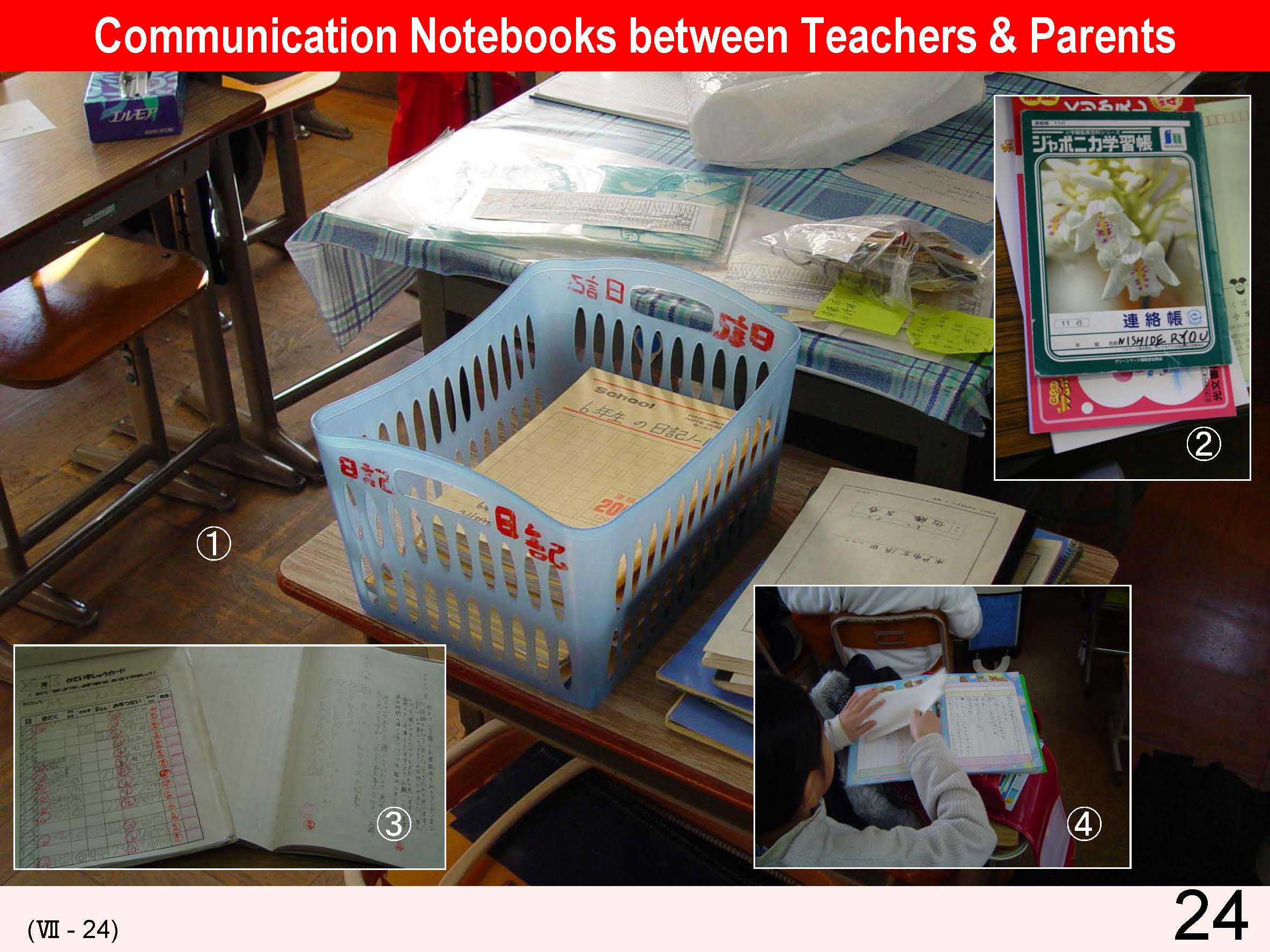 |
There is not a fixed model of a communication notebook system between teachers and parents. Notebooks are sold as communication notebooks and they have columns to put down a date, content, and a signature. (1) 6th grade, December 2003 (2) 6th grade, January 2005 (3) 2nd grade, December 2003 (4) 3rd grade, January 2005 |
| 25 | 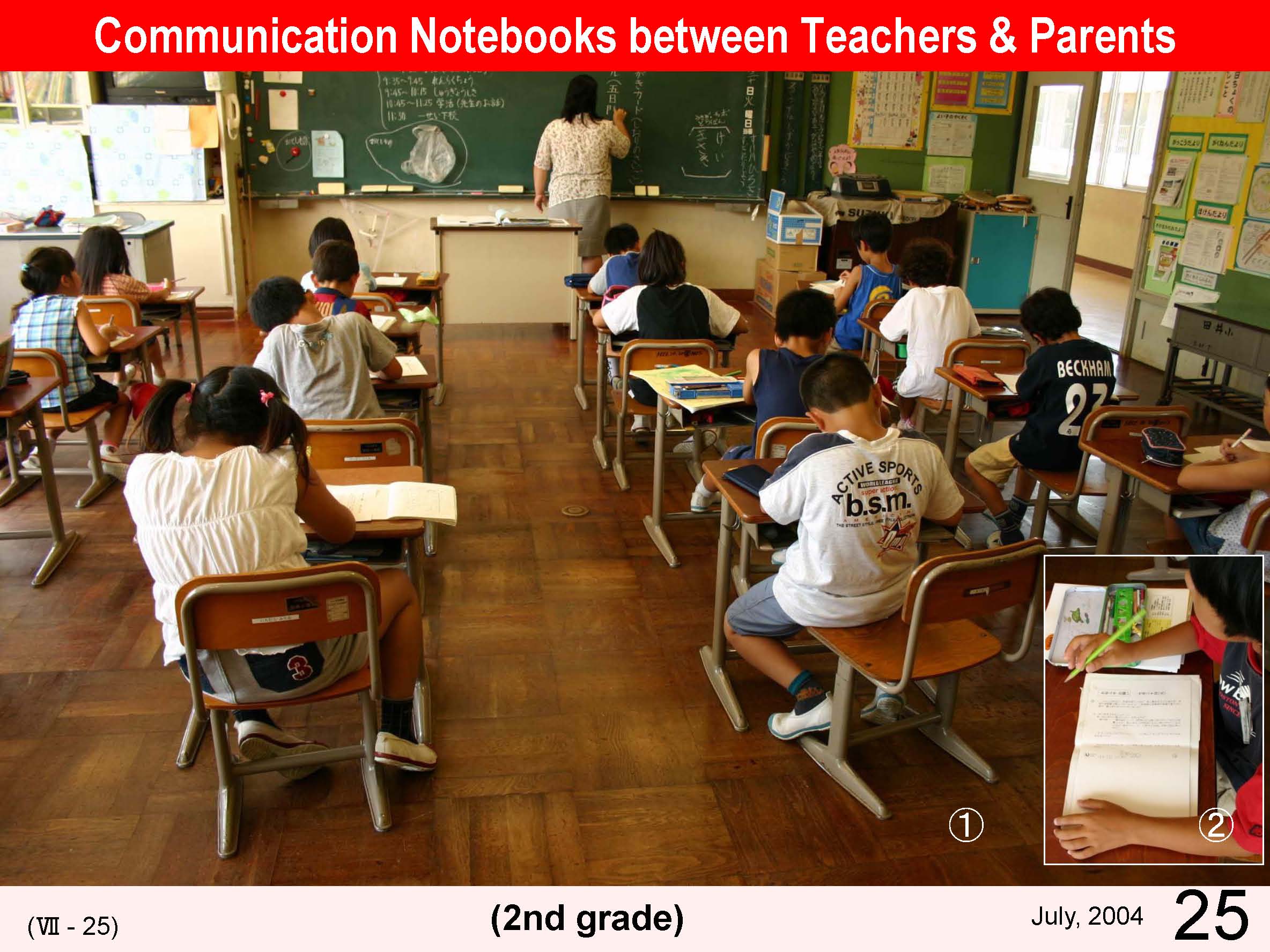 |
During “meeting” hours, students copy notes given by teachers on their “communication notebooks.” At home, they check the notes and ask their parents to write return notes to the teachers and schools. In this elementary school, students either paste notes printed on their notebook, or write them in. |
| 26 | 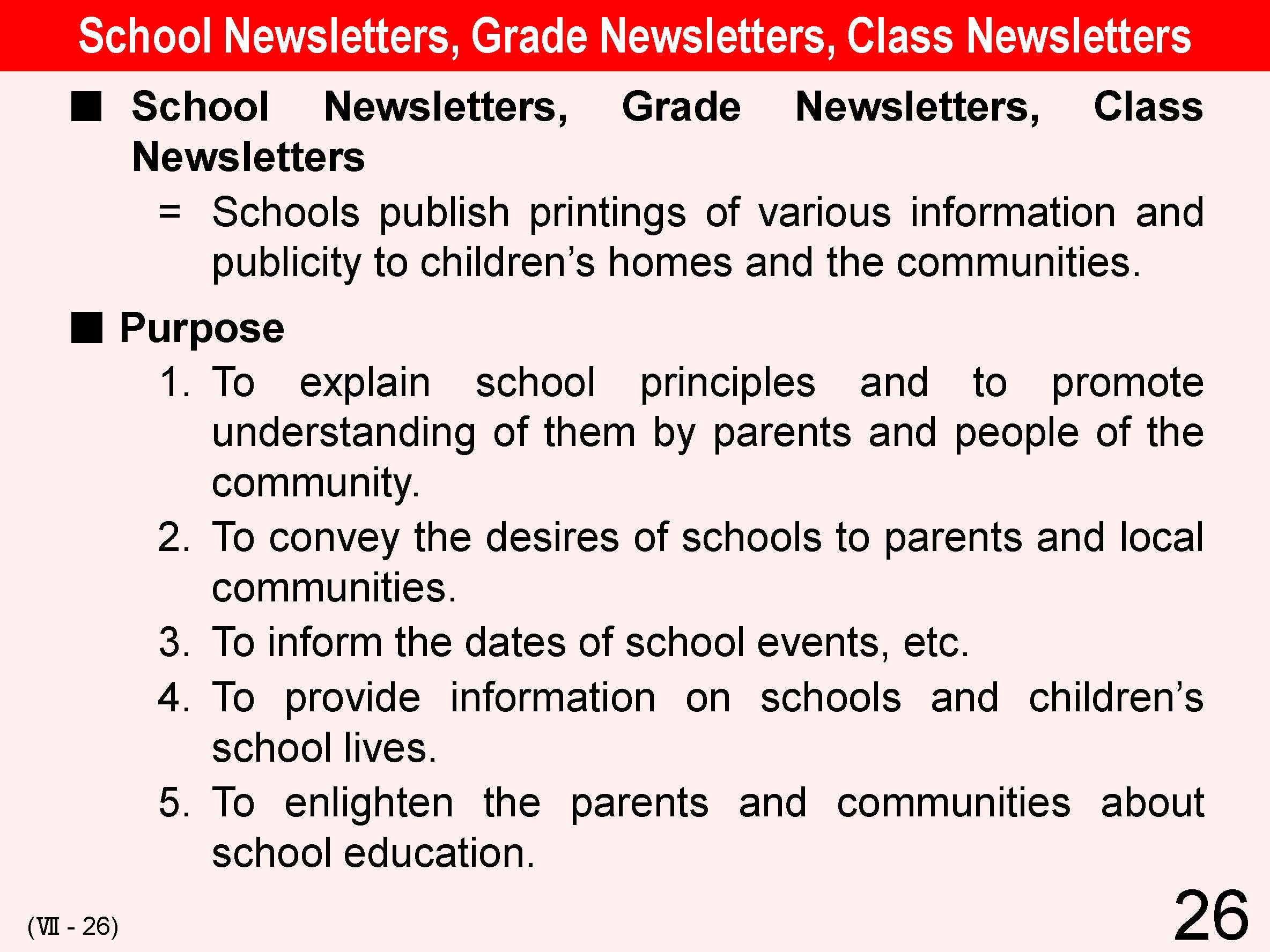 |
Schools regularly publish several different kinds of newsletters for students’ parents (per term, monthly, or weekly) by using word processors or hand-writing. After newsletters are complete, they are handed out by students. They are useful in informing parents of school plans, policies and various activities, and help parents to understand school policies and activities and to cooperate with the schools. |
| 27 | 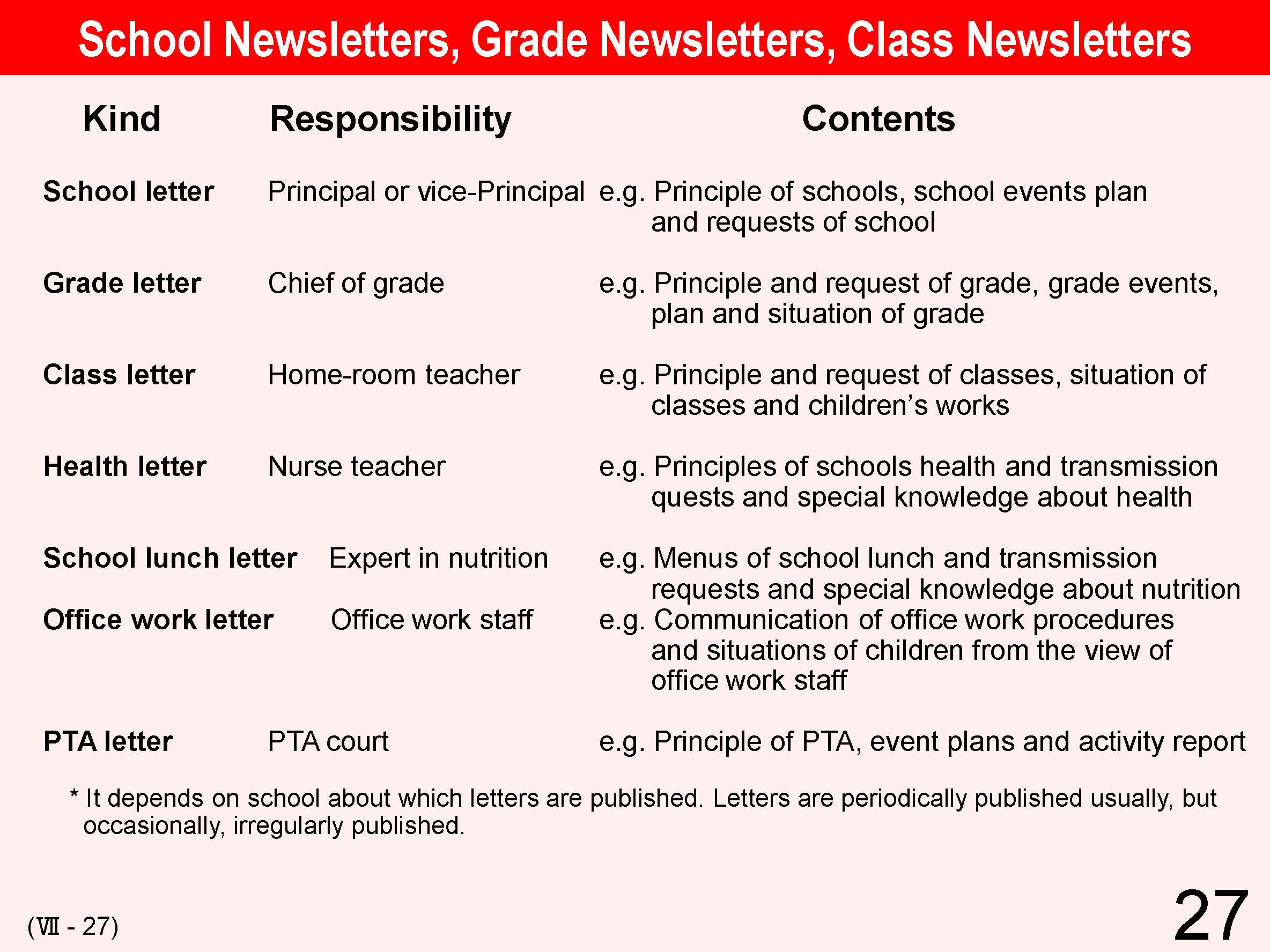 |
Newsletters are published at multiple levels such as schools, grades and classes and at offices such as nurseries, school lunch area and administrative offices. The publication of newsletters depends on individual schools. School letters are distributed to all students’ homes, and occasionally are circulated among homes, or posted on bulletin boards inside the school premises. |
| 28 | 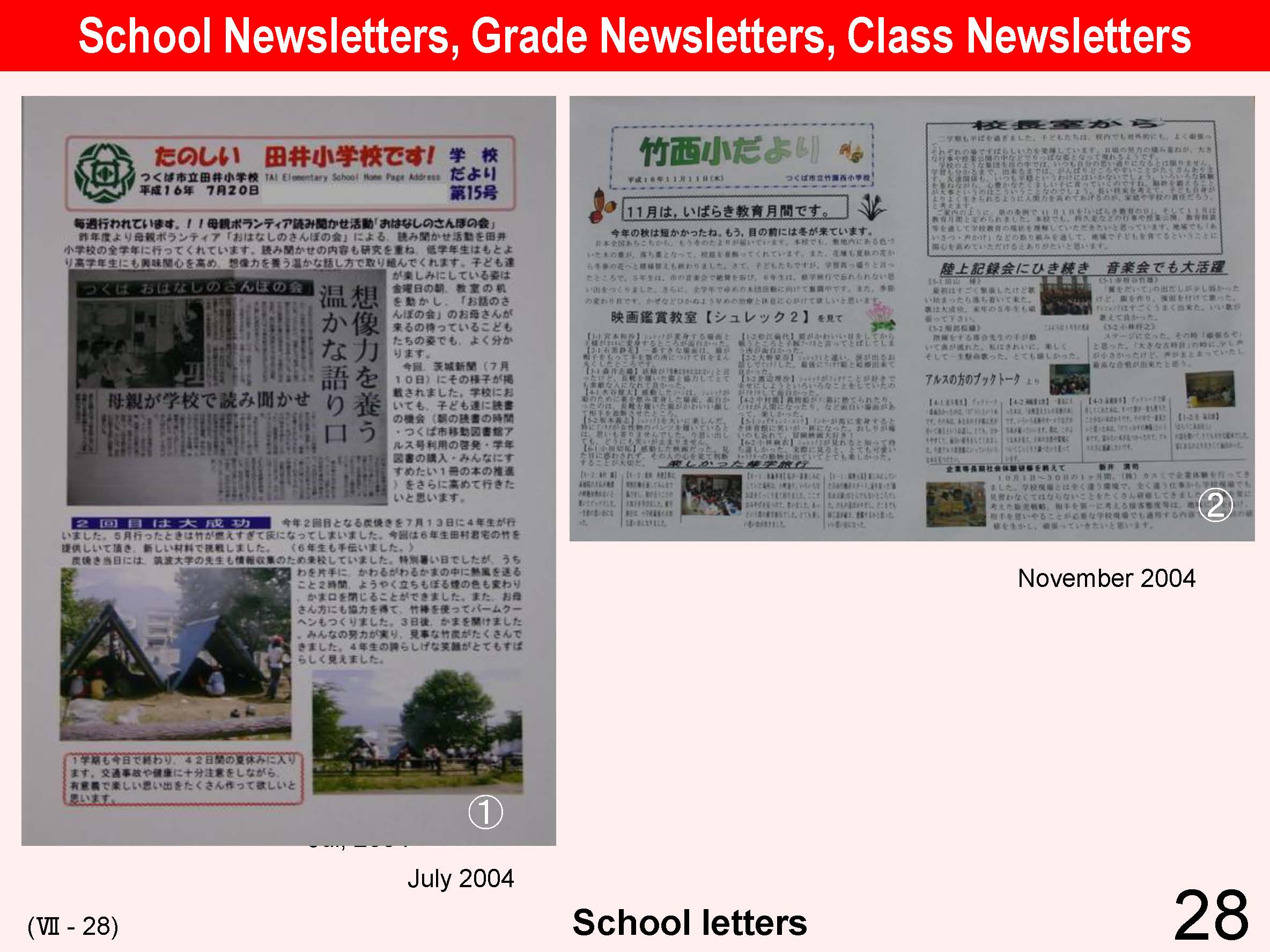 |
(1) School newsletter: school events and contents of curriculum are reported. September 2004 (2) School newsletter: school events and contents of curriculum are reported. November 2004 |
| 29 | 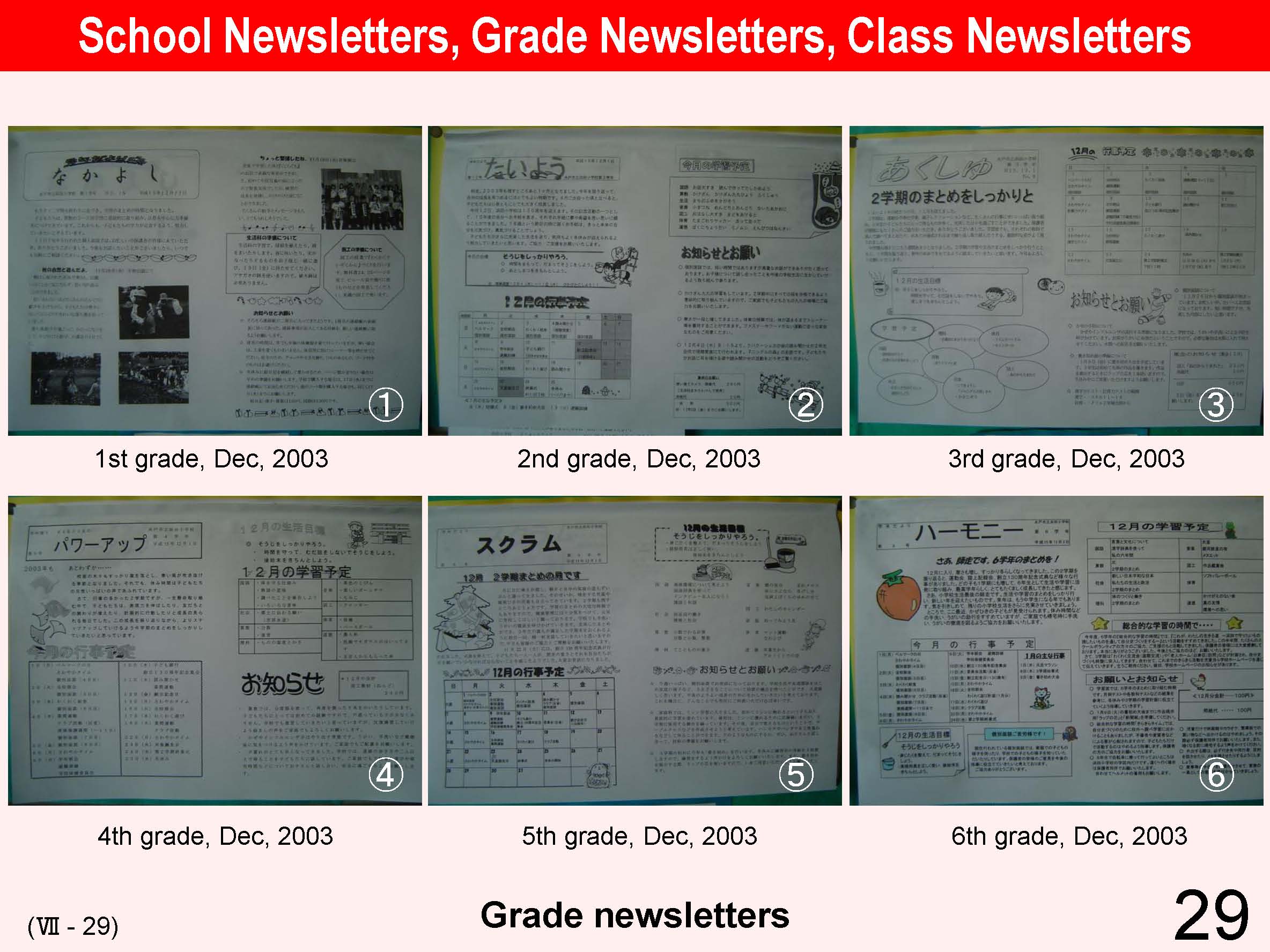 |
Grade newsletter: Newsletter of each grade has a distinct title. (1)1st grade = Friends (2)2nd grade = The sun (3)3rd grade = Shaking hands (4)4th grade = Power up (5)5th grade = Scrum (6)6th grade = Harmony |
| 30 | 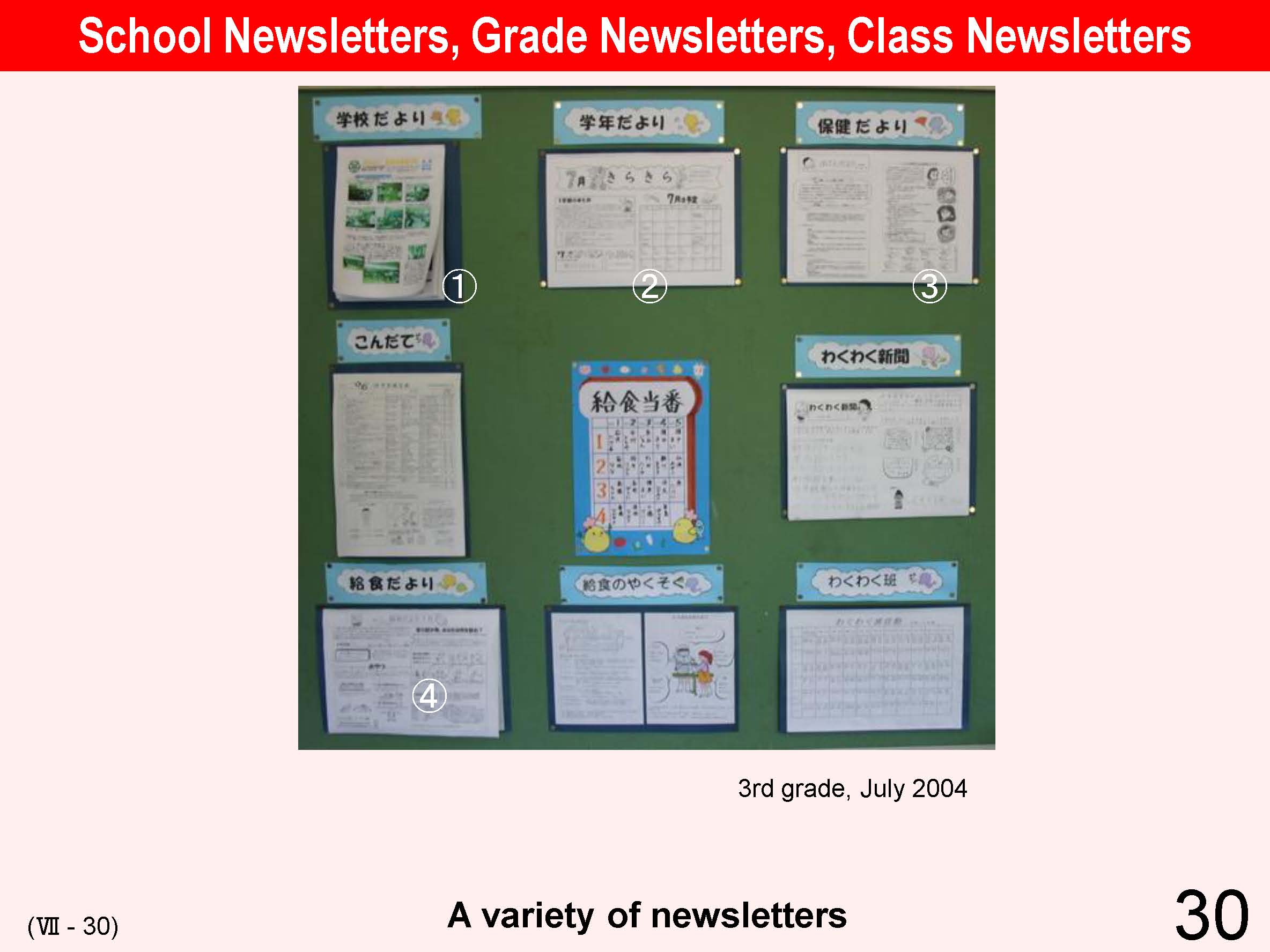 |
(1)School news (2)Grade news (3)School health news (4)School-lunch news |
| 31 | 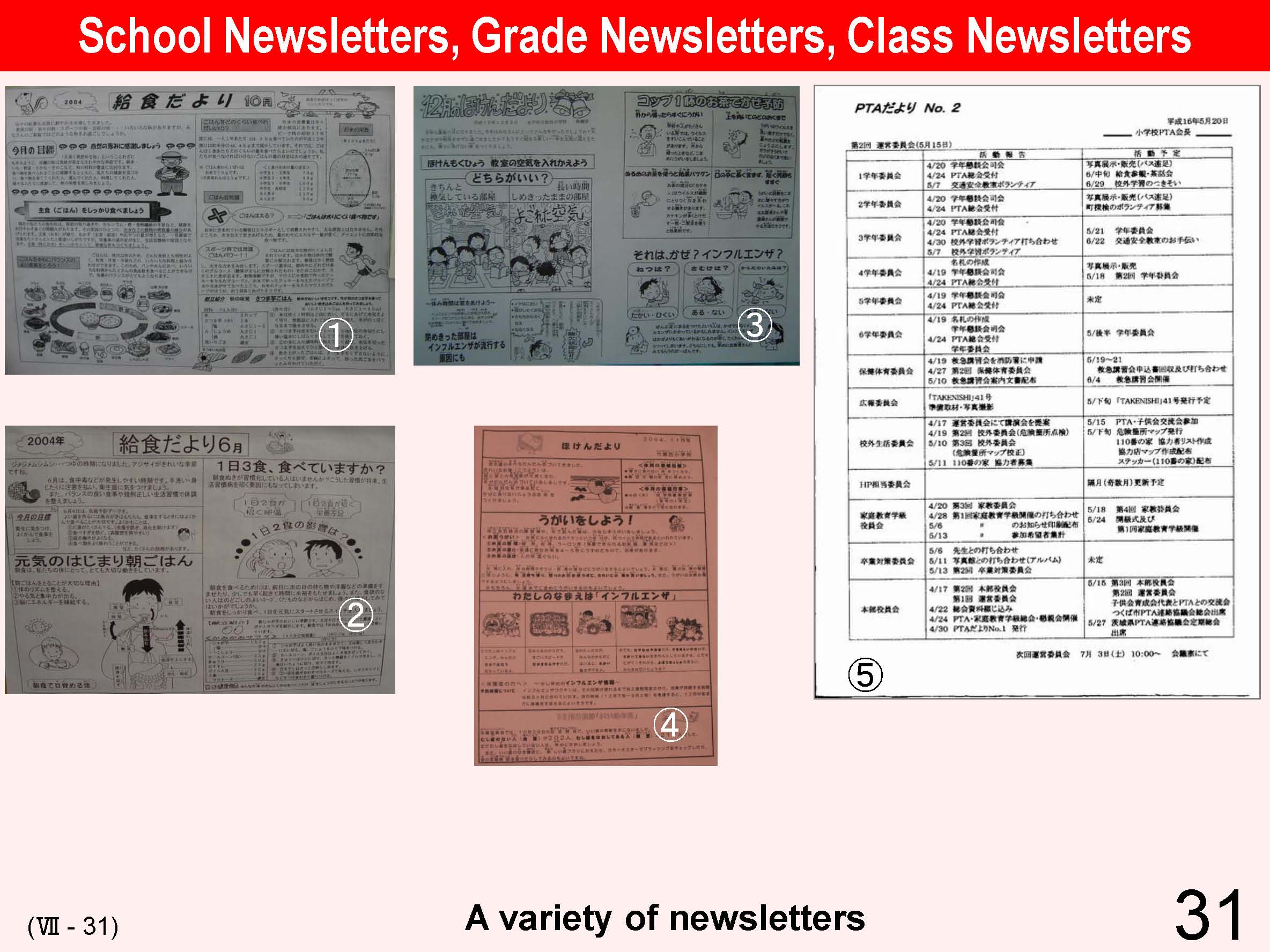 |
(1)School-lunch news, October 2003 (2)School-lunch news, October 2004 (3)School health news, November 2003 (4)School health news, November 2003 (5)PTA news, July 2004 (6)PTA news, May 2004 |
| 32 | 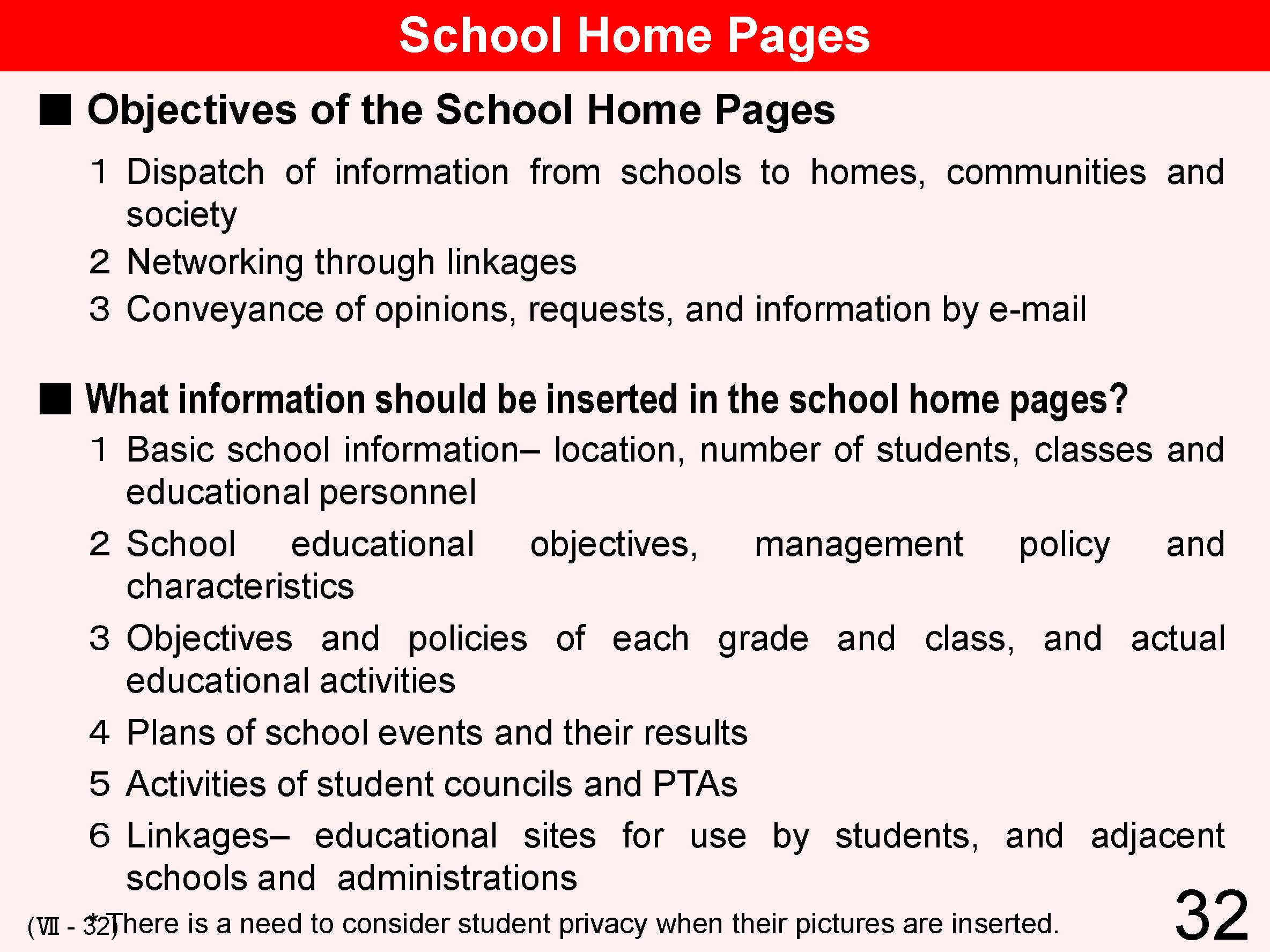 |
An expanding number of schools now set up their own home pages on websites. Home pages are an effective way not only to contact parents, but also to handle school accountability functions, to develop communication networks through linkages and to get information through e-mails. On school home pages schools insert school summary data, characteristics, plans, and actual individual school activities. |
| 33 | 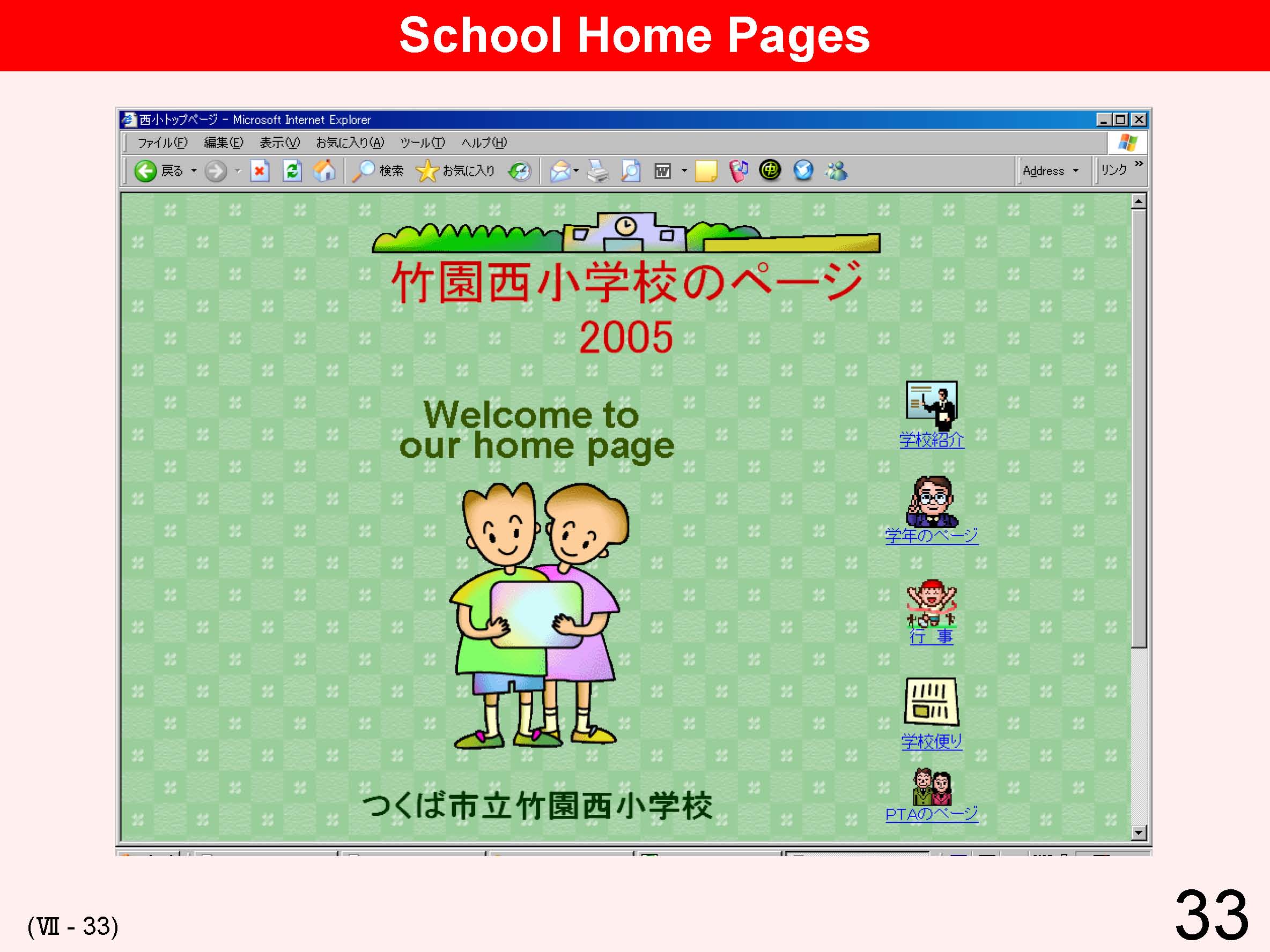 |
This is an example of an elementary school’s homepage. It is important to organize information appropriately and to present it so that it can be read easily. It also is necessary to update the information daily. |
| 34 | 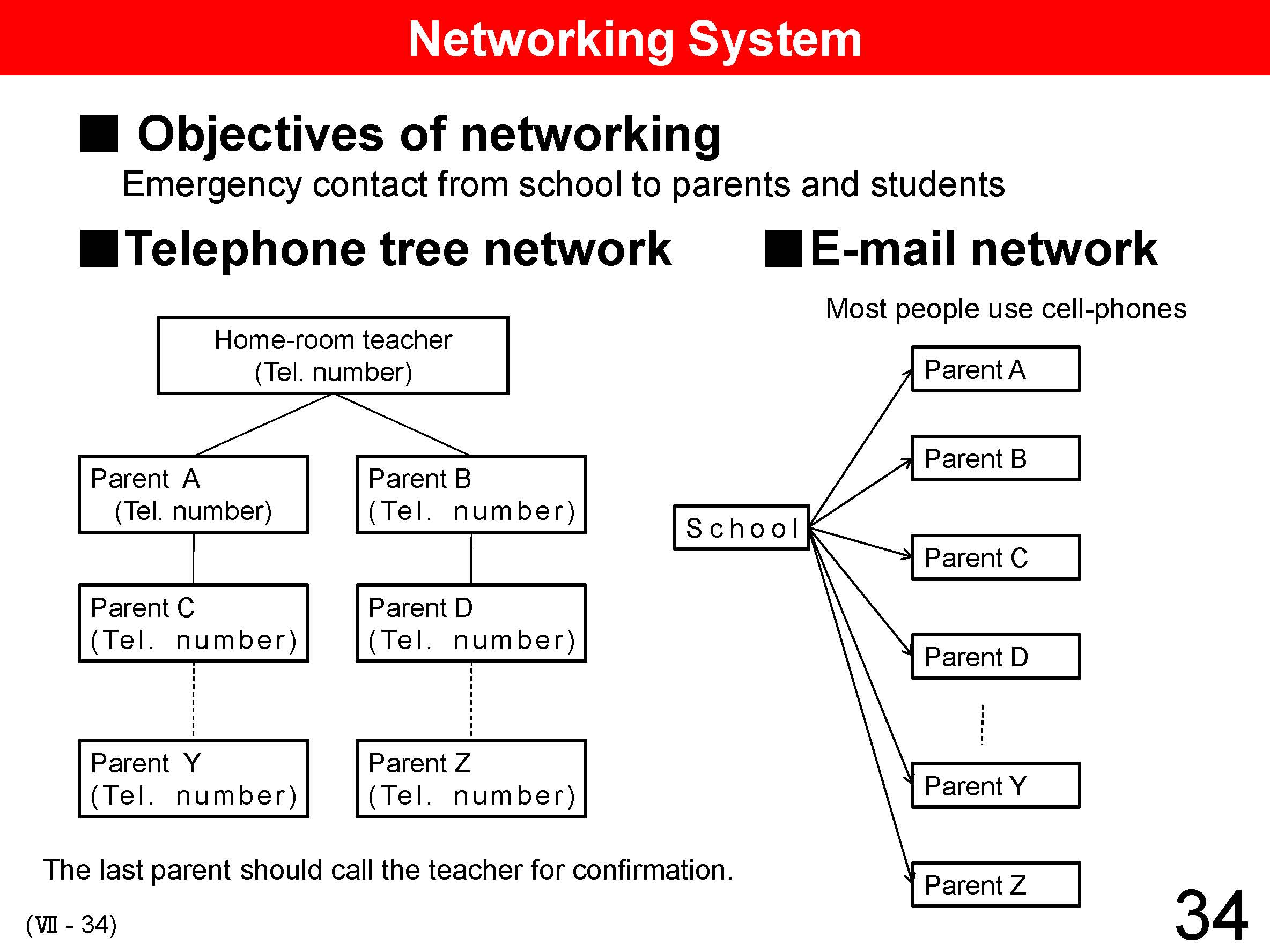 |
Networking system is for emergency contact from school to parents and students. A telephone tree chart is distributed to each parent. Each parent calls the next parent so that the information reaches all the parents. When the telephone is not answered, the next parent is to be contacted. The last parent in the chart should call the teacher (or sometimes the first parent in the chart) to tell that he/she has been reached. Recently, e-mail, mostly to cell-phones, is sometimes used to send information to parents all at once. Either way, since personal information such as telephone numbers and e-mail addresses is involved, careful attention is necessary to prevent use for improper purposes. |
| 35 | 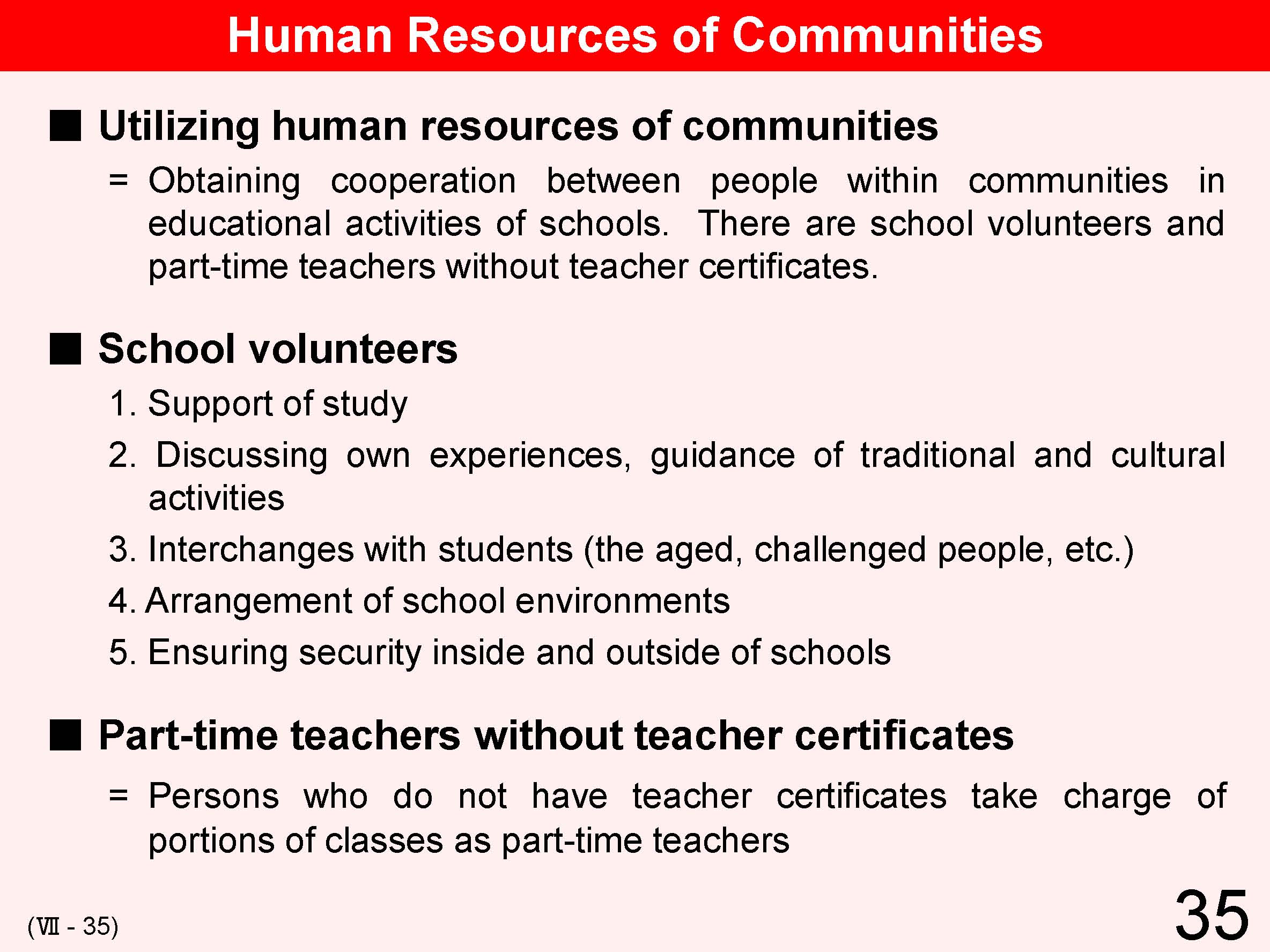 |
Utilizing adults’ extensive experiences and excellent knowledge and techniques is an effective way to diversify school education, to nurture social and work attitudes and a desirable view of occupations and to impart guidance on practical skills. Such alternative human resources are not only effective in providing guidance during the period of integrated study, but also are expected to encourage changes in awareness by educational personnel of improvements in school management. This is done by introducing new ideas to the school. (The period of integrated study --> Ⅳ 64) |
| 36 | 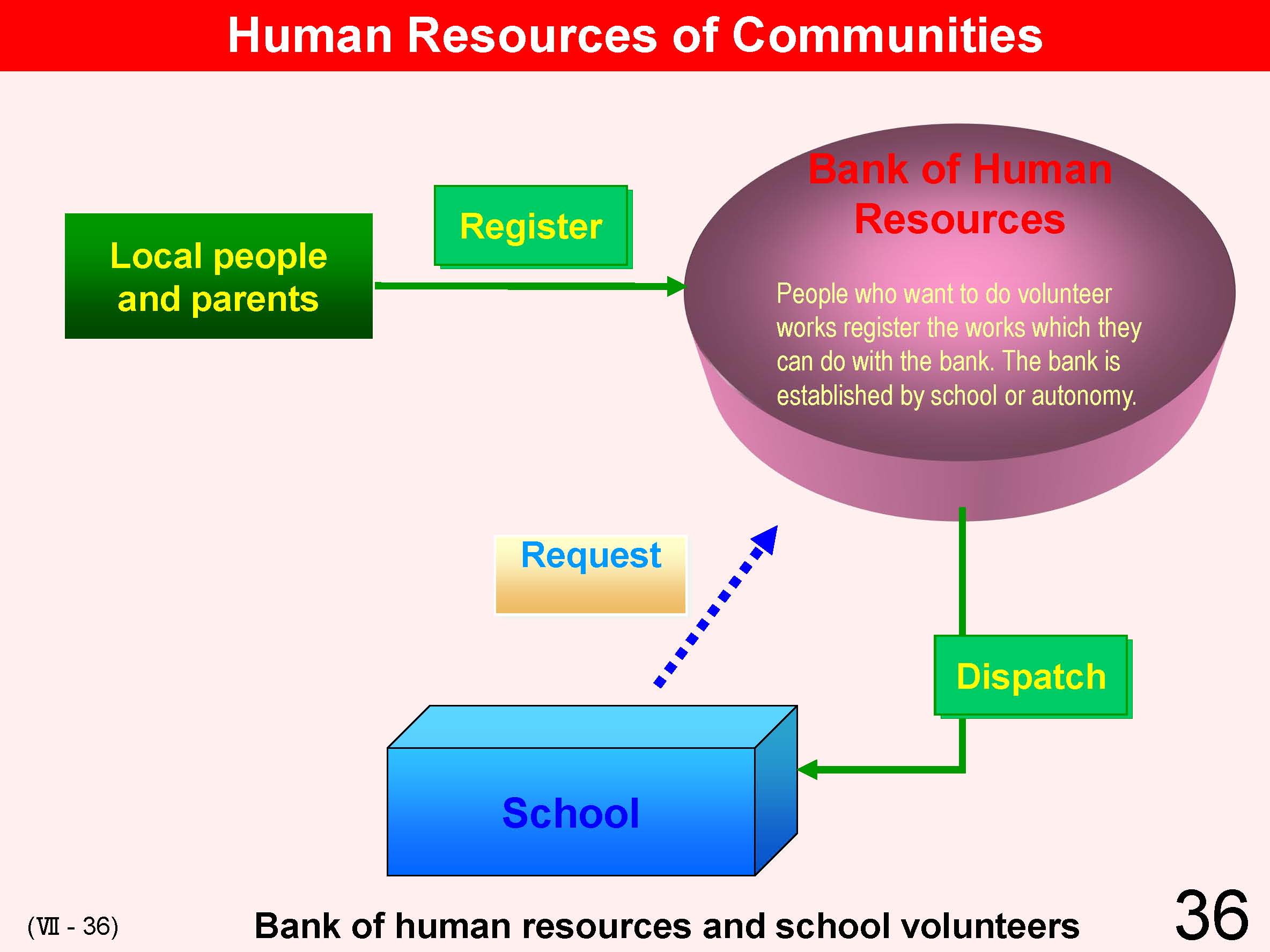 |
In order to mobilize and to use school volunteers, schools and local governments promote establishment of a volunteer bank. Local people are encouraged to register in the human resource “banks” as volunteers to work in individual schools. The schools request the “banks” to dispatch volunteers appropriate for selective tasks when outside help is needed to help overcome personnel shortages. |
| 37 | 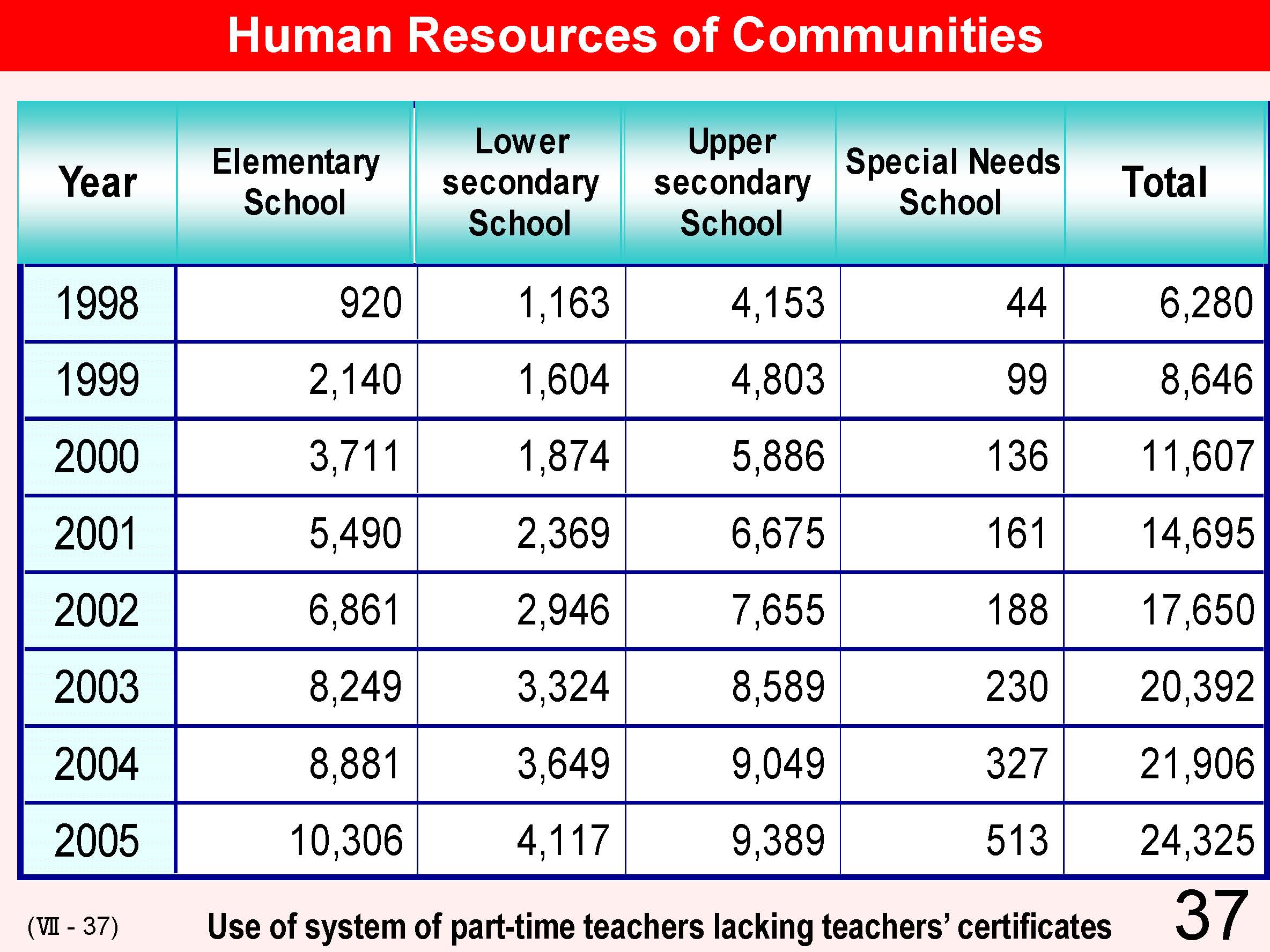 |
Part-time teachers lacking teachers’ certificates are eligible to teach a portion of subjects under the Law on Certificate of Educational Personnel. It is necessary for schools to report employment of such part-time teachers to prefecture Boards of Education which have the right of appointment. Part-time teachers lacking teacher’s certificates can be put in charge of class lectures and tests and can evaluate results. |
| 38 | 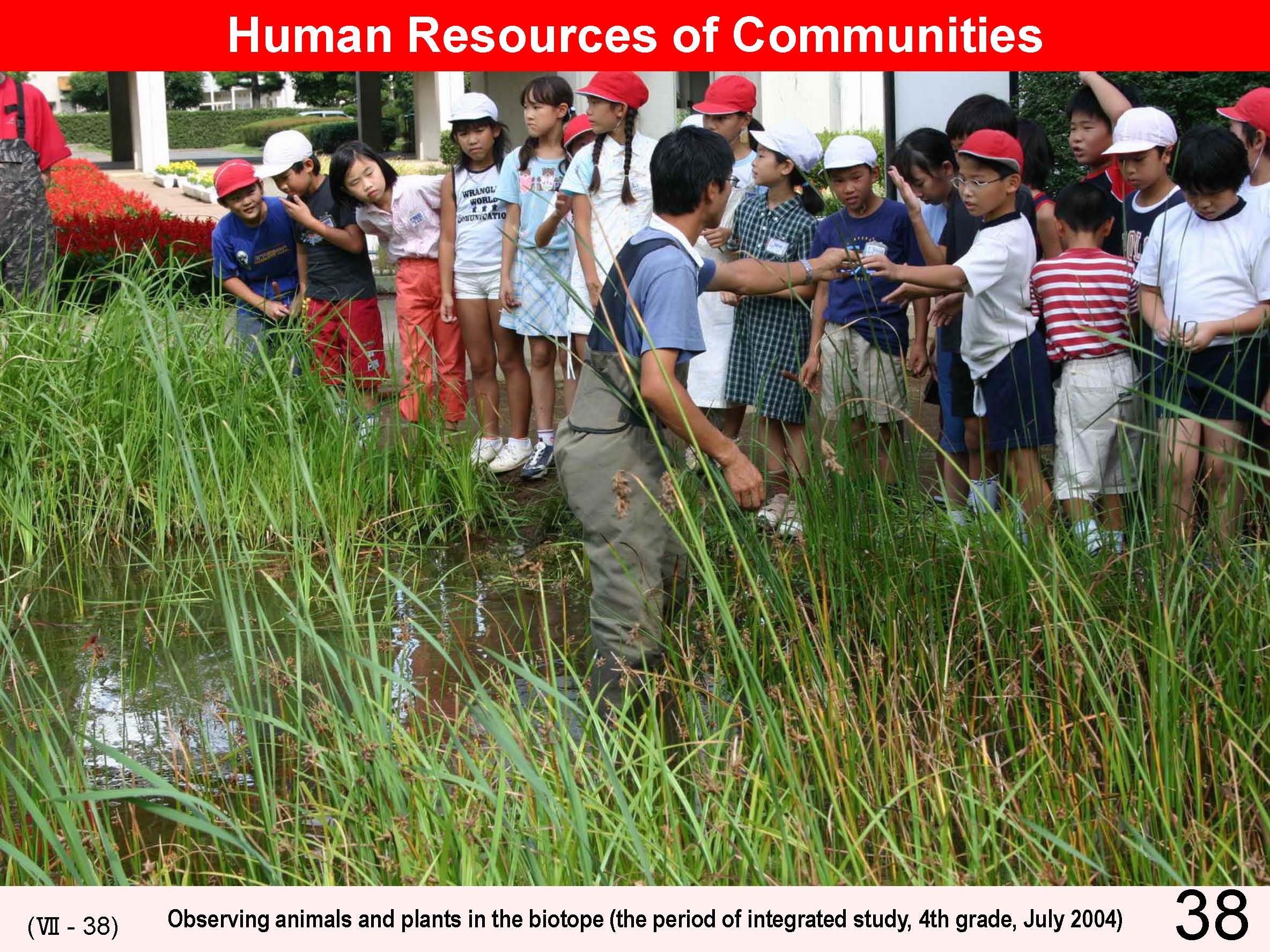 |
Children can engage in special activities, develop human relationships and feel that they are a part of the community by studying with special part-time teachers and school volunteers. A voluntary teacher from an NPO for environmental protection is explaining environmental protection system dynamics. |
| 39 | 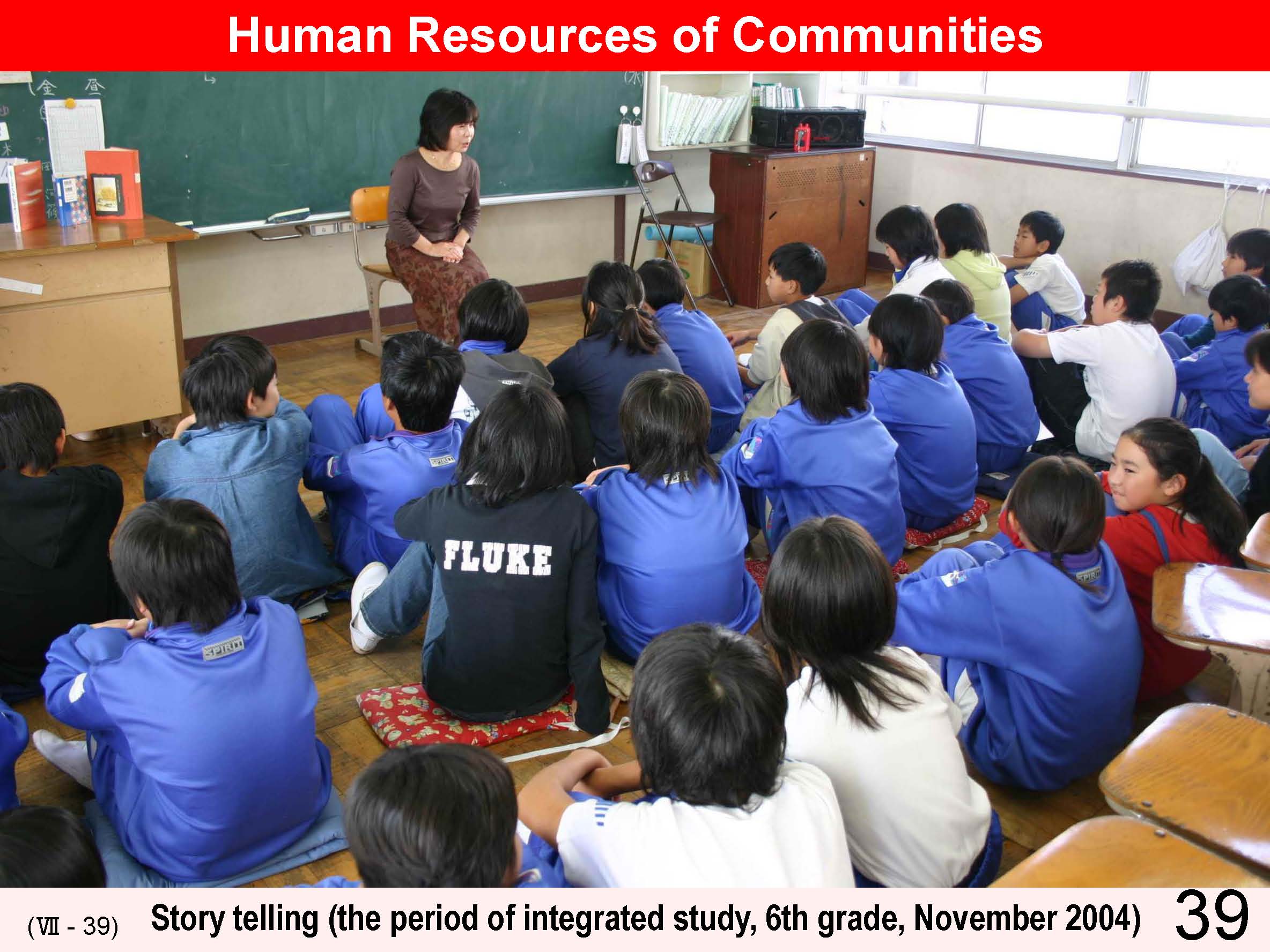 |
A volunteer is telling foreign fairy tales to students. |
| 40 | 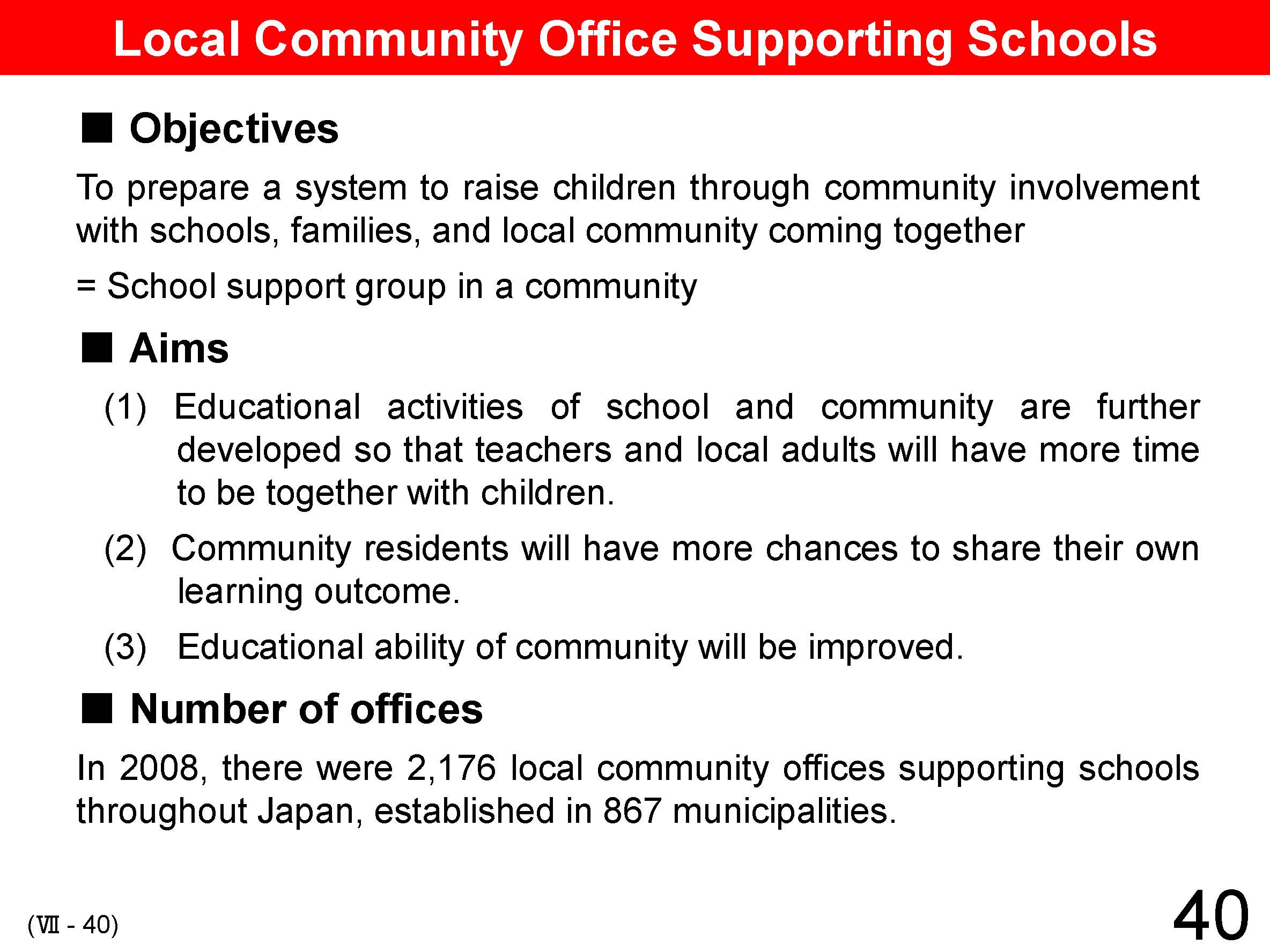 |
The Ministry of Education, Culture, Sports, Science and Technology introduced “Local Community Office Supporting Schools Project” in 2008, and 2176 offices have been established. --> MEXT Promotion Committee for Local Community Office Supporting Schools, “All support schools, all raise children” and “At the start of “Local Community Office Supporting Schools Project” (July 1st, 2008) (http://www.mext.go.jp/a_menu/01_l/08052911/004/002.htm) |
| 41 | 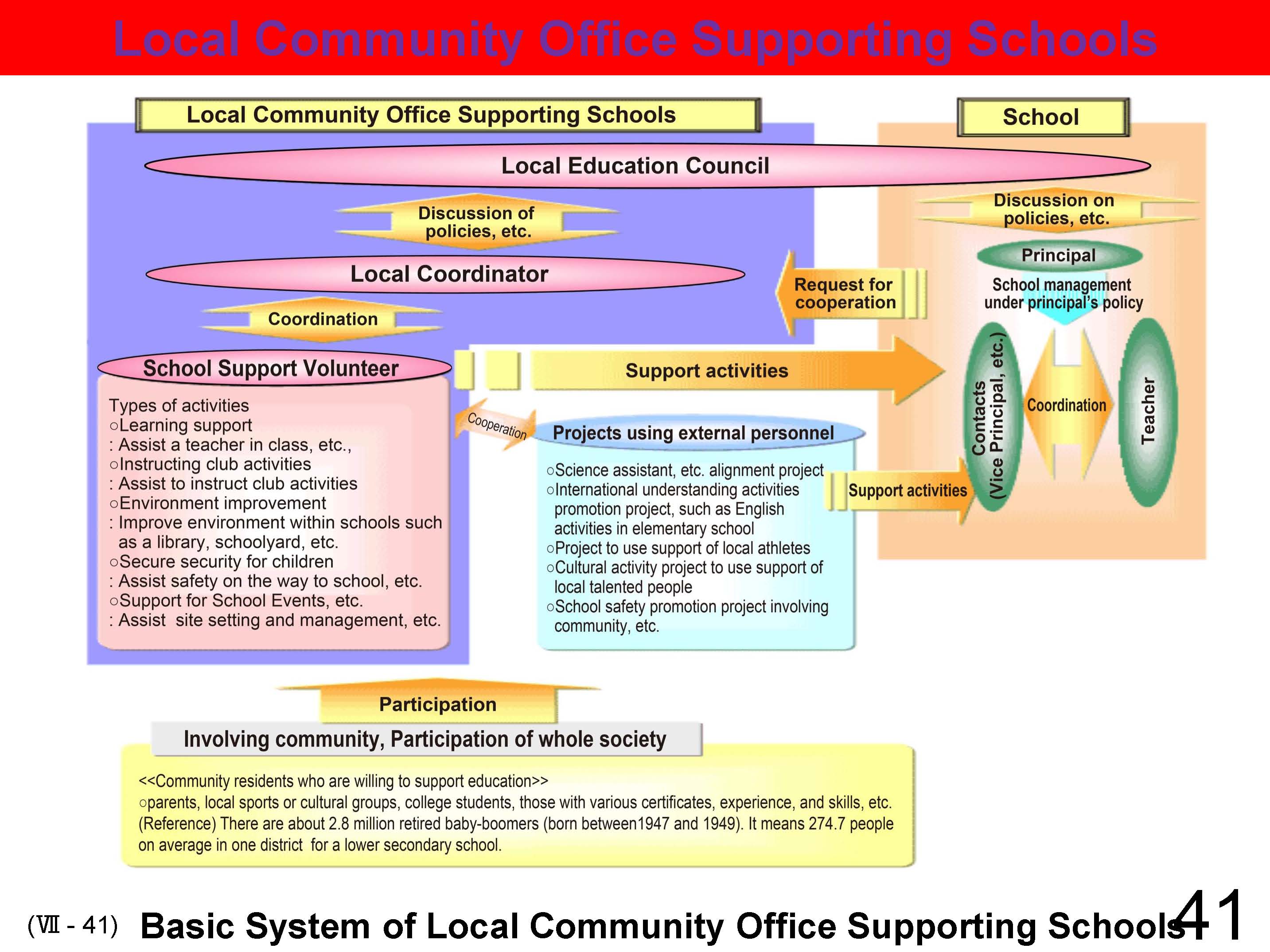 |
“Local Coordinator” conducts coordination and liaison task between school and school support volunteers or between volunteers such as assigning volunteers to do actual activities, takes up virtual operation of Local Community Office Supporting Schools, and plays a key role to affect the outcome at the project. “School Support Volunteers” are community residents who conduct actual support activities. “Local Education Council” is a committee that plans and designs policies on what kind of supports the local community office will offer. Council members may be representatives of school, PTA, coordinators and volunteers, officials of social education facilities such as community centers, persons from such community involved groups as community association or chamber of commerce, but are actually determined by municipal board of education according to the actual situation of each community. If there has been an organization to discuss education for children, it is possible to turn that organization into Local Education Council. → MEXT Promotion Committee for Local Community Office Supporting Schools, “All support schools, and all raise children” : “At the start of “Local Community Office Supporting Schools Project” (July 1st, 2008) (http://www.mext.go.jp/a_menu/01_l/08052911/004/002.htm) |
| 42 | 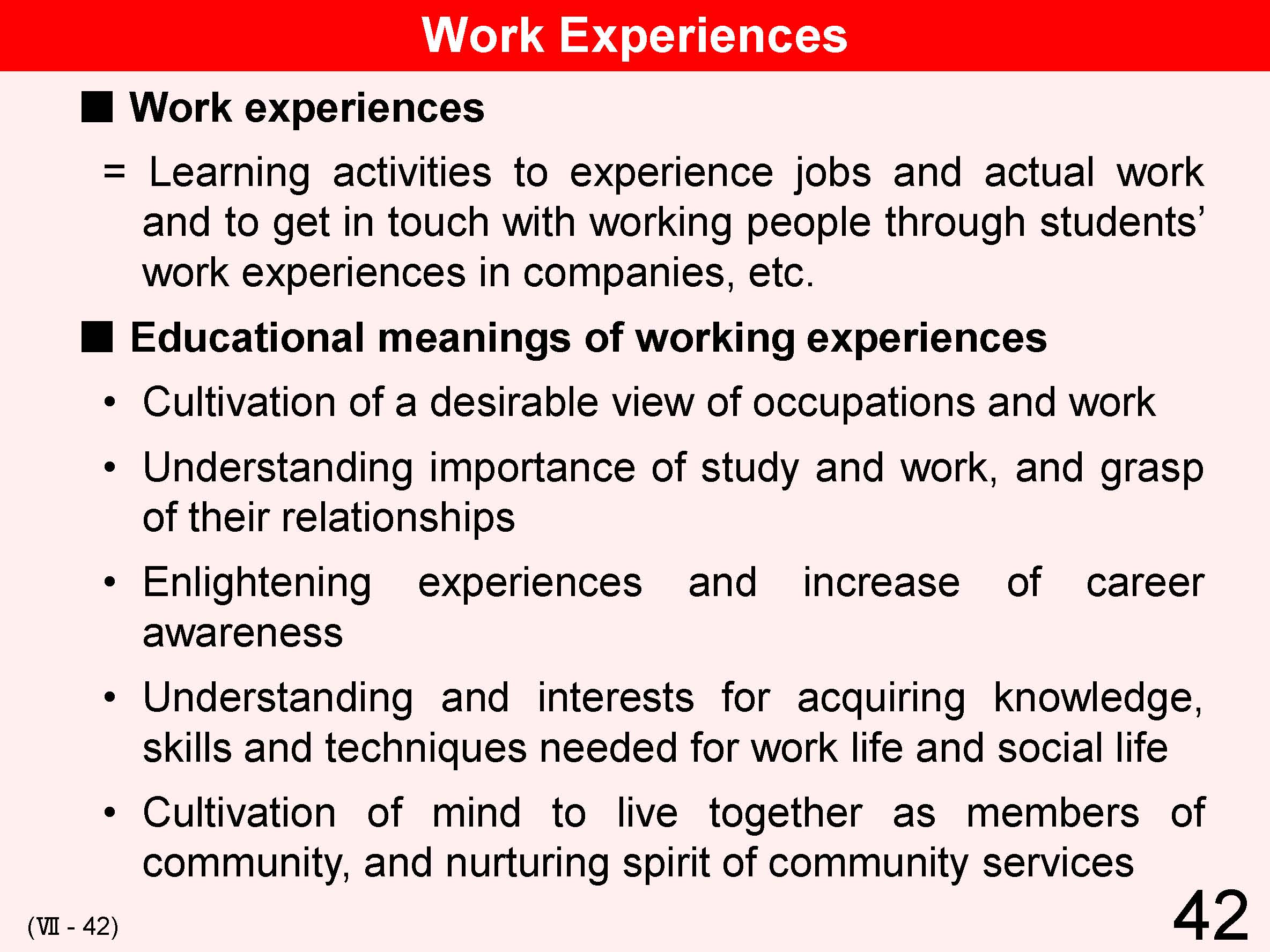 |
Working experiences are hands-on work experiences in public organizations or companies. It is carried out as a part of student career guidance or in the period of integrated study. It is designed not only to promote understanding of an occupation through hands-on work experience, but also through examining the occupation to better understand it. Work experiences help develop positive views of occupations and work as well as to better identify student’s aptitudes and determine appropriate courses and career paths. Cooperative relations with organizations and companies must be established in order to better operationalize work opportunities. --> Ministry of Education, Culture, Sports, Science and Technology “Work Experience Guide for Lower Secondary Schools” (http://www.mext.go.jp/a_menu/shotou/career/05010502/026.htm) (The special activities --> Ⅳ 49) (The period of integrated study --> Ⅳ 64, 65) |
| 43 | 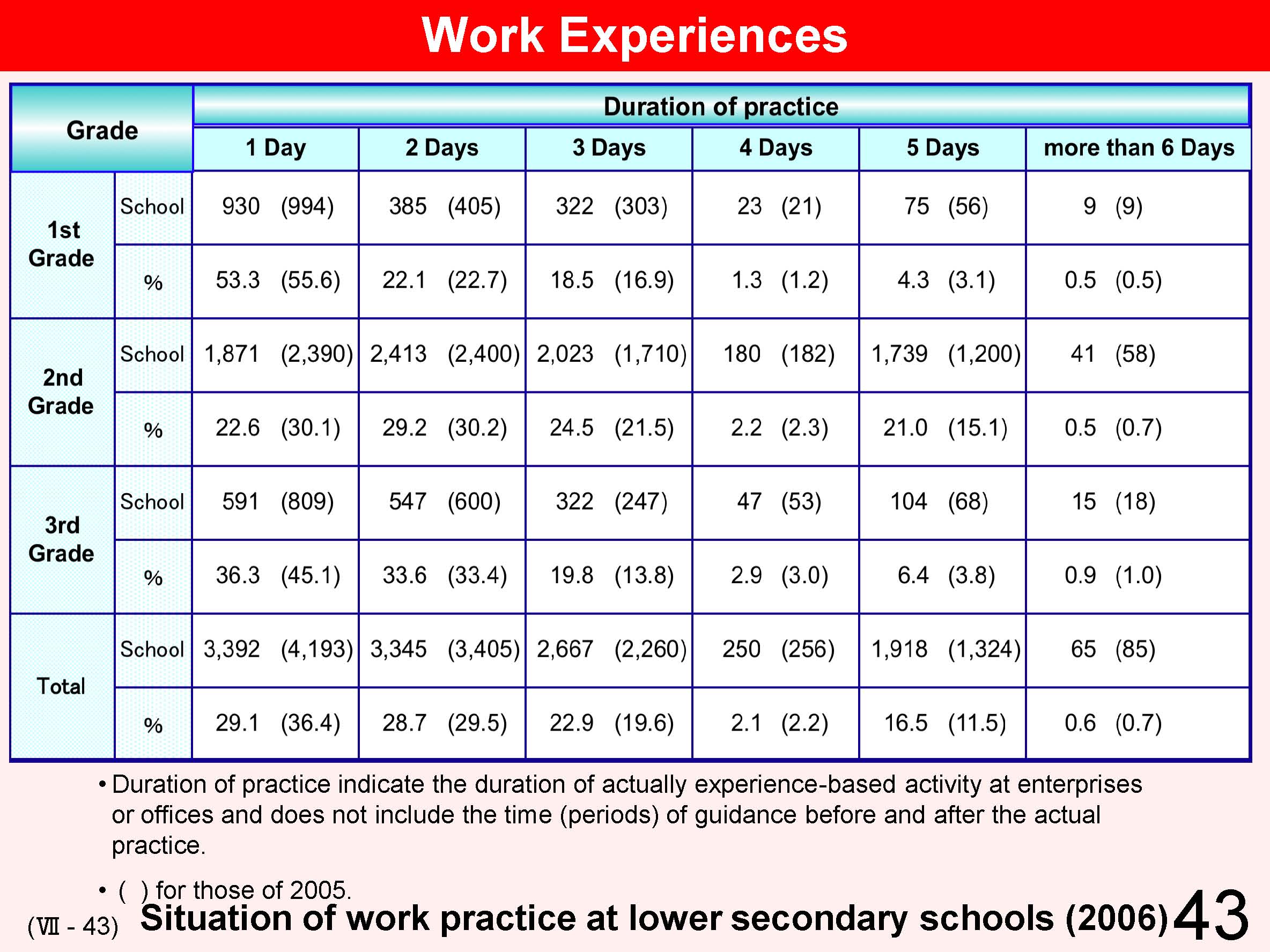 |
Nearly 95% of public lower secondary schools in Japan provide opportunities for students to have work experiences in companies or organizations. In terms of grades, a majority of schools offer 2nd graders options to have hands-on work experiences, and in terms of duration, 29% of schools allocate one day to the program. About 20% of schools provide students with work experiences extending for four days or more. --> National Institute for Educational Policy Research, Student Guidance Research Center “Survey of Situation of Work Practice at Lower Secondary Schools (2006) (at March 2007)” (http://www.mext.go.jp/b_menu/shingi/chukyo/chukyo3/siryo/07070908/007/005/001.pdf) |
| 44 | 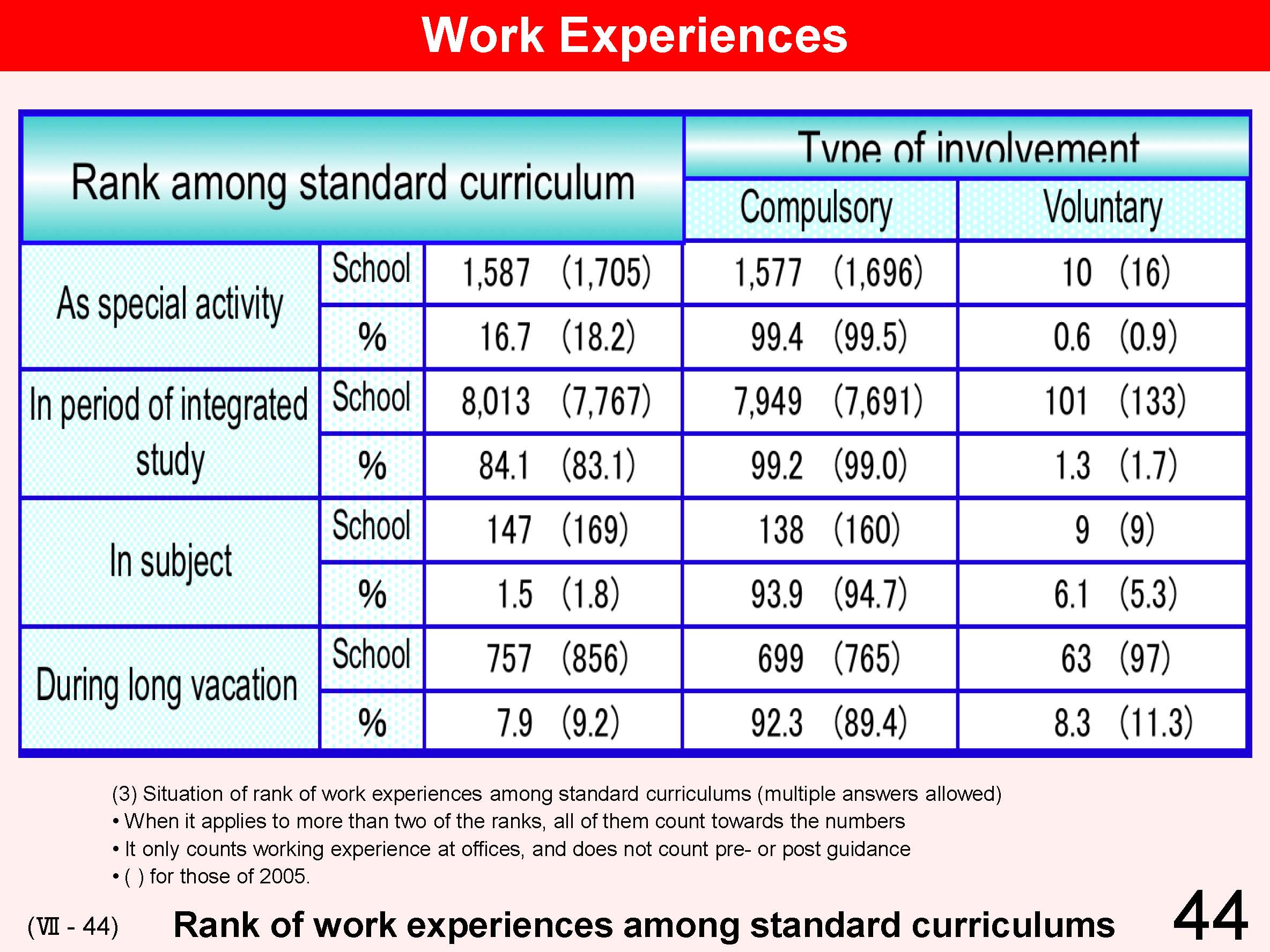 |
In standard Japanese curriculums, 84% of schools offer students work experiences in “the period of integrated study.” The rate is much higher than in any other course periods of school curriculums. The data show that 17% of schools offer work experiences as special activities, while 8% of schools don’t introduce them in standard curriculums but rather offer them during long vacations. In principle, most schools let all students in their grades participate. --> National Institute for Educational Policy Research, Student Guidance Research Center “Survey of Situation of Work Practice at Lower Secondary Schools (2006) (at March 2007)” (http://www.mext.go.jp/b_menu/shingi/chukyo/chukyo3/siryo/07070908/007/005/001.pdf) |
| 45 | 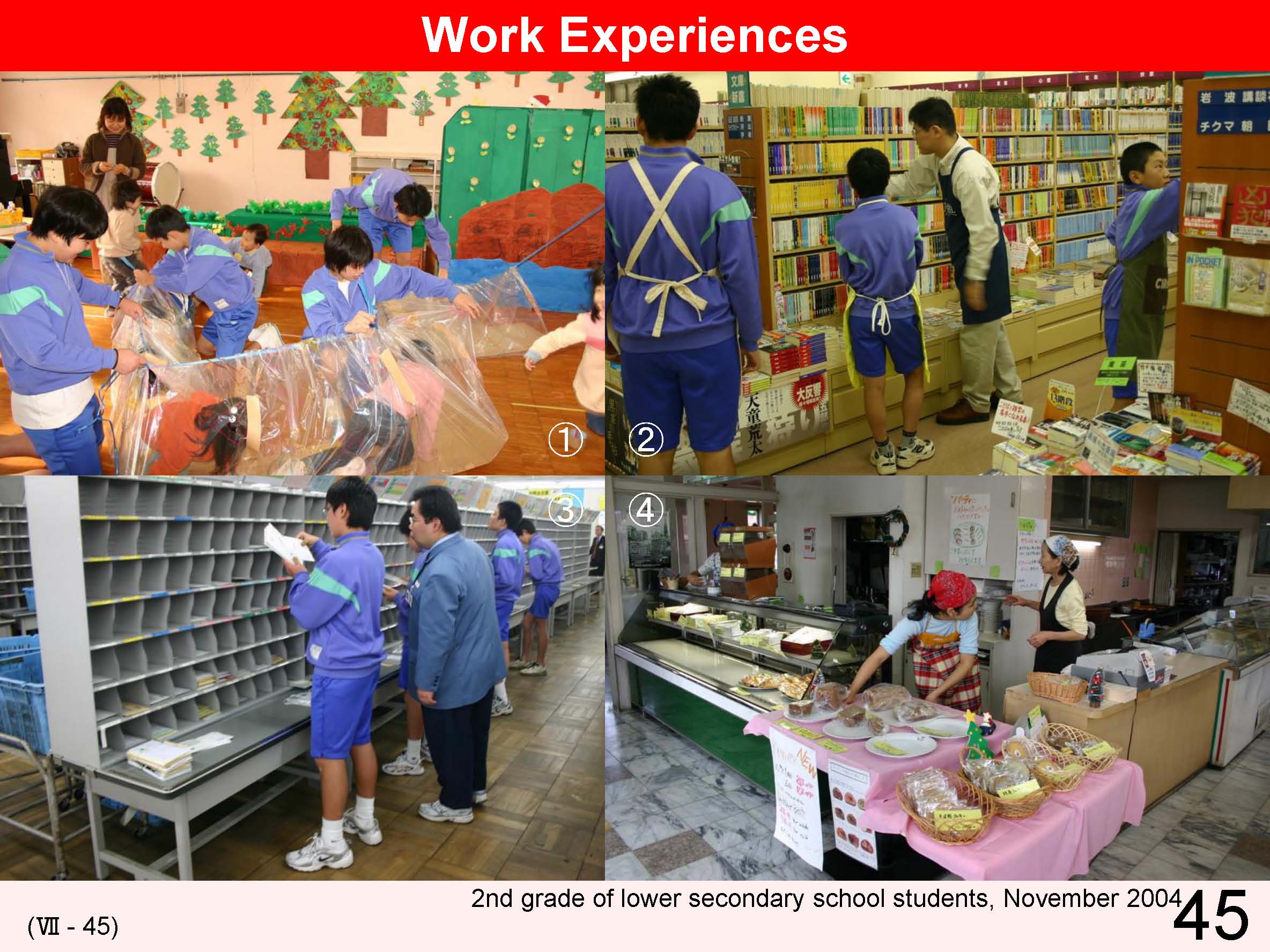 |
Cooperation between enterprises and their staff is indispensable. Pre-instruction is provided to students, and after their working experience, students are required to submit reports to their schools. (1) Kindergarten (2) Bookstore (3) Post office (4) Bakery |
| 46 | 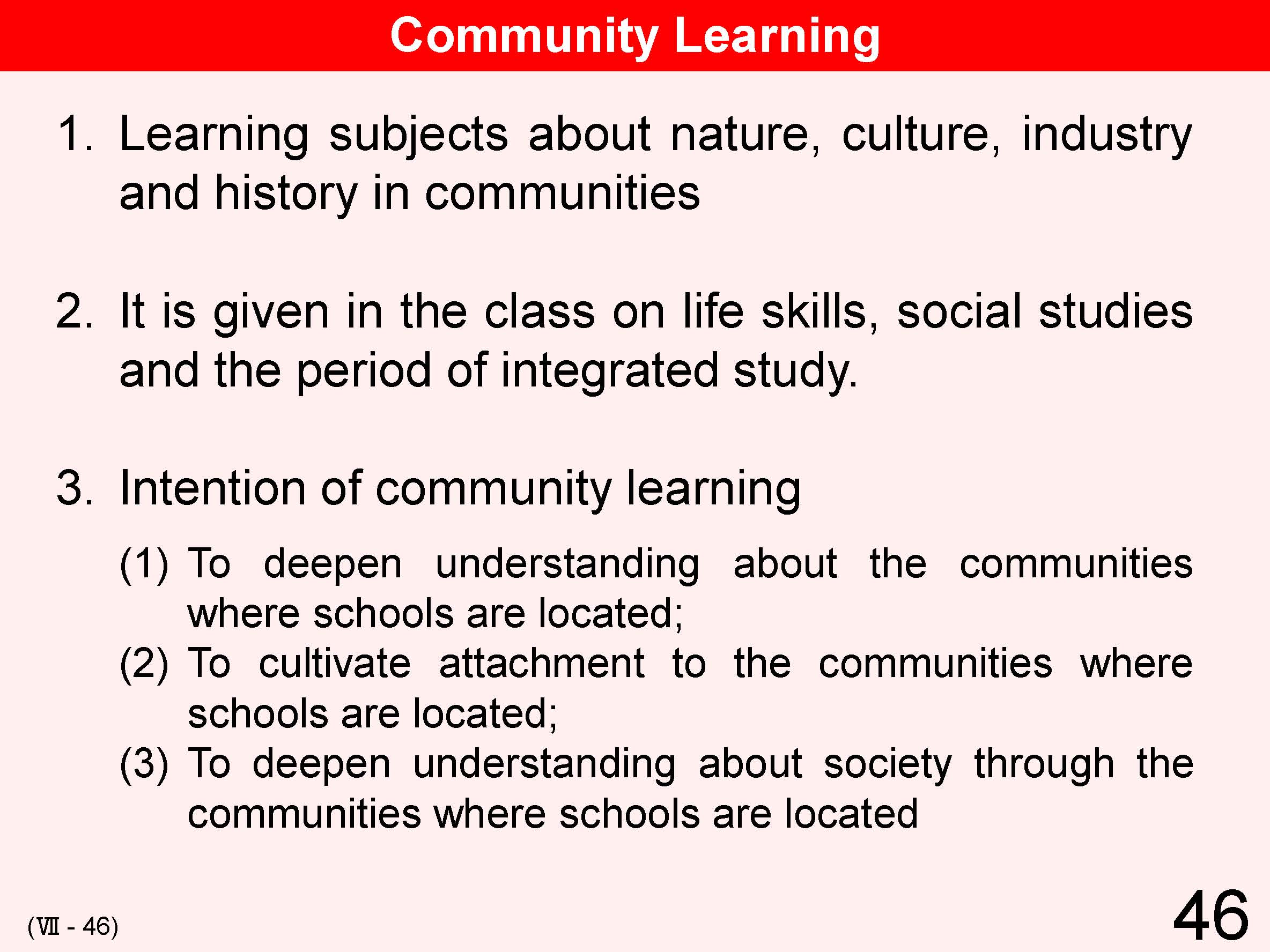 |
It is repeatedly said that school curriculums should be relevant to the actual conditions and characteristics of communities as evidenced by the new Curriculum Council and the new Course of Study. Specifically, during the period of integrated study, schools are required to make use of the characteristics, resources and educational functions of communities in such aspects as (1) learning subjects relevant to the characteristics of communities; (2) promoting experiences in society such as experience of nature, and volunteer and learning activities such as field trips and field studies; (3) integrating guidance systems in cooperation with community members and (4) actively using teaching materials about local communities and learning environments. It is premised that school staff understand the actual conditions of communities where schools are located and they reside, and that they can explain such characteristics through organization of school curriculums relevant to the actual conditions and characteristics of communities. Schools are also required to solicit information about local natural environments, social environments, facilities and talent in the local communities as well as the everyday life of children. It is possible to make use of Local Education Liaison Councils to get such information. |
| 47 | 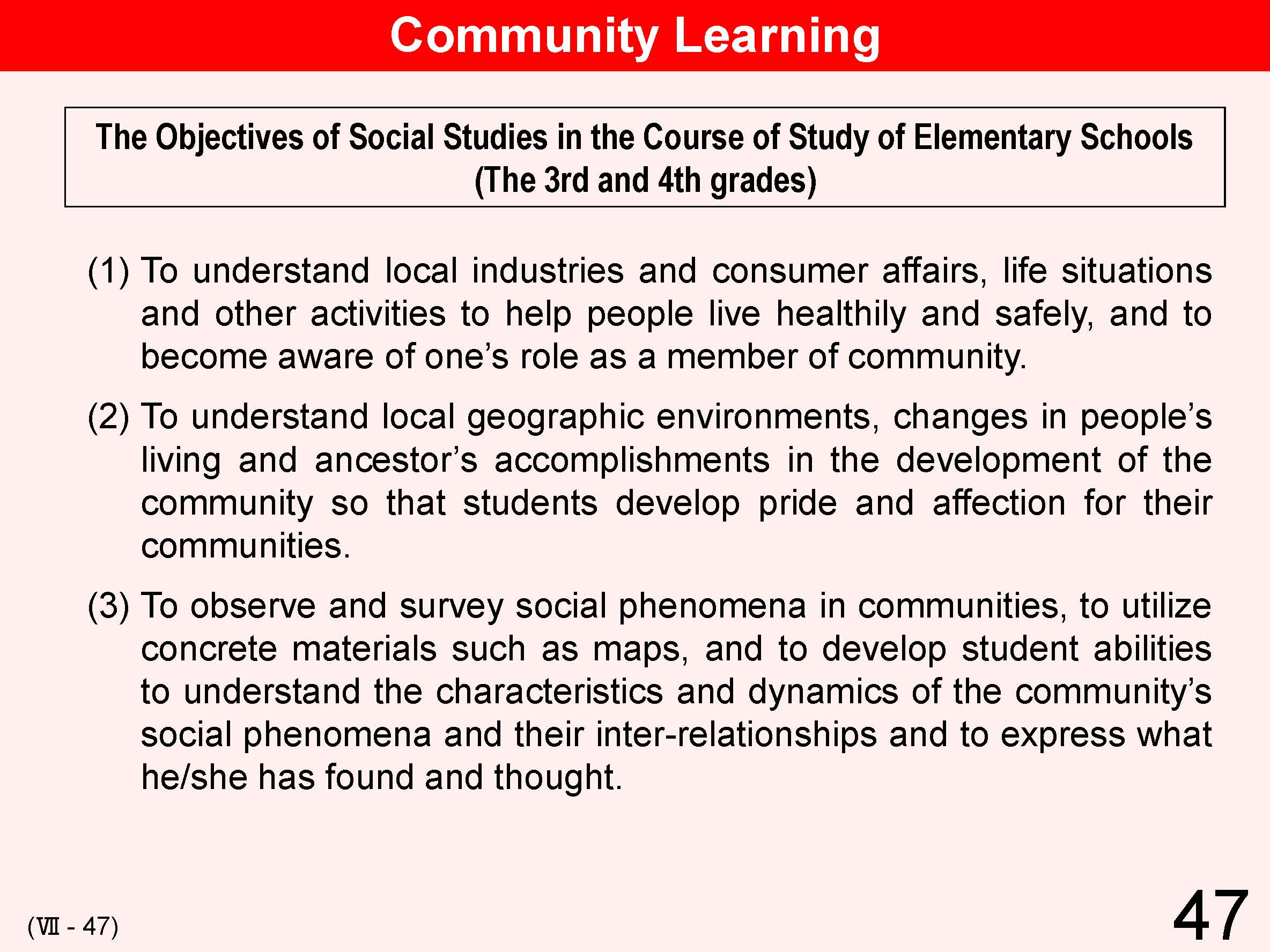 |
In 3rd and 4th grade Social Studies, the main focus of courses is on local communities. It is an extension of “life skills” in the 1st and 2nd grades and becomes the basis for Social Studies in the 5th and 6th grades. Sometimes, this local focus is incorporated within the period of integrated study. |
| 48 | 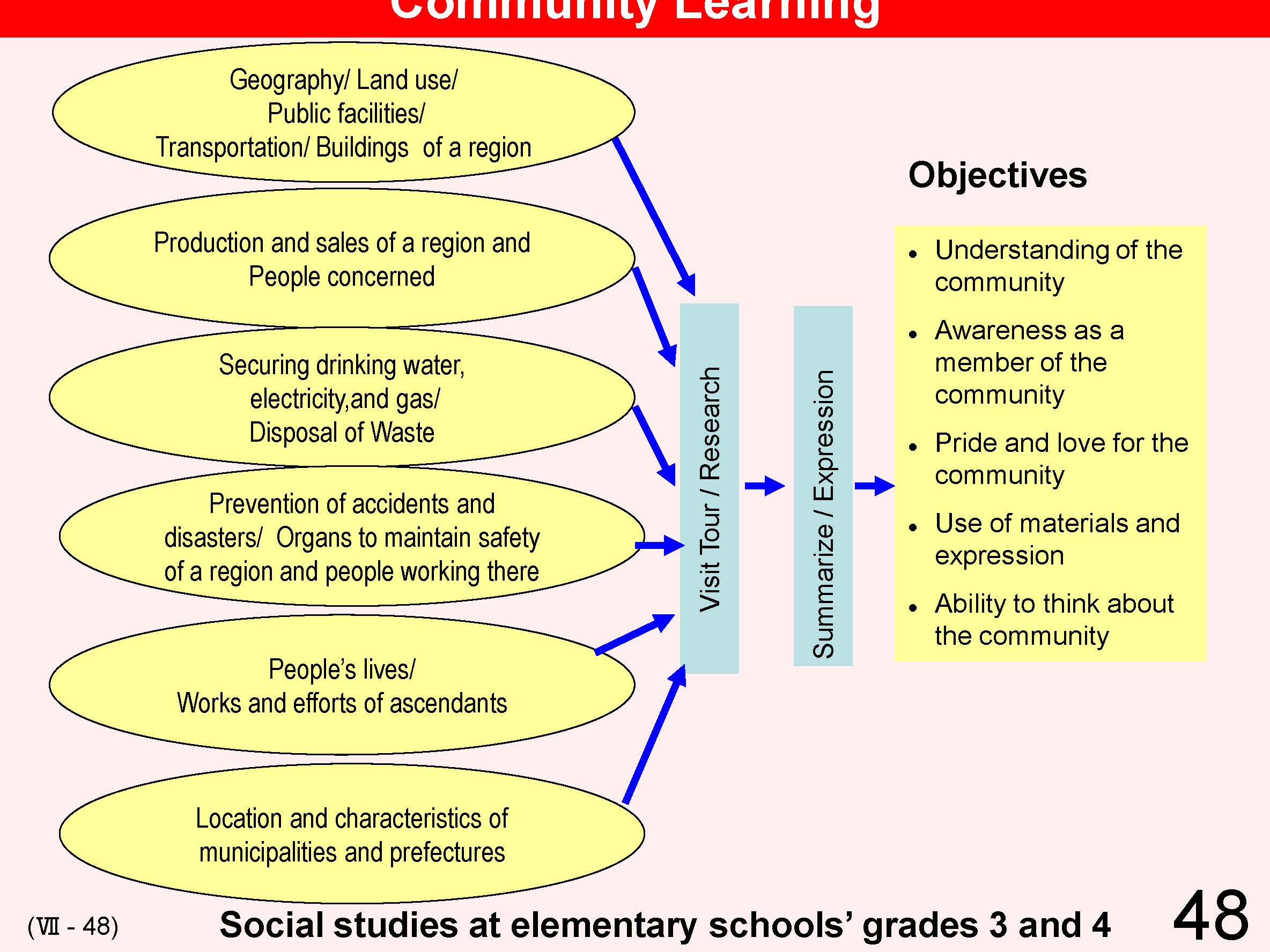 |
In social studies, the 3rd and 4th graders in elementary school come mainly to learn about their communities. This further develops what students have learned in the class of life skills in grades 1 and 2, as well as lays the foundation for what they will learn in social studies classes later on. Social studies classes are sometimes coordinated with the period of integrated study. Social studies classes in grades 3 and 4, attempt to get students to observe and research rural natural environs, social environments, industries, security institutions, and regular lives and then to arrange their findings for presentation. |
| 49 | 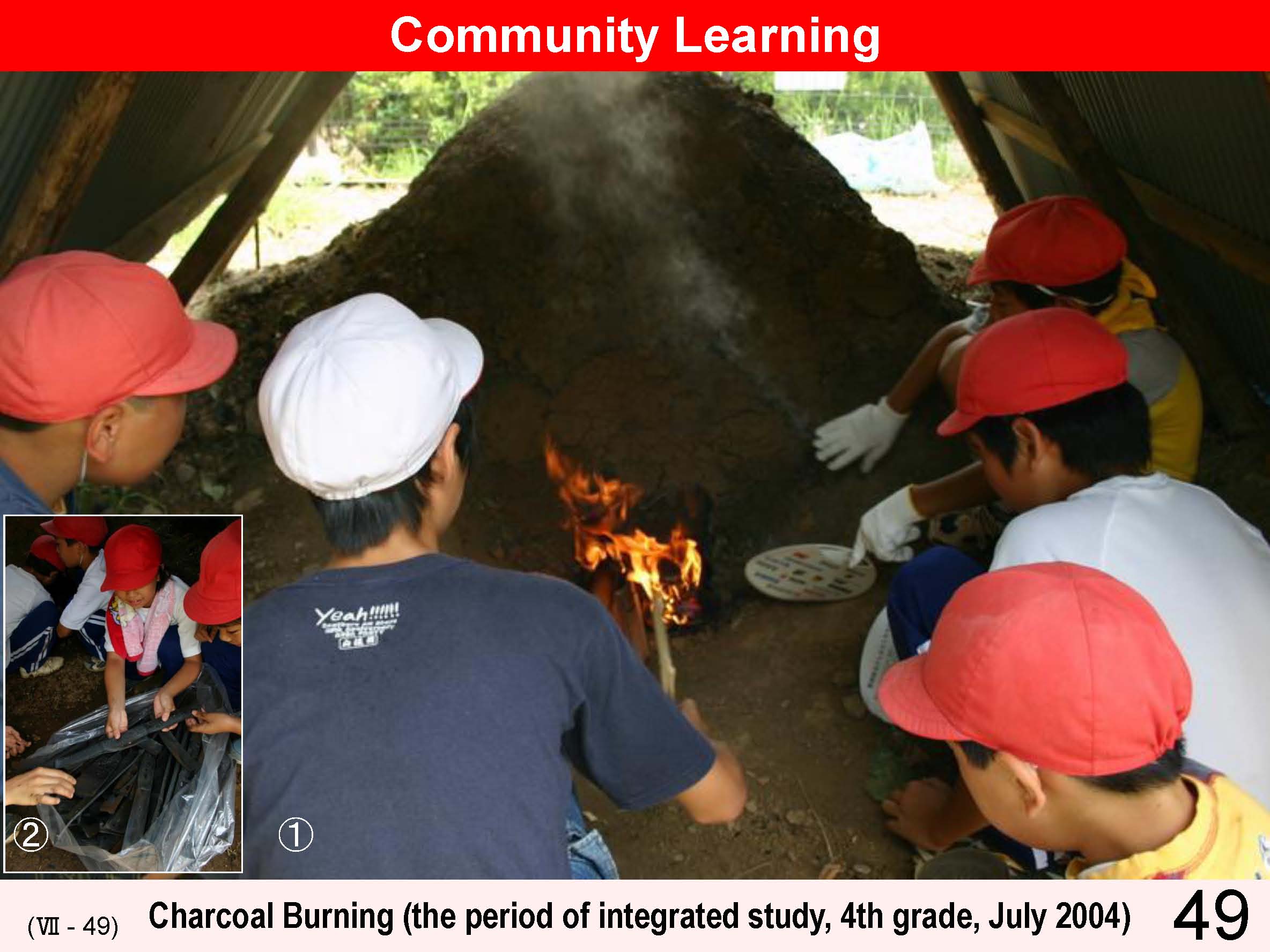 |
Community learning is a practical type of study in which students venture out into their local communities and do research on them. Cooperation with members of local communities is necessary. At the beginning of the activity of learning about charcoal burns, local residents teach the students how to make a kiln and ways to make charcoal. |
| 50 | 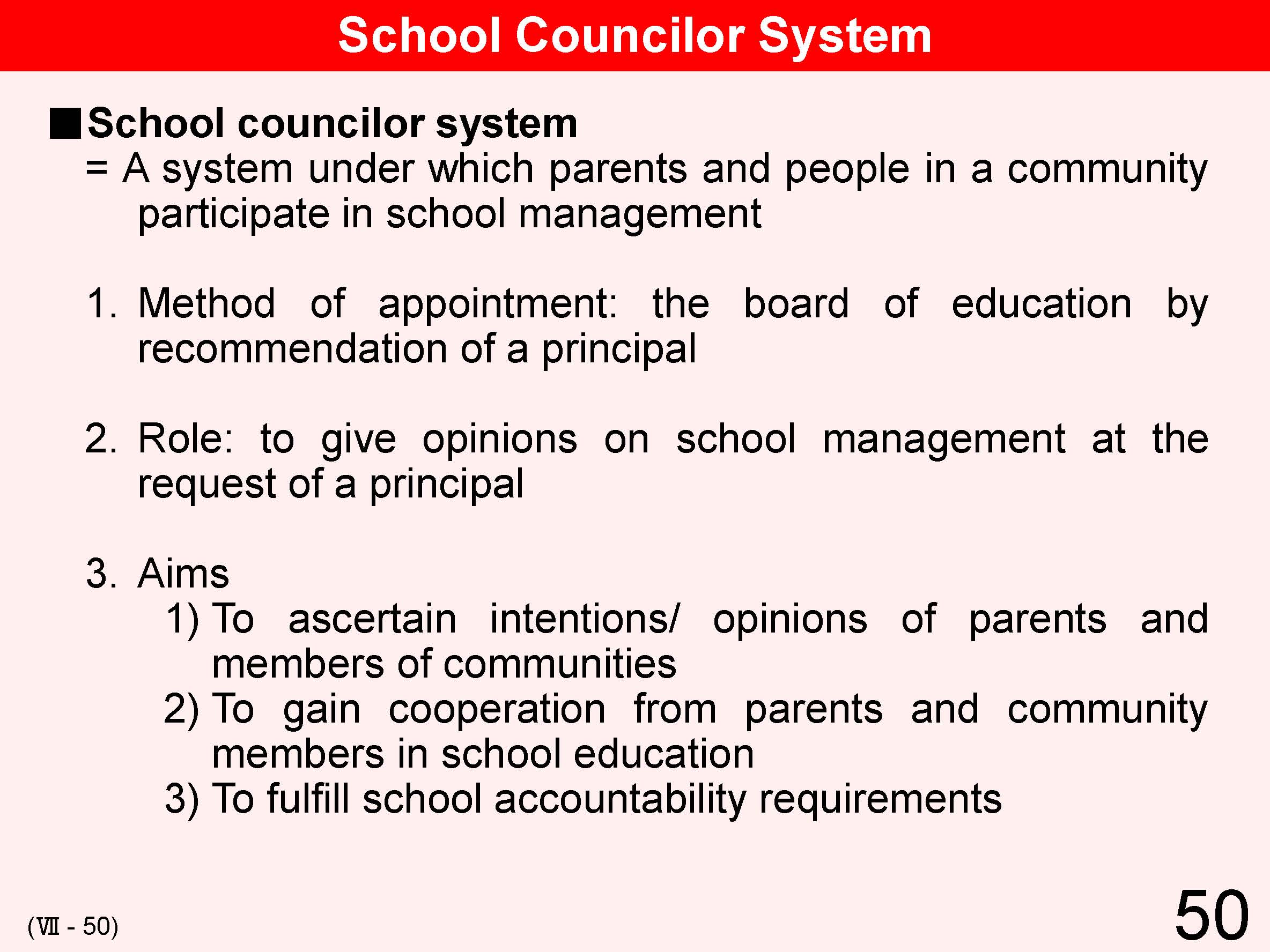 |
The school councilor system in Japan is outlined in Article 49 of the Enforcement Regulation of the School Education Act. School councilors are commissioned by the boards of education based on recommendations of school principals and are chosen among those who have an understanding and views on education, but excluding school staff. School councilors provide opinions on school management at the request of principals. This is a system designed to solicit and to reflect opinions from parents and community members regarding school management in cooperation with local communities under the guidance of school principals, while at the same time encouraging participation by knowledgeable outsiders. |
| 51 | 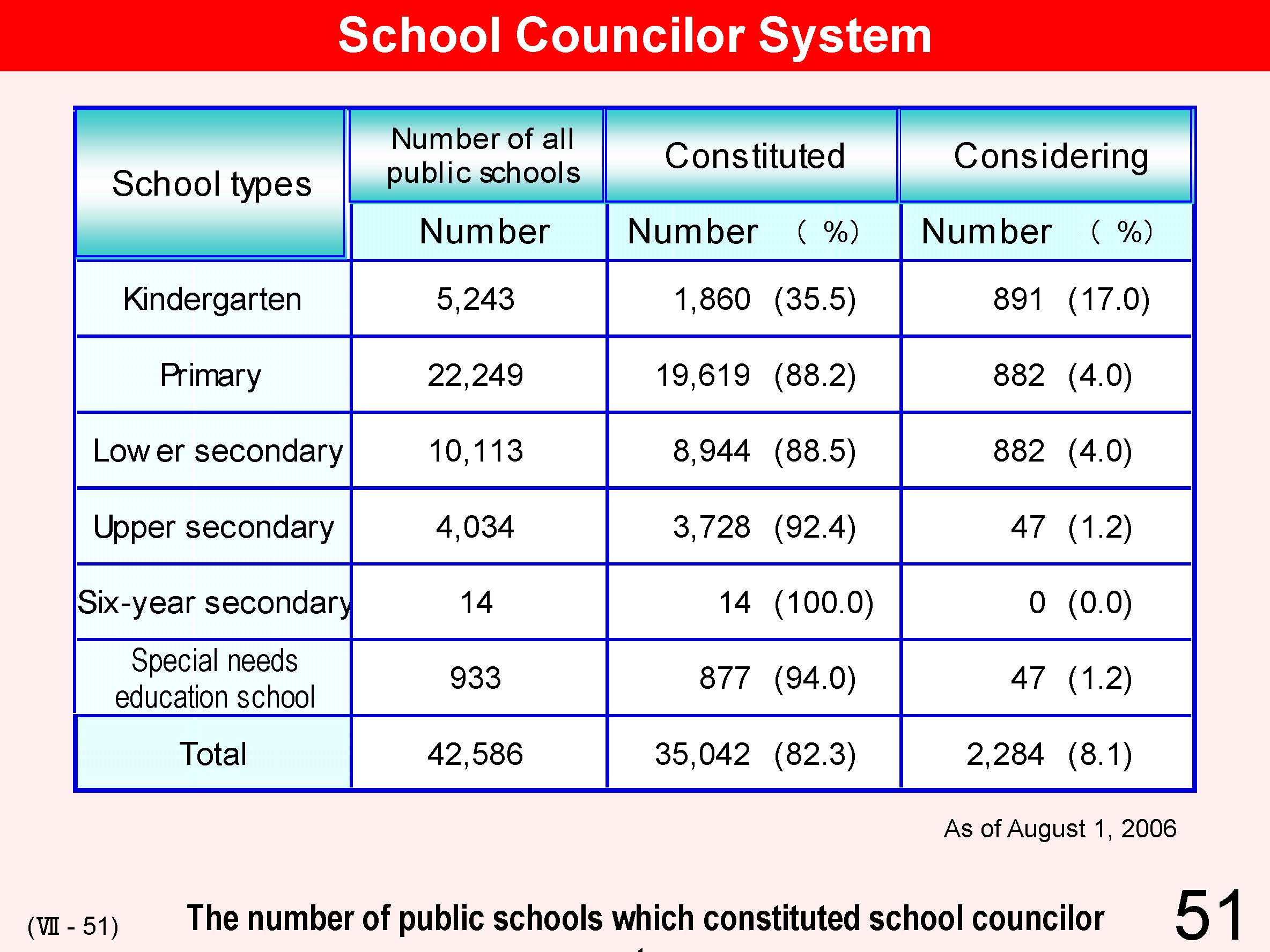 |
The number of schools which have introduced school councilors has been increasing. The number of public schools that have constituted school councilor systems (including similar system) is 35,042 (82.3%) while the number of public schools which have considered constituting such systems is 2,284 (8.1%). To compare the proportions of each kind of school, they are about 88% at elementary schools and lower secondary schools, and about 92% at upper secondary schools and special needs education schools, while these proportions are merely about 36% at kindergartens. --> The chart is on http://www.mext.go.jp/b_menu/houdou/19/03/07032712/001/001.pdf (School councilor --> Ⅱ 59) |
| 52 | 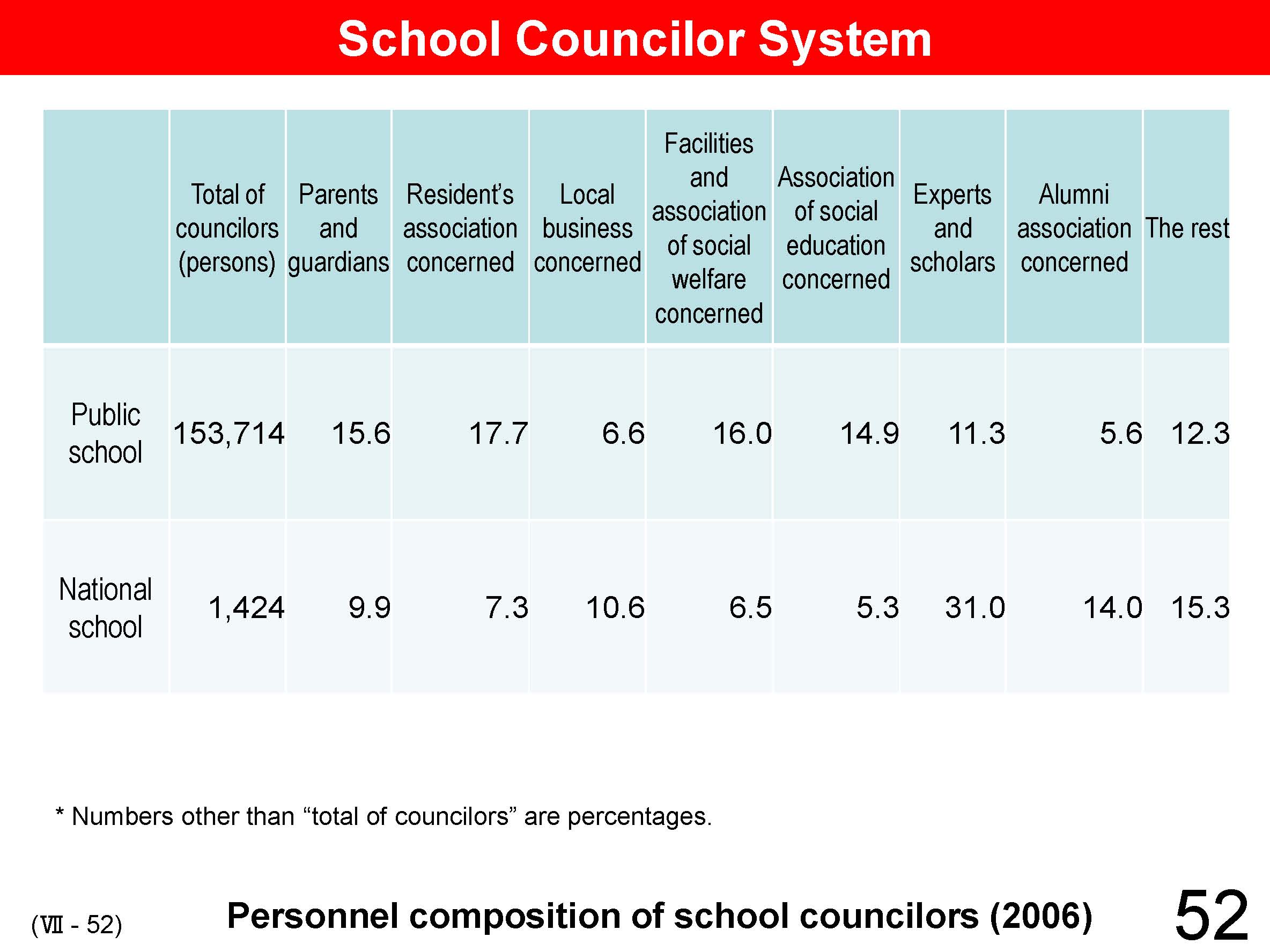 |
In 2006, the number of school councilors of public schools in Japan was 153,714, and most schools had four to six school councilors (64.8%). The kinds of school councilor occupations are: parents and guardians (15.6%), concerned resident’s associations (17.7%), concerned facilities and association of social welfare (16.0%), concerned associations of social education (14.9%), experts and scholars (11.3%), etc. In national schools, the proportions of experts and scholars, concerned alumni associations, and concerned local businesses are high. --> The chart is on http://www.mext.go.jp/b_menu/houdou/19/03/07032712/001/001.pdf |
| 53 | 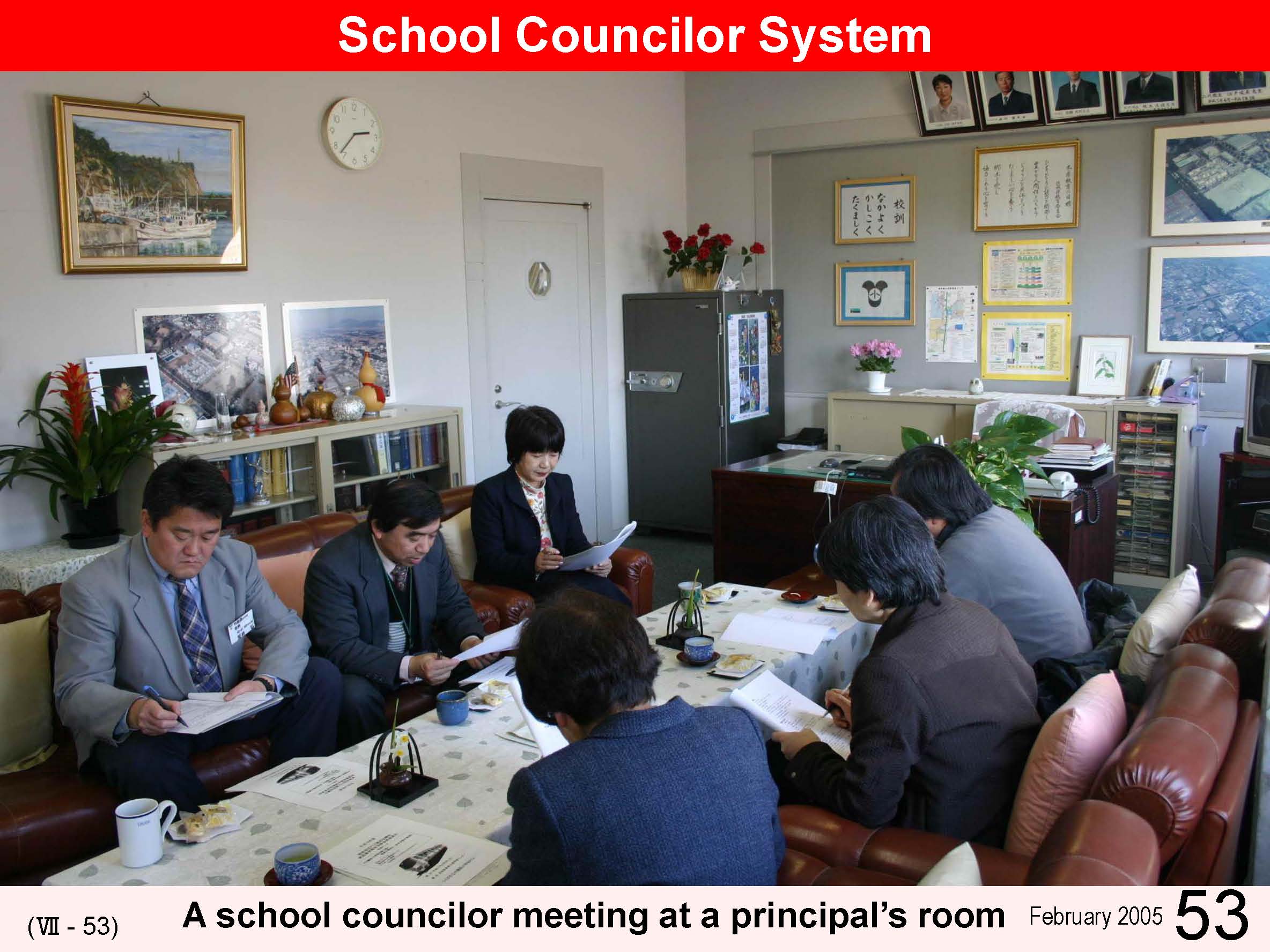 |
A lot of schools conduct meetings with school councilors once a semester. Schools explain educational activities, and sometimes a theme, and then exchange opinions with councilors. In some schools, principals do not hold meetings, but seek councilors’ opinion individually. |
| 54 | 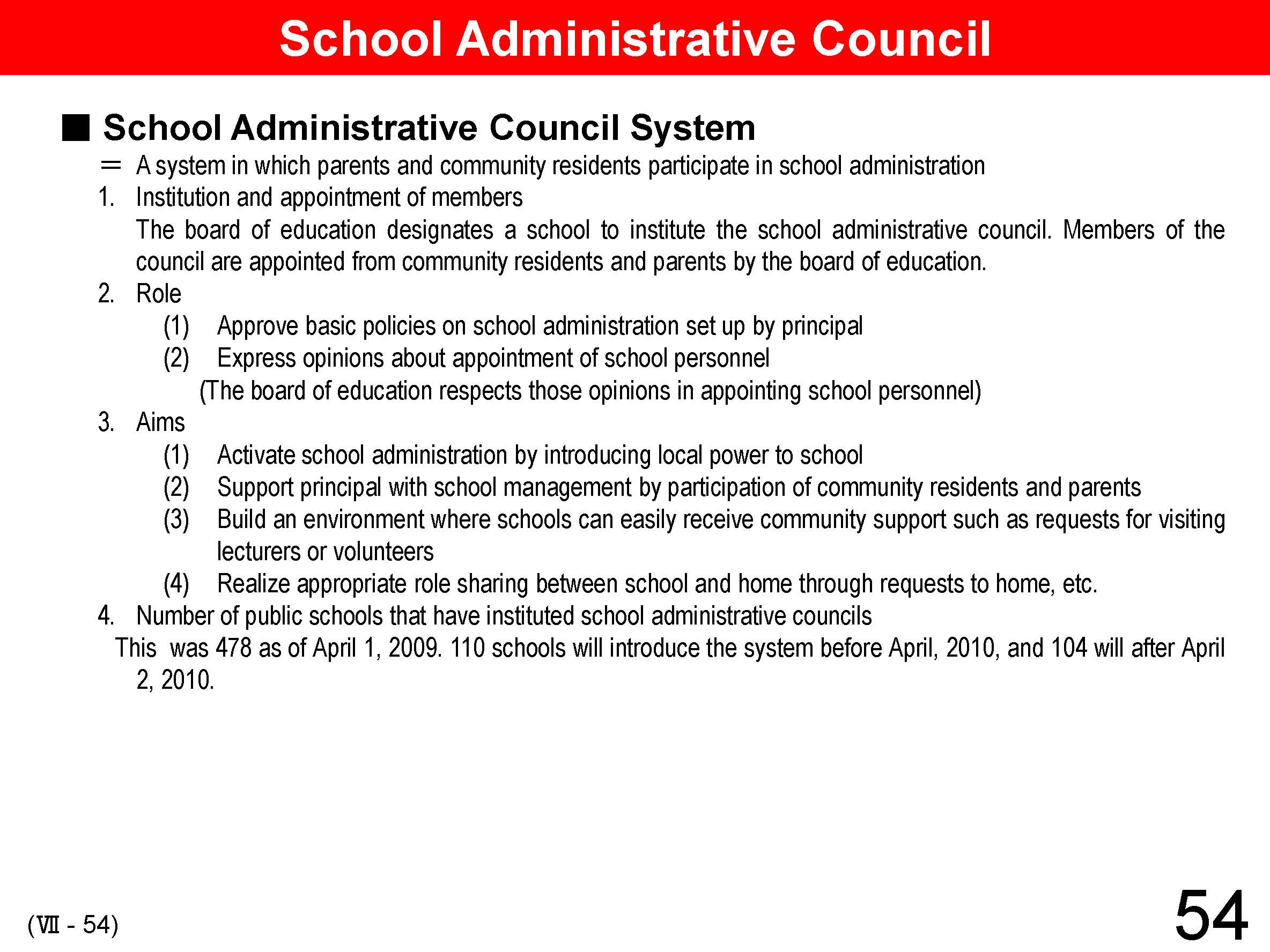 |
The school administrative council system was introduced in 2004 with the partial revision of “Act on the Organization and Operation of Local Educational Administration” Different from the school councilor system, this is designed to be a meeting structure with such clear authority as to approve principal’s basic policies and express opinions about appointment of school personnel. Schools instituting the system are also called schools run by the community or community schools. http://www.mext.go.jp/b_menu/houdou/21/06/__icsFiles/afieldfile/2009/06/29/1279651_1.pdf |
| 55 | 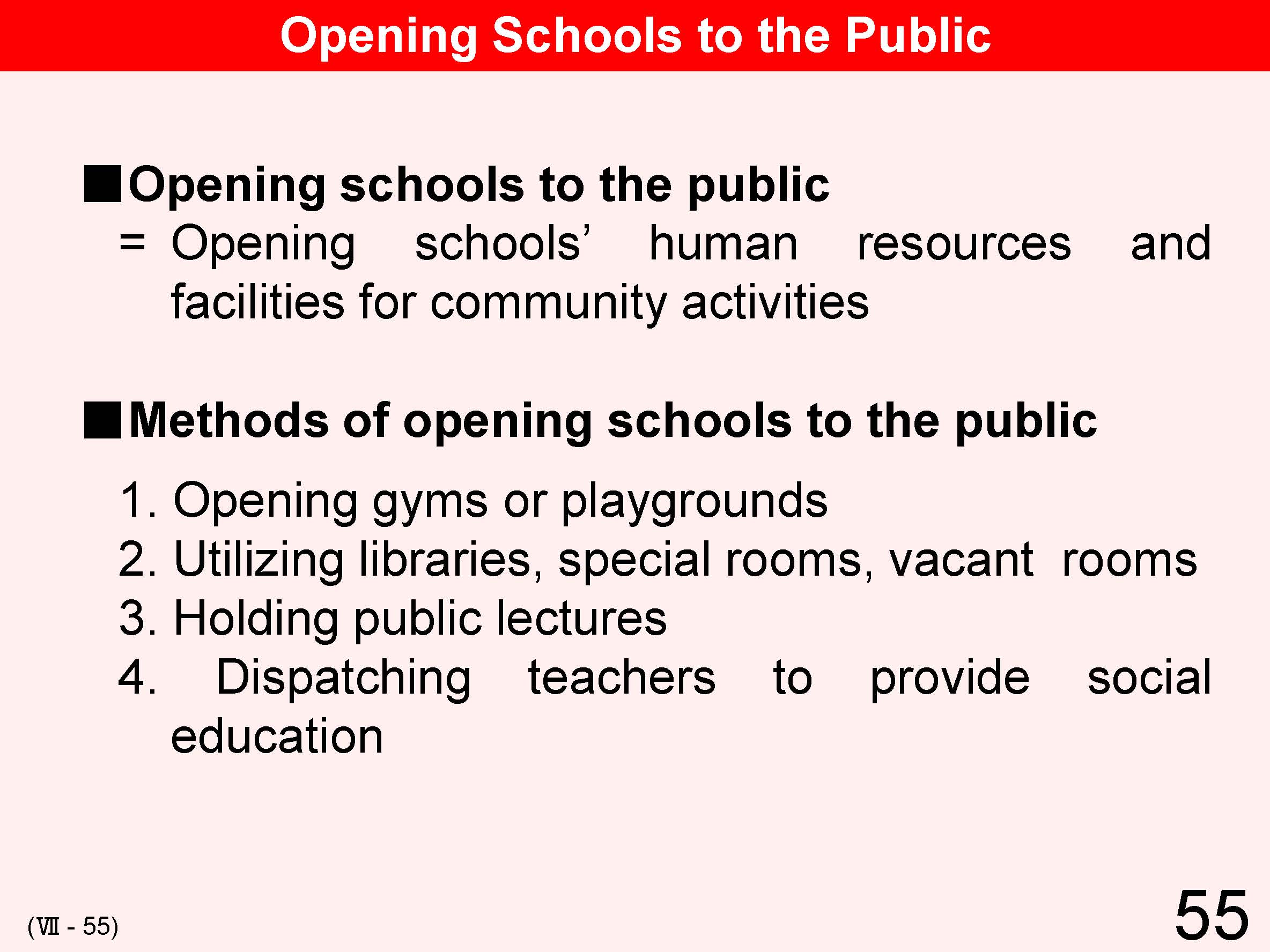 |
Opening a school to the public means that schools serve as a stronghold for the community by opening up resources and educational functions. The report of the Central Council for Education in July 1996 says “schools need to work on various activities as a stronghold of the community, for instance, by opening school facilities to local children and adults and by actively providing learning opportunities.” Meanwhile, the report of the Council for Life Long Learning in April 1996 says it is necessary for a school to contribute to the community to which it belongs. This means further extension of school facilities and facilitating contributions by educational personnel to the communities. Schools now open playgrounds and gyms for local gymnastic activities after school or on holiday. Recently, open schools have been promoted by making available vacant classrooms, reorganizing school facilities and utilization of school premises for public lectures. (Complex facilities --> Ⅶ 57 - 58) |
| 56 | 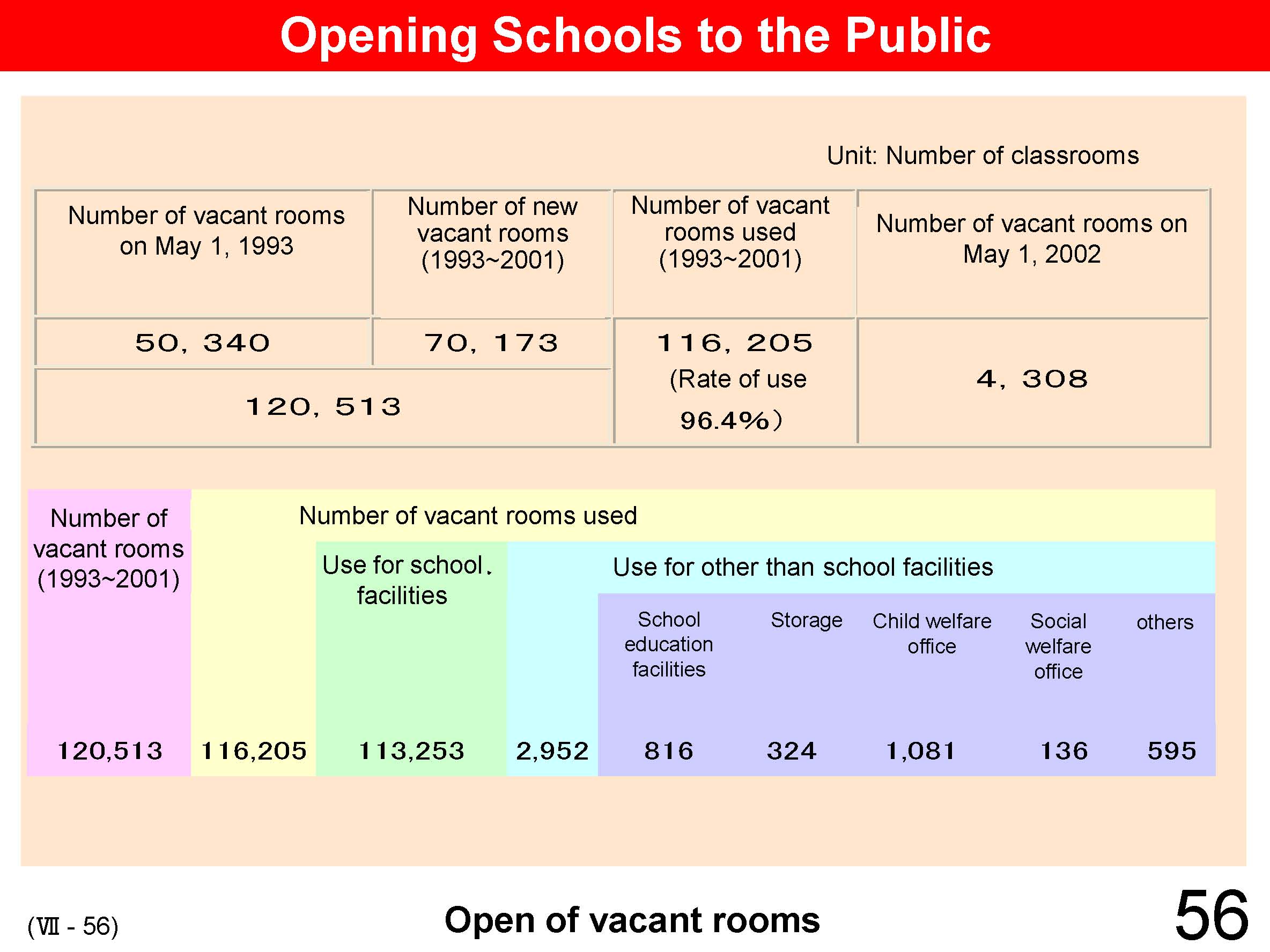 |
This shows the number of vacant classrooms which have accompanied the decrease in the number of students in Japan. The vacant rooms have been converted into social education facilities, child welfare facilities and social welfare facilities. |
| 57 | 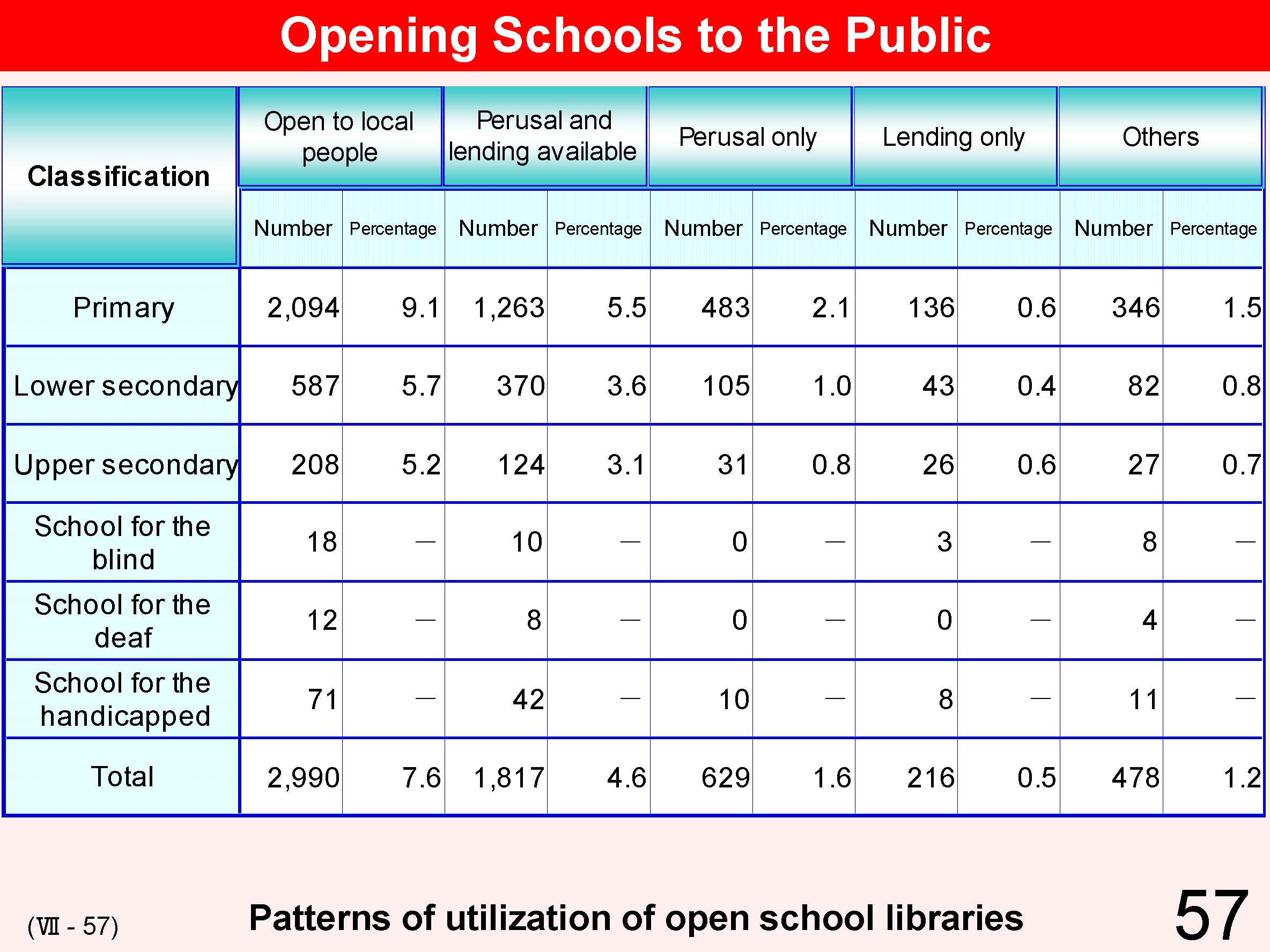 |
School libraries have also gradually become open to the public. |
| 58 | 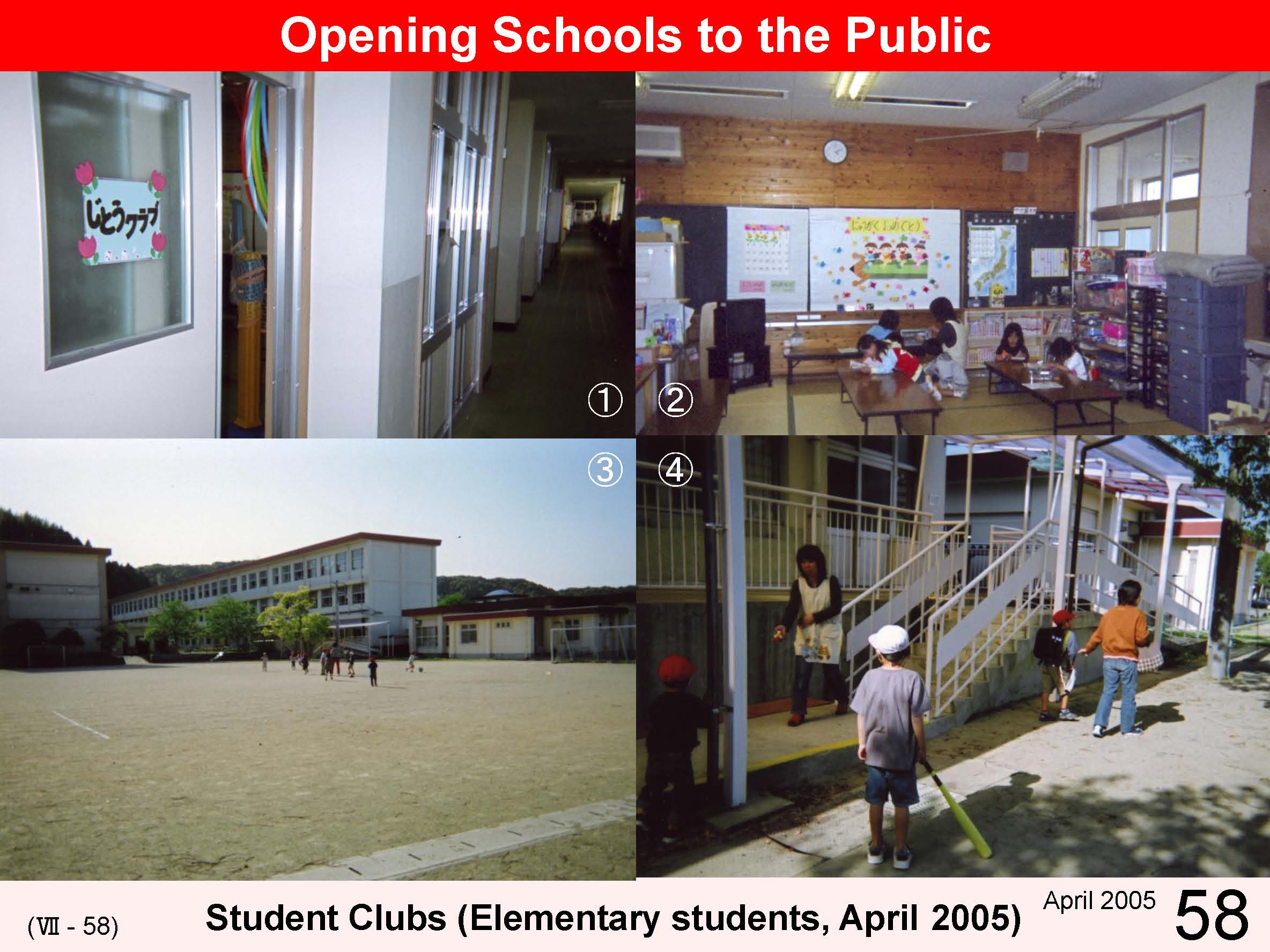 |
The most common school facilities in the open school program for public use are playgrounds and gymnasiums. They are used for social gymnastics, community events and boys sport club activities. It is necessary for school to provide application procedures for users, and make rules clarifying responsibilities for cleaning up after the facilities have been for overall management. (1)(2) Using classrooms as places for students’ clubs (3) Some students are playing in playground (4) Parents come to pick up their children * This students’ club takes care of registered students of grades 1, 2, and 3, until 5pm after school. The students’ club is run by a city, with 2 staffs arranged. |
| 59 | 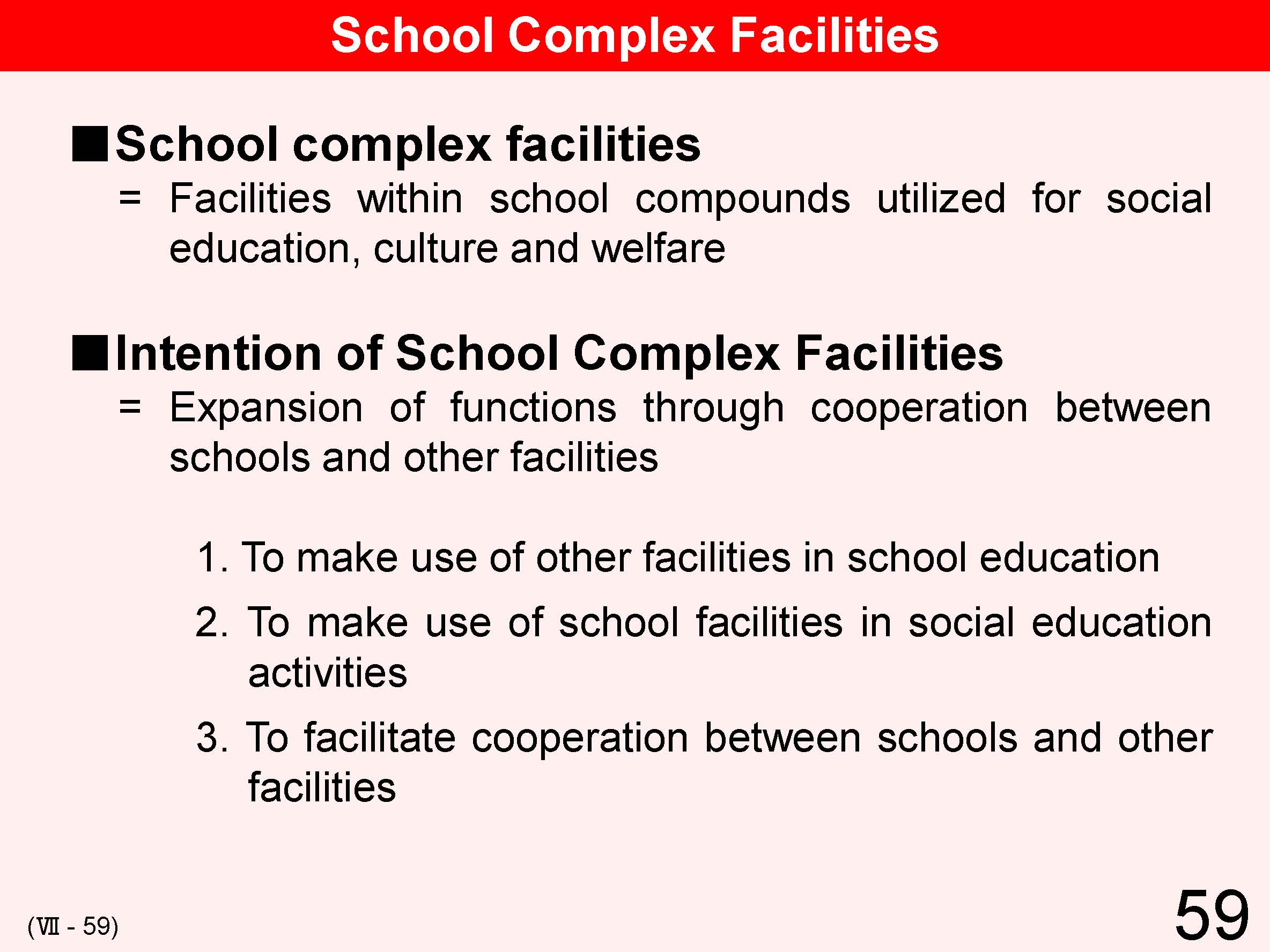 |
School complex facilities encompass educational facilities such as school buildings, community centers and libraries. In March 1991, MEXT issued an ordinance about planning, designing and management of facilities in school complexes for the prefectural Boards of Education. According to the ordinance, school facility complexes mean that “educational facilities such as school facilities, social education facilities, cultural facilities, and sports facilities within one building or premises are institutionalized so as to be inter-linked and interactive.” The aims are (1) ground maintenance of a comprehensive lifelong learning community and (2) quality improvements in school environments to facilitate educational uses. At the planning level, facilities that can be inter-linked to unify space are designed to help improve the local learning environment, and are organized and arranged in a way that promotes positive learning environments for students and community members. In October 1997, “Plan and Building of Complex and High-size School Facilities” points out that “it should be built to ensure a high quality of learning environment and safety, and be easily utilized as public facilities, and to be planned in a way to promote interactions between older people and students at these educational complex facilities. |
| 60 | 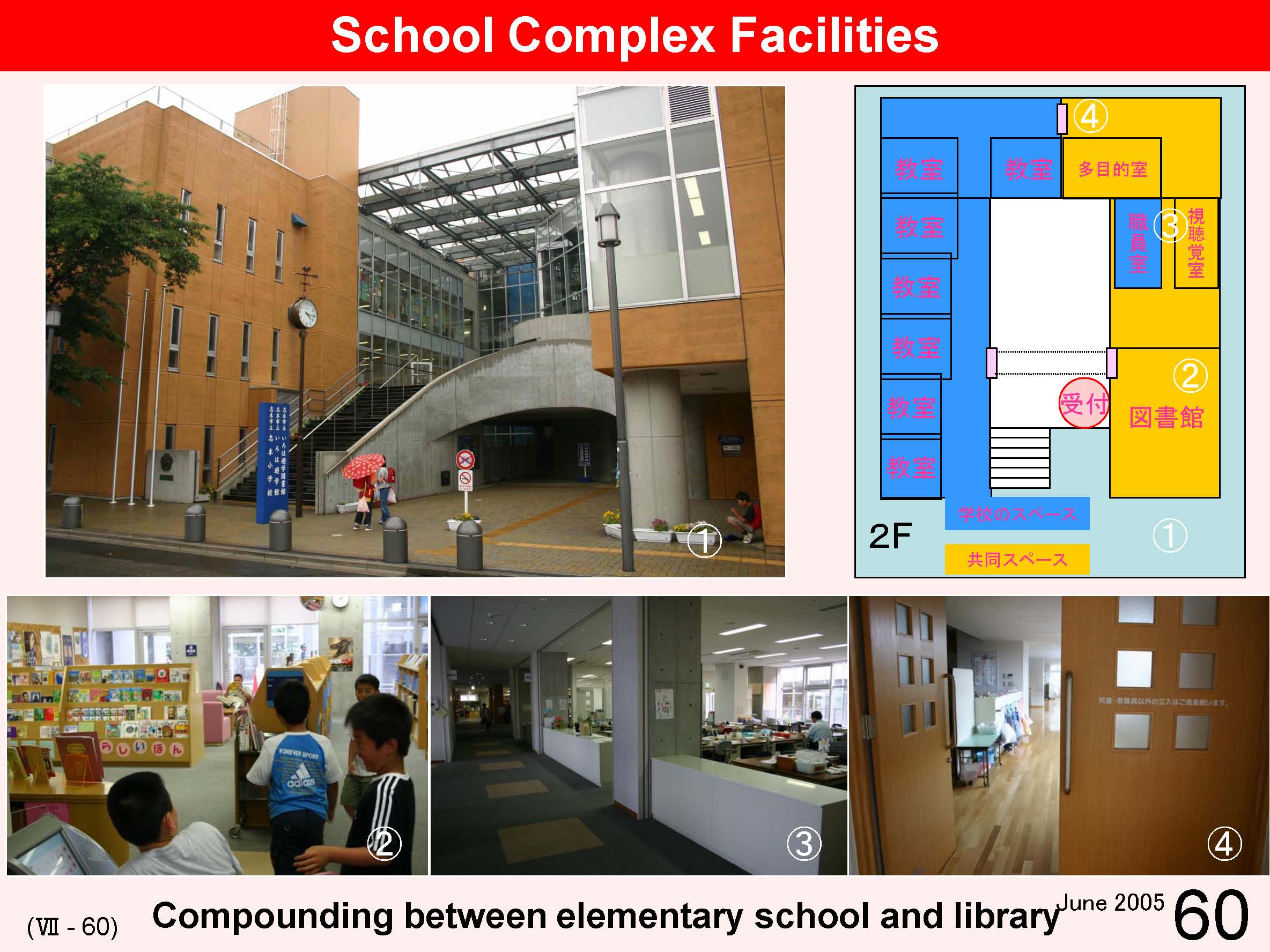 |
This is a facility located between an elementary school and a citizen’s public hall (kominkan) and the city library. It is possible to use the library and the hall for educational and school activities. It is also easy for citizen’s public hall users to use vacant classrooms in local schools. In this school, the teacher’s room is next to a city library and separated from the corridor with a counter. It can be said that this school is open to the community. (1) Left side: elementary school, Right side: library and citizen’s public hall (2) Library (3) Teachers’ room and library (4) Door dividing elementary school and common space |
| 61 | 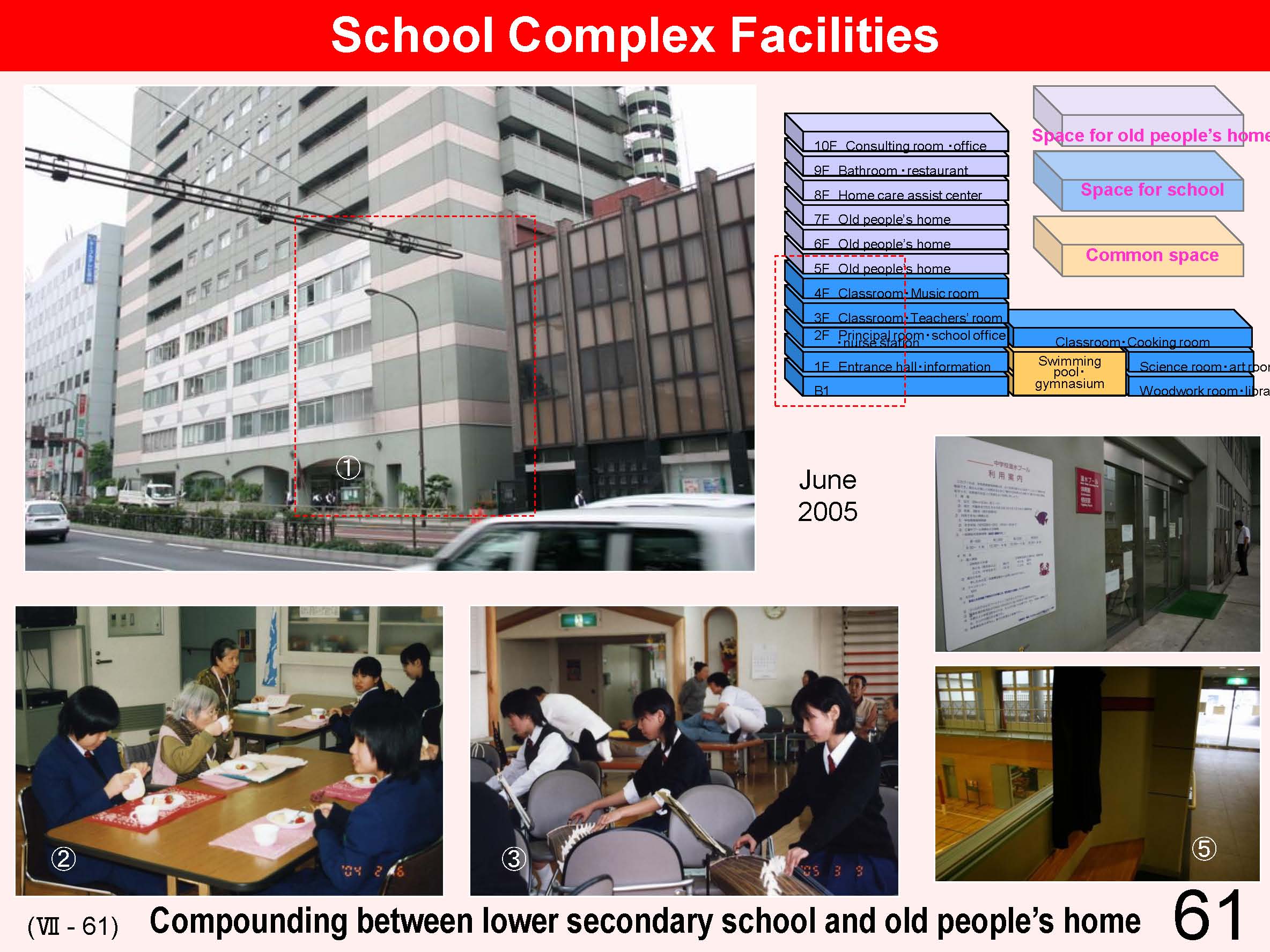 |
This example is of an institution in the compound of a lower secondary school and a welfare facility (special nursing old people’s home). The lower secondary school makes use of the facility during the period of integrated study, and special activities. Students can also interact with users of the facilities. (1) The building of a lower secondary school and old people’s home. (2)(3) Lower secondary school students and adults get together. (4) The lower secondary school opens its gymnasium to community. (5) Gymnasium and the entrance of a lower secondary school. |
| 62 | 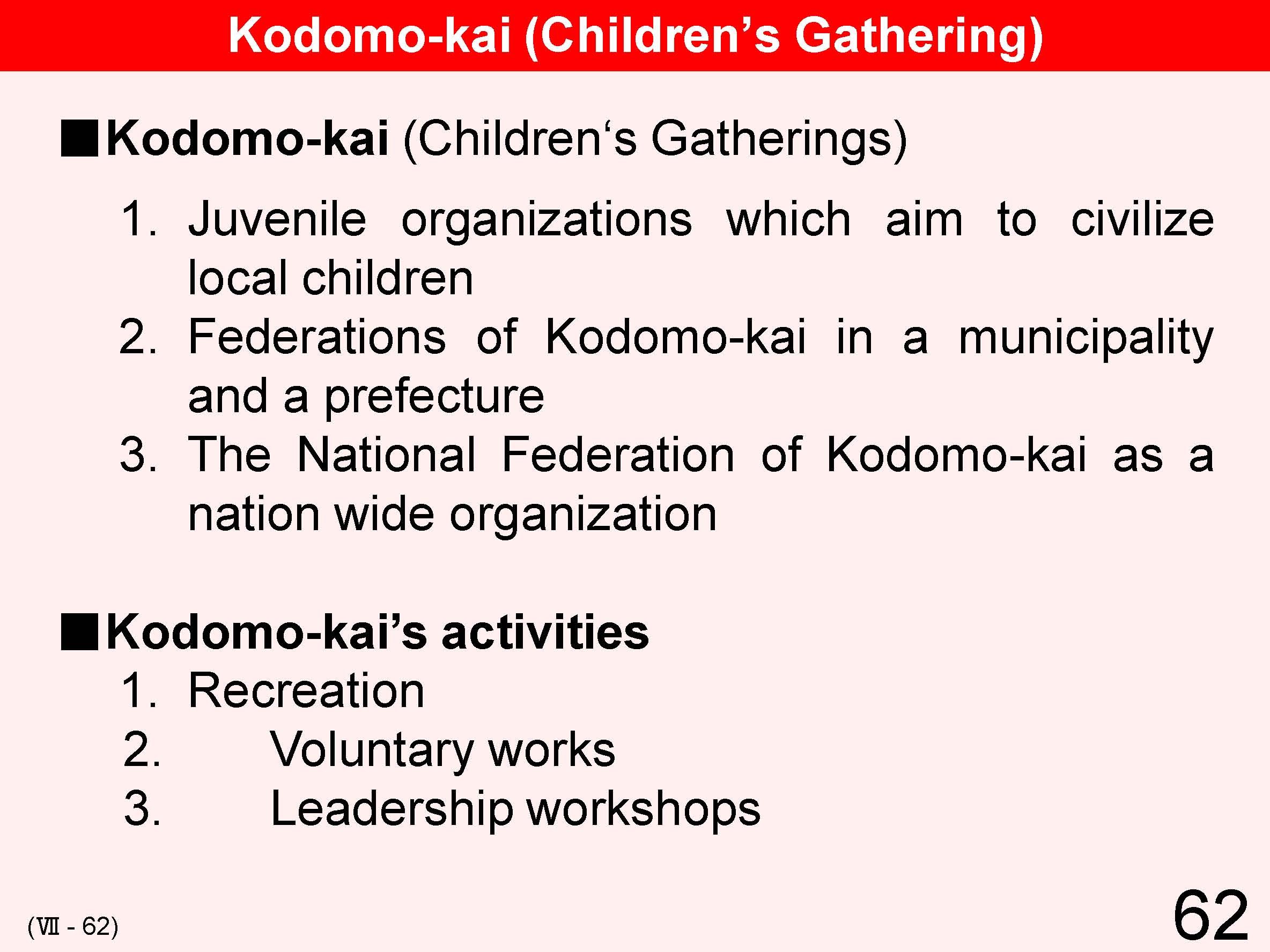 |
“Kodomo-kai” is a juvenile organization designed to civilize local children, and it encourages recreation, voluntary work, and leadership workshops. “Kodomo-kai” have both children’s administration and parental administration. At a city and prefectural level, there are Federations of Kodomo-kai, and at a national level, there is the National Federation of Kodomo-kai organizations. What the National Federation of Kodomo-kai does is to: (1) Guide and cultivate Kodomo-kai activities, (2) Coordinate between instructors and leaders who engage in Kodomo-kai activities, (3) Cultivate and activate leaders in Kodomo-kai activities, (4) Publish materials and do research to promote Kodomo-kai activities, (5) Cooperate with related organizations to fully promote Kodomo-kai activities, (6) Serve as a safety branch of Kodomo-kai activities. |
| 63 | 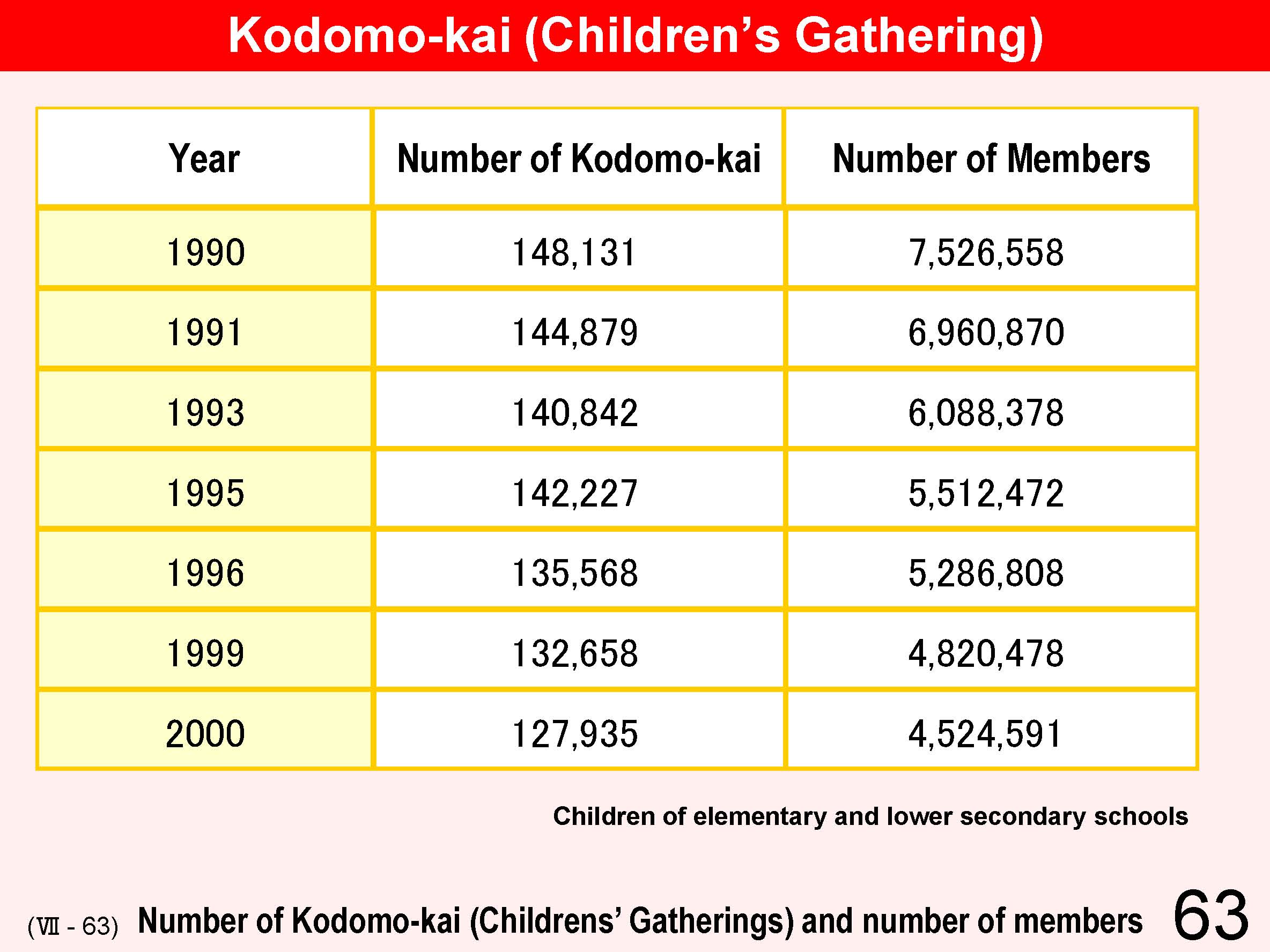 |
There is a tendency for declines in kodomo-kai membership accompanying falling birth rates and social changes in local communities. |
| 64 | 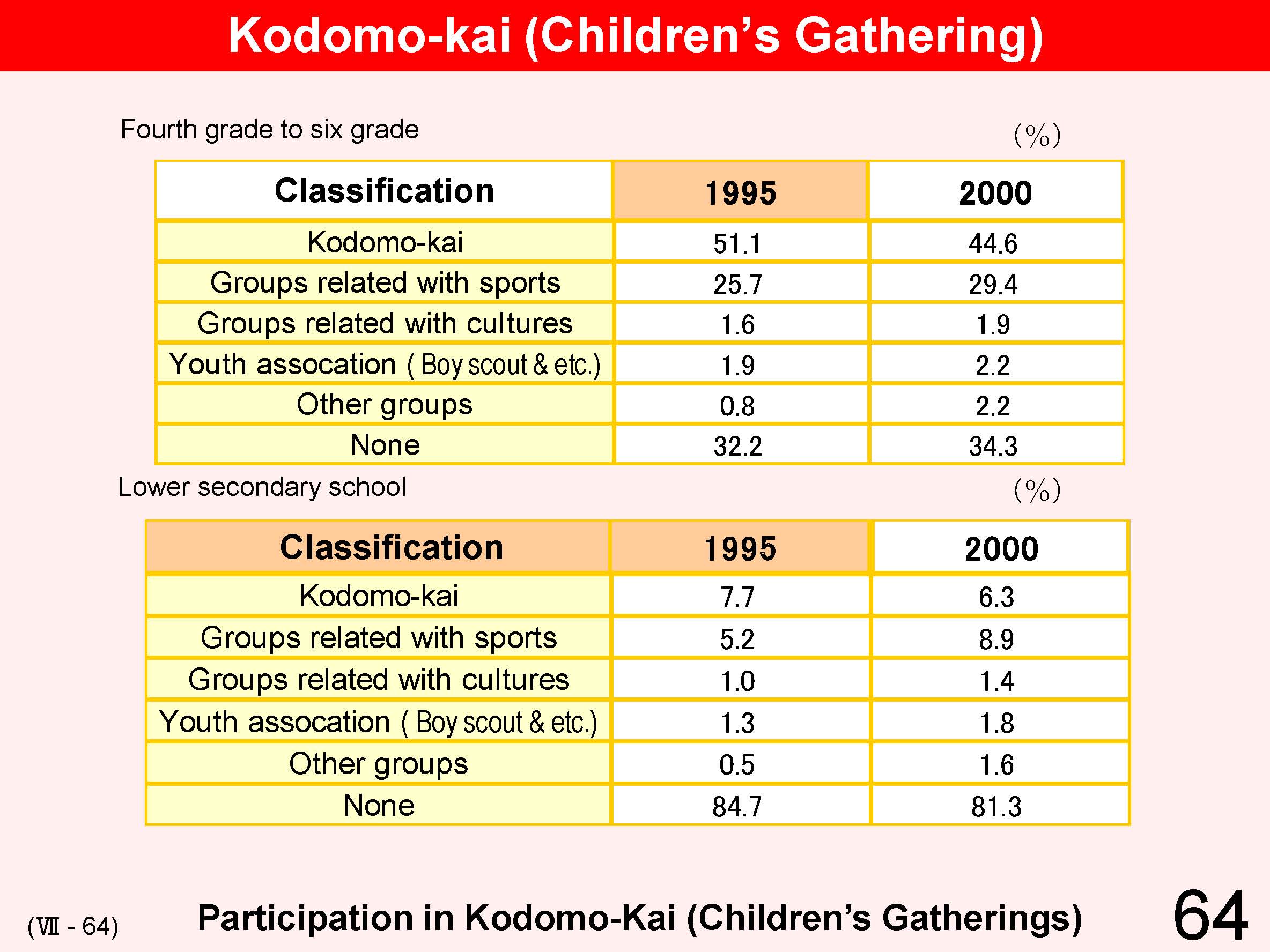 |
The participation rates in “Kodomo-Kai” (children’s gathering) are falling at both elementary school and lower secondary school, although 45% of children at elementary school still participate in Kodomo-Kai, which is a very high rate, compared with the other groups. At lower secondary school levels, participation in groups related to sports is the highest, with the rate of participation in Kodomo-Kai coming. However, more than 80% of students in lower secondary schools do not participate in any outside groups, which is caused by high rates of participation in club activities organized by schools themselves. |
| 65 | 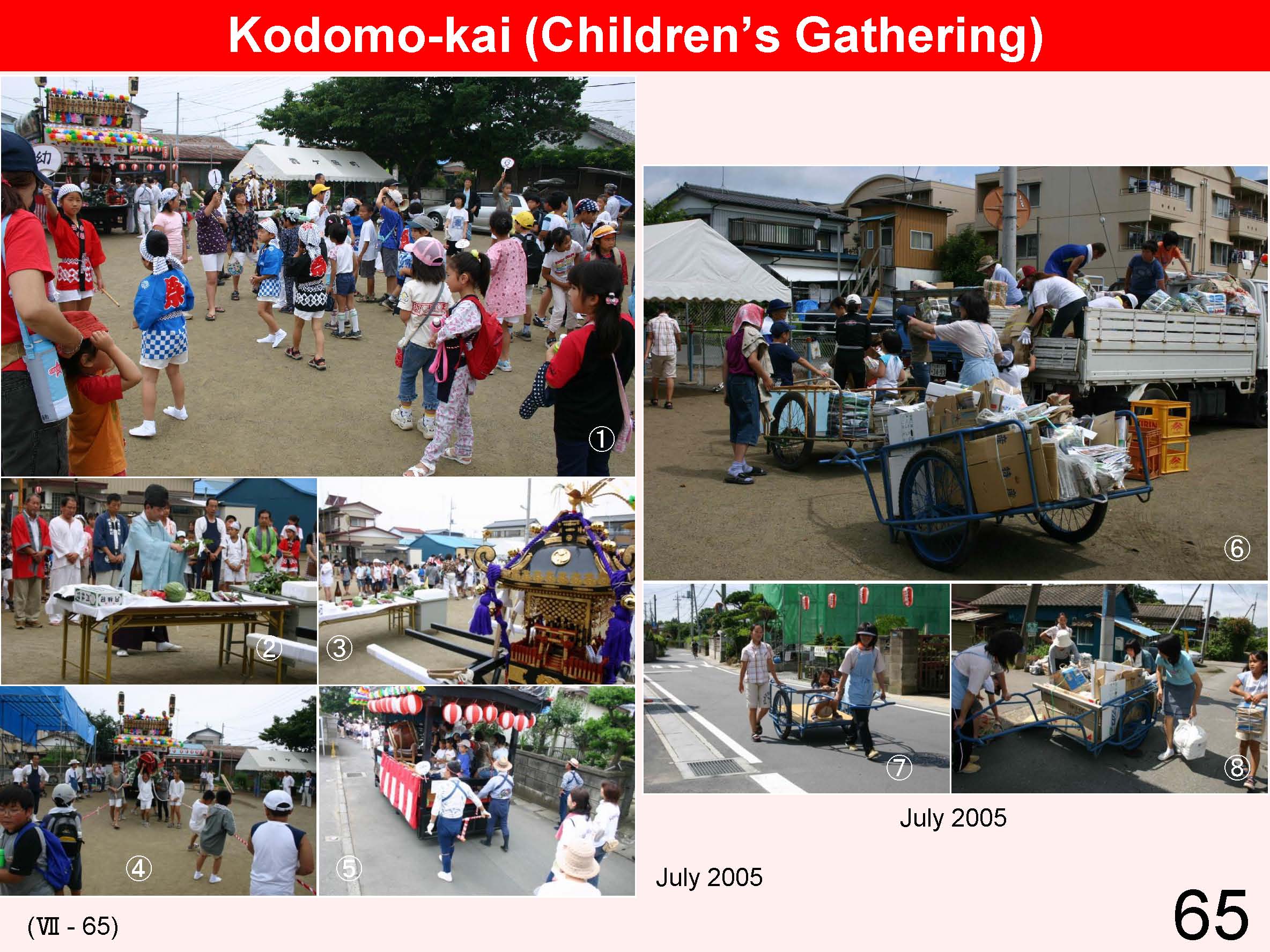 |
“Kodomo-Kai” engages in various activities. In this “Kodomo-Kai,” 112 elementary school students and 60 lower secondary school students participate as members. Funds are raised from the membership fees (100yen/months) and from rubbish collection every month. The activities include; summer festivals, one day camps, visit s to old people’s homes, pounding steamed rice into cake (mochi-tsuki), farewell parties. (Attending to school in a group --> Ⅸ 30) (1) Lining up with same grade students, (2) Purification by a shinto priest, (3) A sacred portable shrine, (4) Lion dance, (5) A float, (6)(7)(8) rubbish collection |
| 66 | 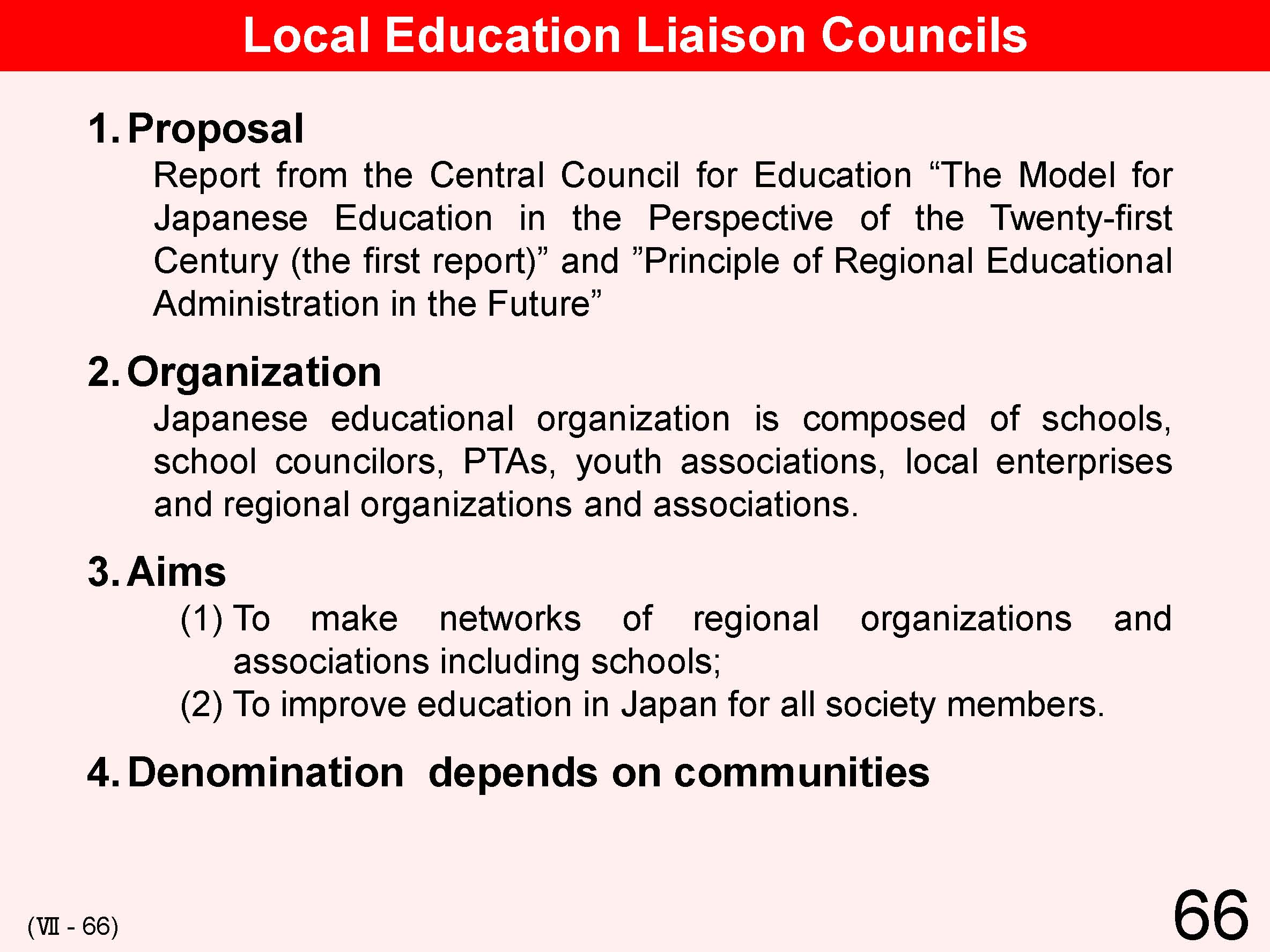 |
Schools are required to cooperate and to construct networks with regional facilities, organizations and associations. For that reason, the establishment of local education liaison councils was proposed in the first report from the Central Council for Education in July 1996. Local education liaison councils are established mainly by municipal Boards of Education through participation of the PTAs, youth associations, local enterprises, regional organizations, regional associations and schools. Liaison Council roles are to transmit and consult about activities and to construct networks, in other words, to promote improved child raising by all members involved. The report proposes the establishment of a Center for Revitalization of Community Education to provide services such as information dissemination, consultation, registration and introduction of guides and volunteers. The September 1998 report from the Central Council for Education proposed efforts to assess the needs for educational administration in school districts and to promote close cooperation between schools and regional societies by adding school councilors to Local Education Liaison Council membership. |
| 67 | 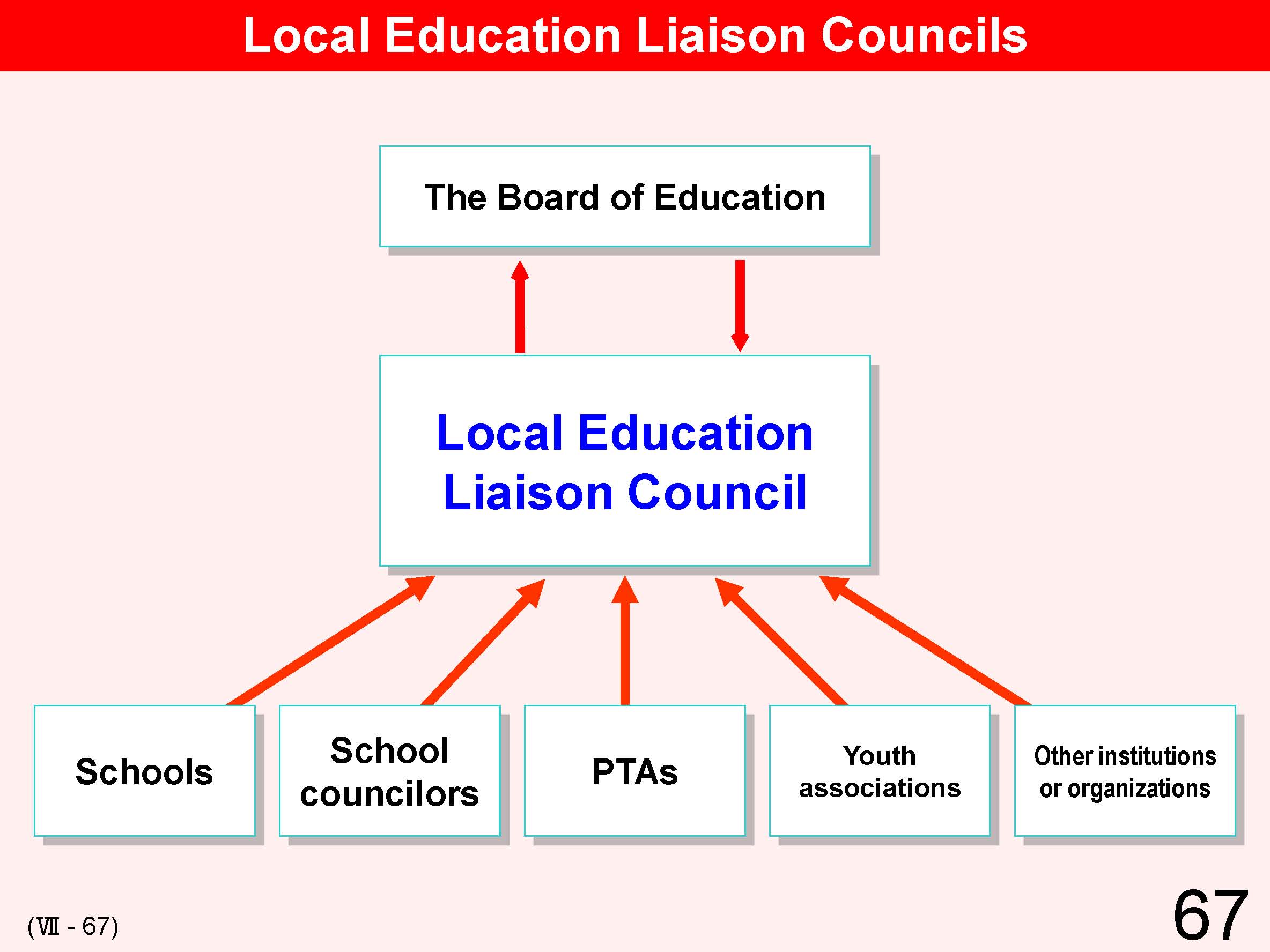 |
Local Education Liaison Councils are cooperative organizations composed of local organizations. |
| 68 | 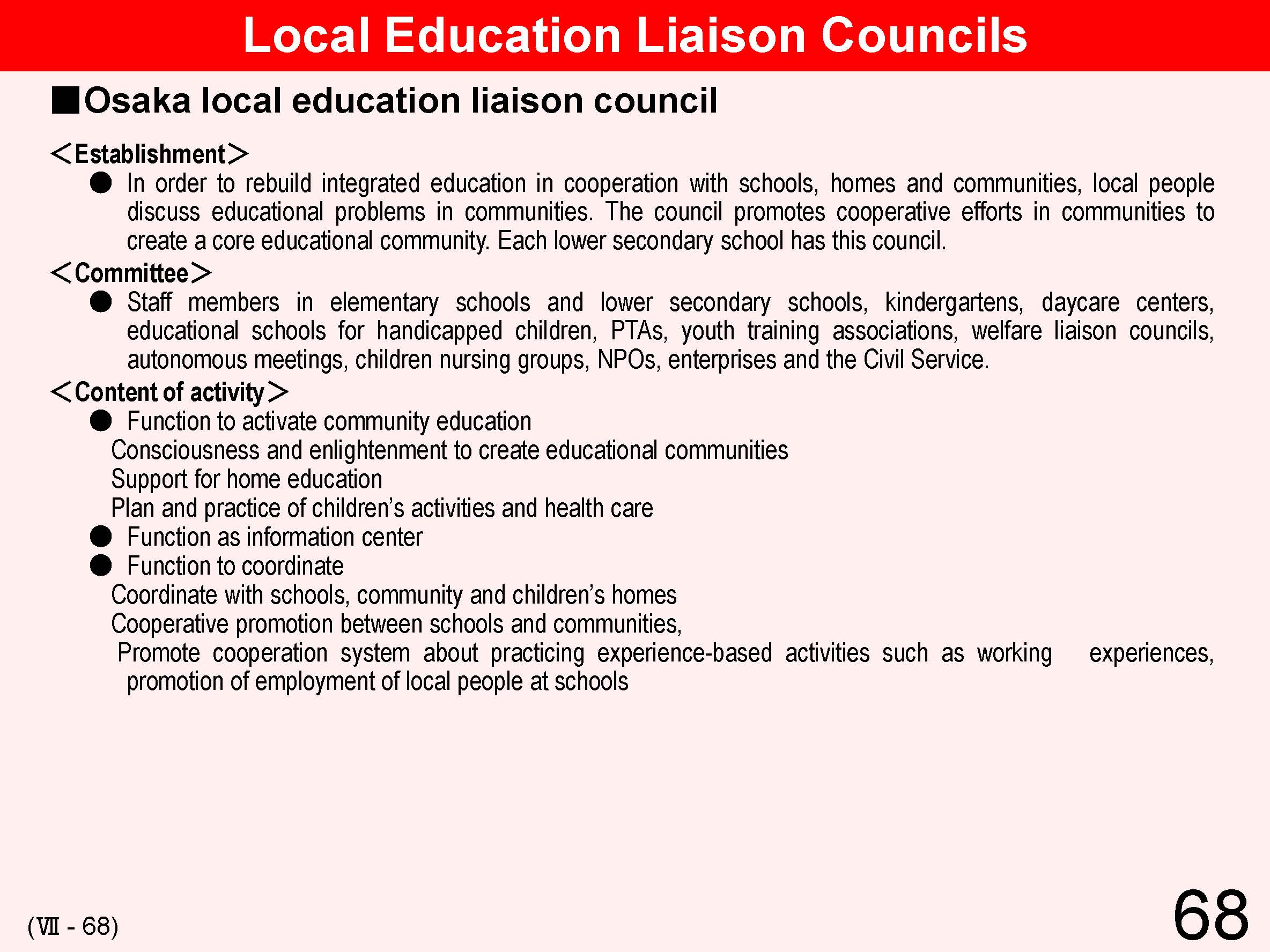 |
In Osaka prefecture, each lower secondary school has a “local education liaison council.” In order to rebuild integrated education in cooperation with schools, homes and communities, local people discuss educational problems in the community. The council promotes cooperative efforts in communities to create an educational community. The committees are made of staff members from elementary schools and lower secondary schools, kindergartens, daycare centers, schools for handicapped children, the PTAs, youth training associations, welfare liaison councils, autonomous meetings, children nursing groups, NPOs, enterprises and the Civil Service. |
| 69 | 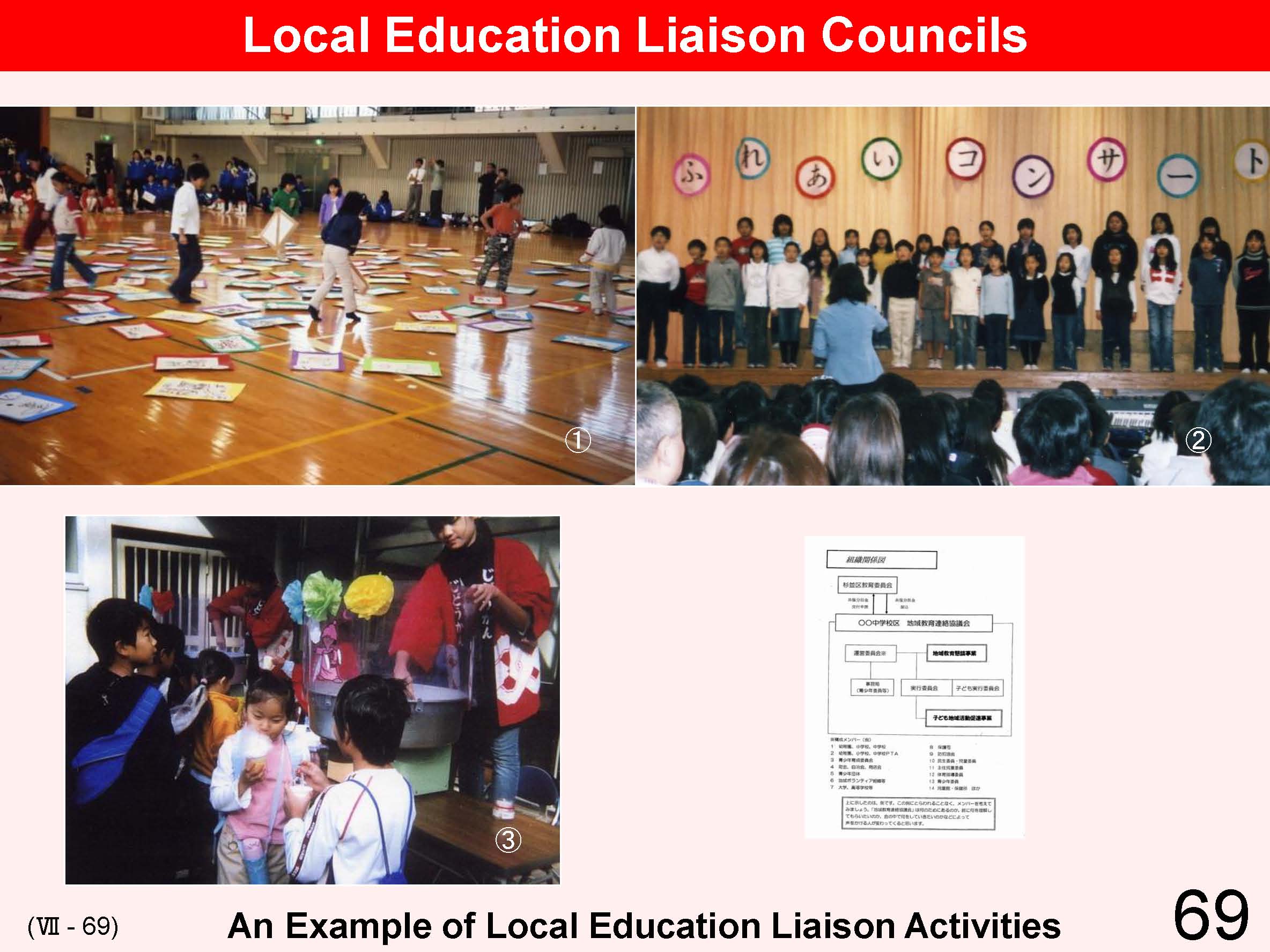 |
Local education liaison councils work together with people and organizations in communities, support school education and child raising, publish information magazines and conduct educational activities and events within communities. (1) Karuta (traditional Japanese playing cards) party, (2) Concert, (3) Stalls |
| 70 | 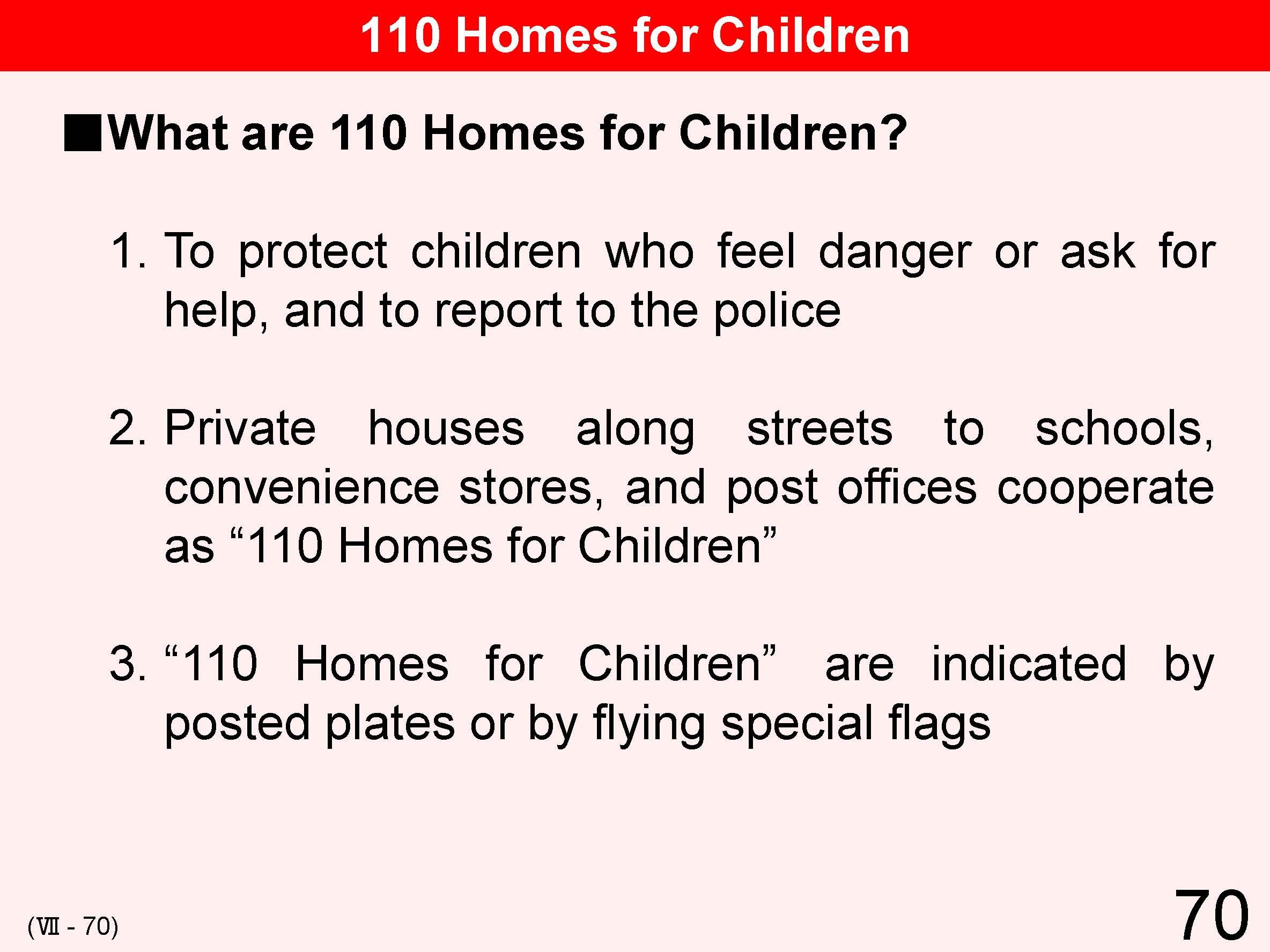 |
“110 Home for Children” was started as a grassroots activity of a local autonomous body and has expanded to all over the country. It is named after 110, the emergency phone number for police. Amid an increase in the frequency of appearances of suspicious persons and kidnapping or attempted kidnapping of children in communities, this institution has the significant function of assisting overseeing of children’s safety in communities as a whole by providing shelter where children can seek for help when they feel or encounter danger. |
| 71 | 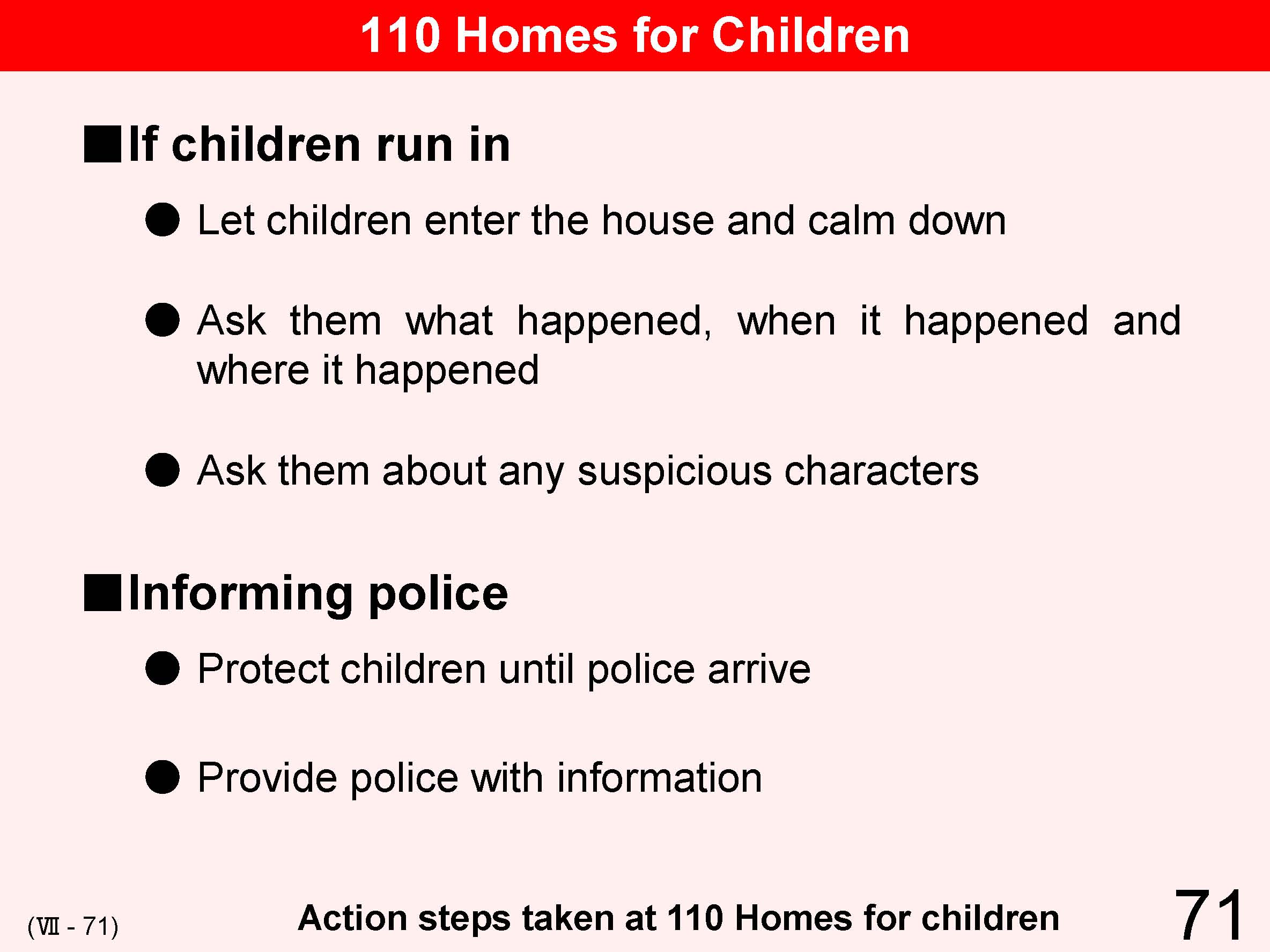 |
Private houses in public and convenience stores cooperatively offer their places as “110 Home for Children.” If children run in a 110 Home, residents in the home provide shelter for children, ask what has happened, when and where it has happened and also ask them characteristics of suspects. Then the residents report the incident to the police. |
| 72 | 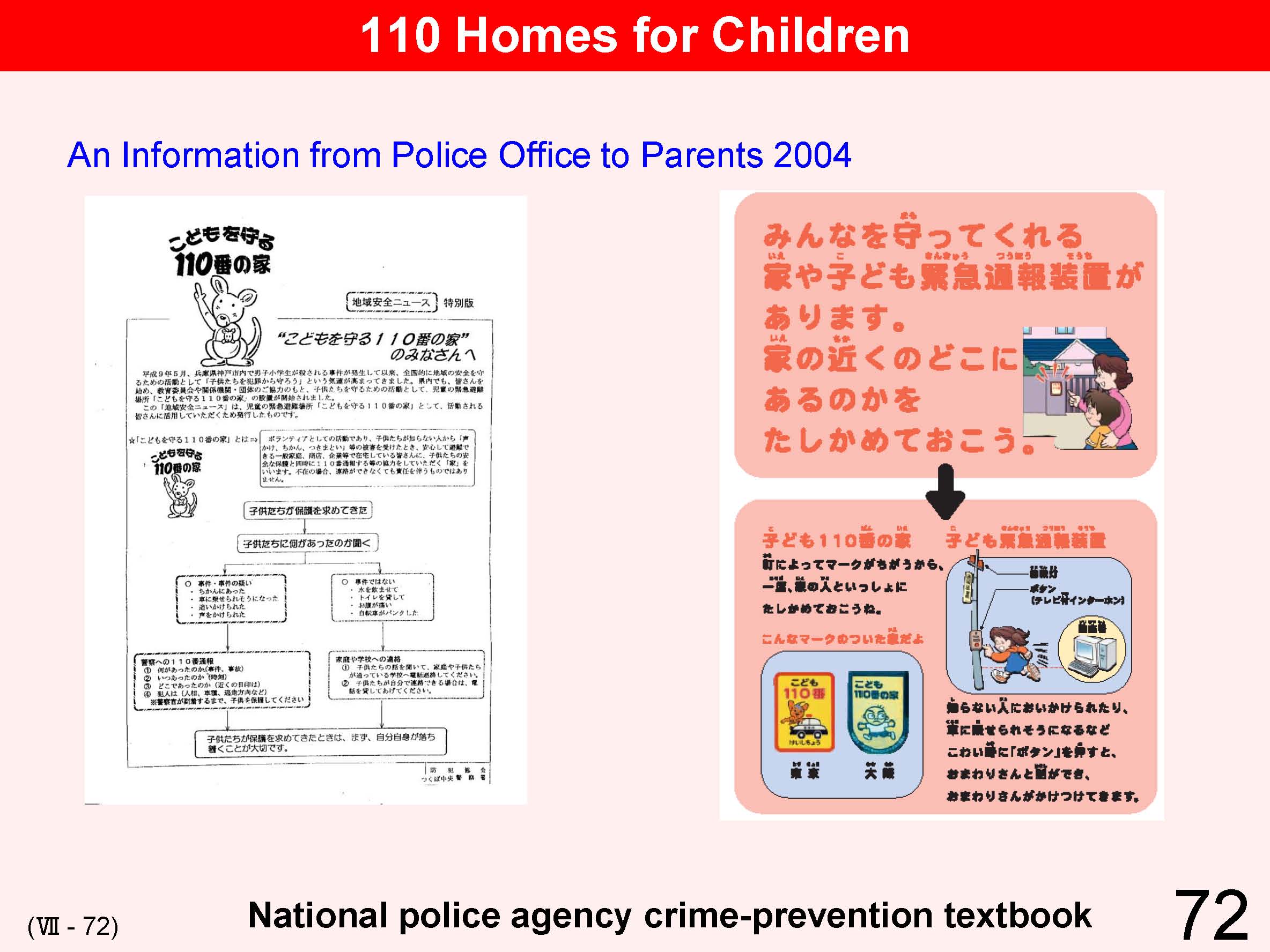 |
Booklets are prepared for children as a crime prevention measure. One purpose is to inform them of the location of 110 homes for children. Anther purpose is to inform the children that they can ask for help when they see any suspicious characters, get into danger and are involved in an incident. |
| 73 | 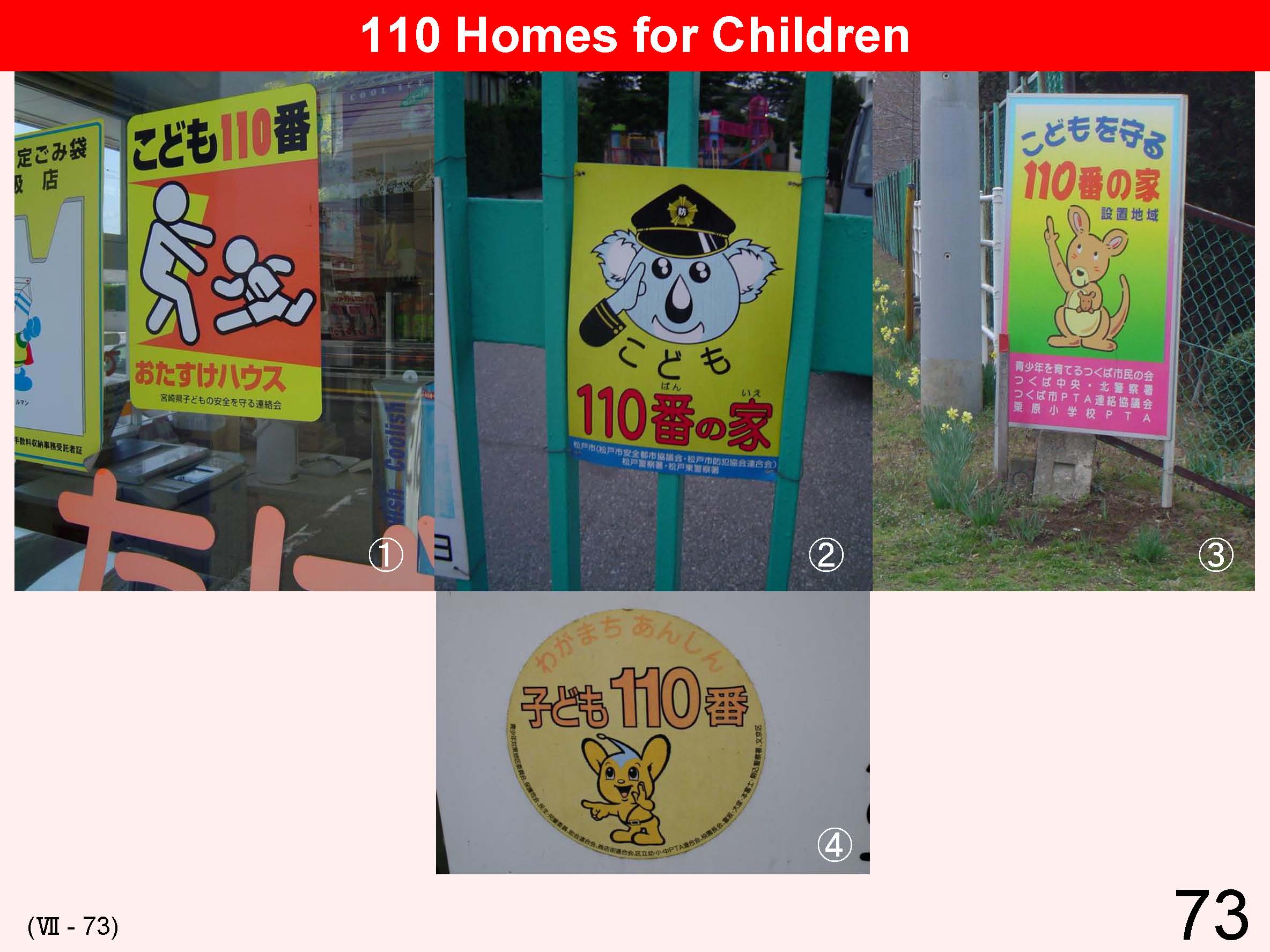 |
Houses of 110 homes for children post signs. It is important for children to know the location of the houses. |
| 74 | 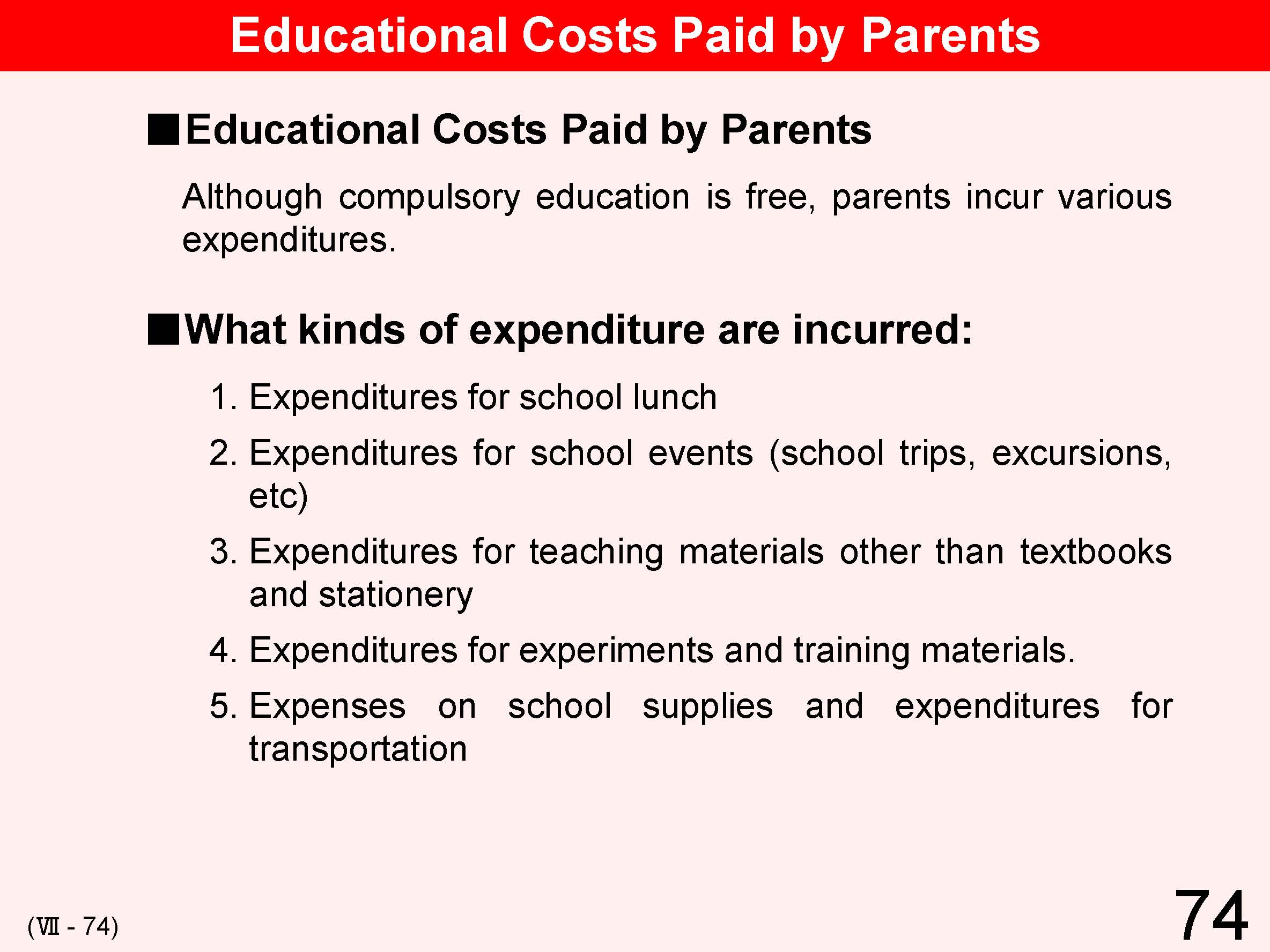 |
Under compulsory education, tuition fees are free at national and public elementary and lower secondary schools, and textbooks are also supplied for free. However, parents incur expenditures such as teaching materials except for textbooks, experiments and practical activities, and school events. Elementary and lower secondary schools that serve school luncheons, charge parents for a part of the costs. Depending on local autonomous bodies or schools, school lunch fees are collected by directly charging bank accounts or are collected in classes directly as monthly class expenditures. Families with economic difficulties may not be able to afford such school expenditures. They can benefit from welfare services and receive assistance such as school supplies, educational materials, and school luncheon fees that are needed for compulsory education in the form of “educational aid.” * Among the expenditures listed above, some are defrayed by parents separately, and others are collected at school. In these cases, the expenditures are charged directly to bank accounts or collected in the form of money as expenditure on class by a home-room teacher. (Class fee --> Ⅴ 41) |
| 75 | 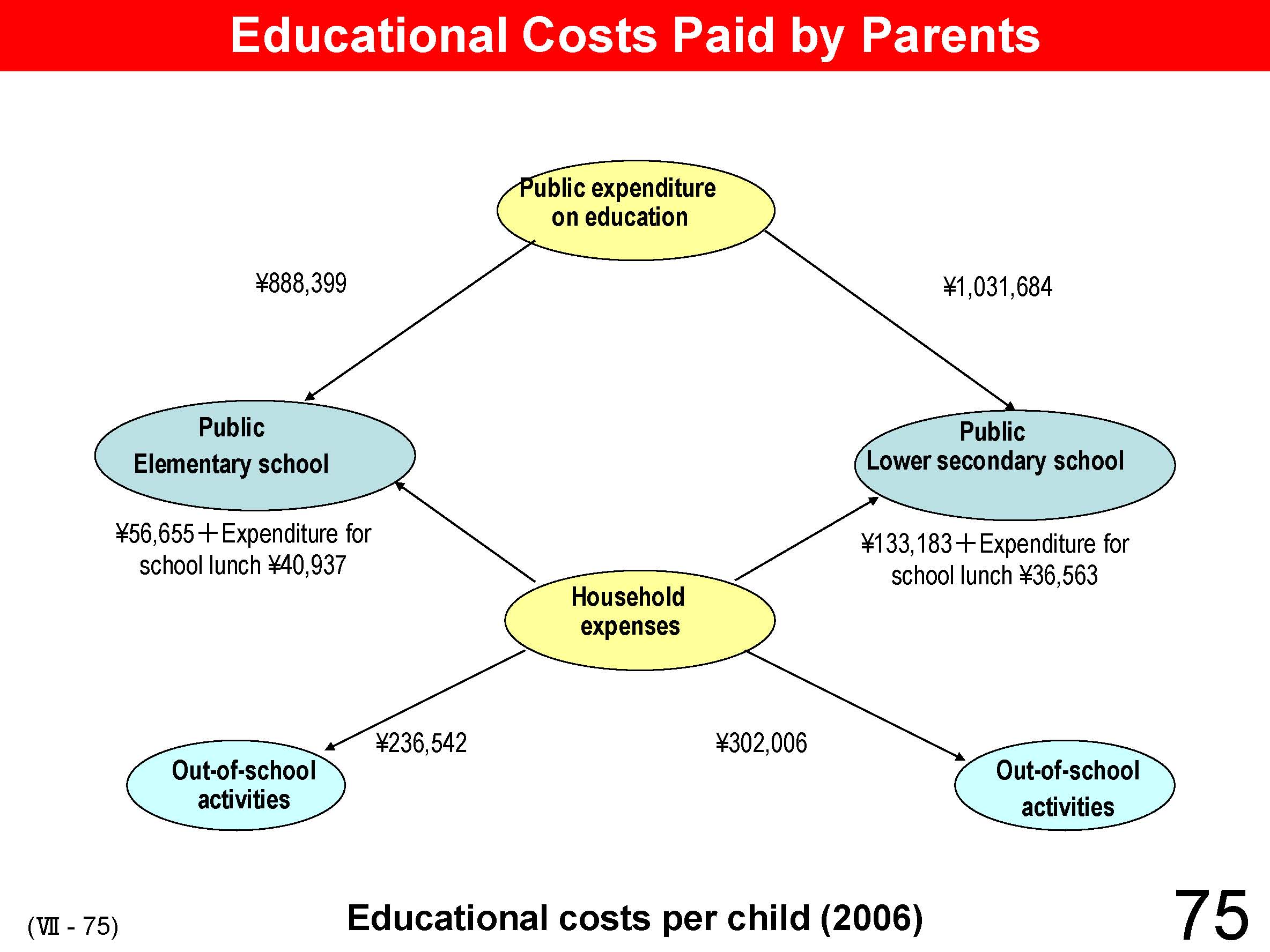 |
Parents pay around 60,000 yen for school educational expenses for their children, and 40,000 yen for their school luncheons annually at public elementary schools. For public lower secondary school children, parents pay around 130,000 yen for school educational expenses, and 40,000 yen for school luncheons a year. In private elementary schools parents pay over 750,000 yen for annual school educational expenses, and in private lower secondary schools they pay over 950,000 yen. With respect to school educational expenses, the difference between those of public and private schools is large. (Example of how expenditure on class is spent --> Ⅴ 42) --> Ministry of Education, Culture, Sports, Science and Technology “Japan’s Education at a Glance (2008)” |
| 76 | 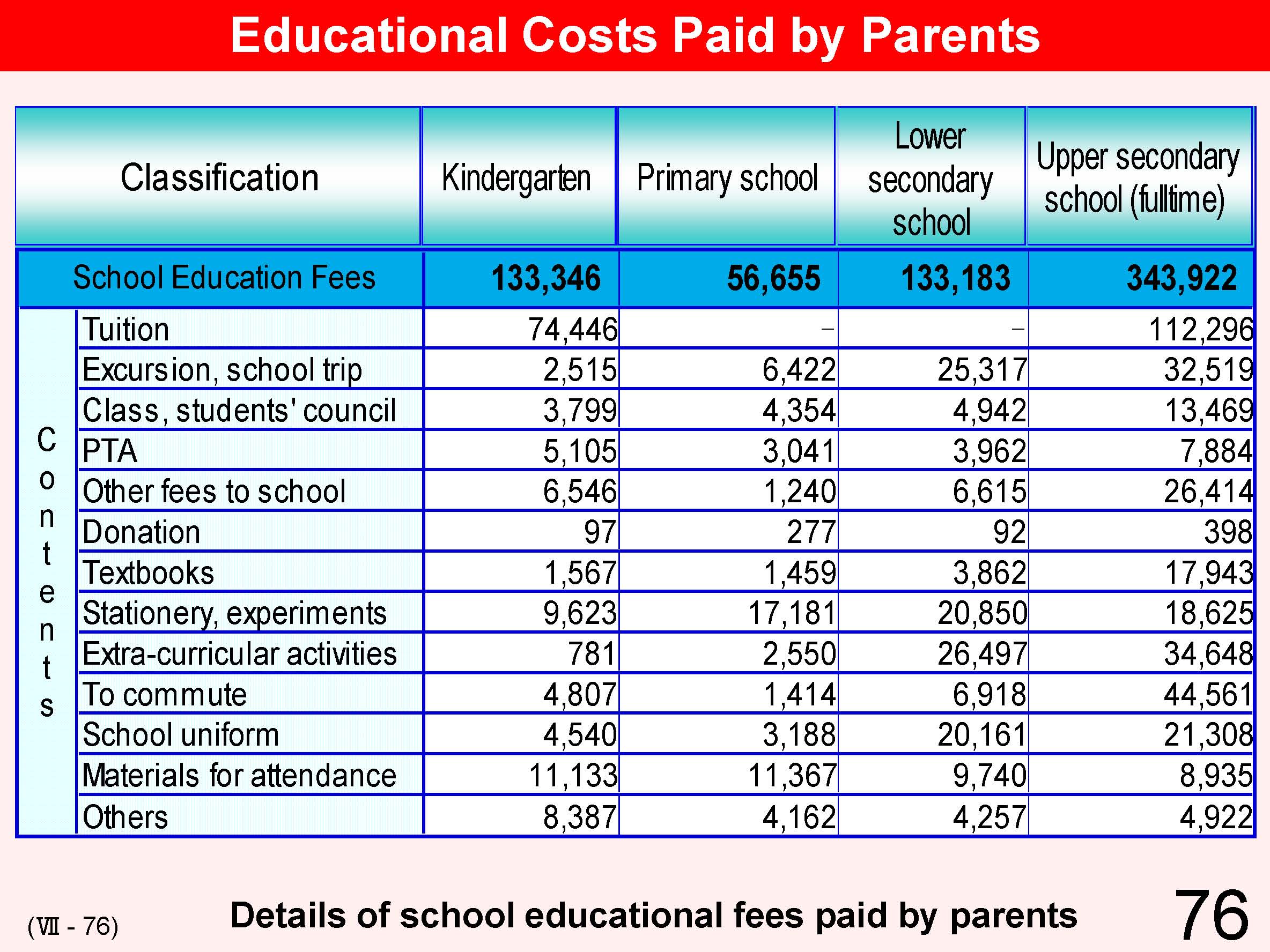 |
Among public elementary school educational fees, parents incur expenses for school supplies and materials for experiments and practice as primary costs, and transformation as secondary costs. In public lower secondary schools, parents pay expenses for school trips and school excursions as primary costs, followed by expenditures for educational materials excluding school textbooks and other school necessities (school supplies and materials for experiment sand practice, and school uniforms which are mandatory under school rules). Because of the costs of school trips to distant places and club activities as extracurricular activities, parents’ expenditures for lower secondary school children are much higher than those incurred in elementary schools. --> Total learning expenditure for children by type of school (Mext, “Trends in Total Learning Expenditure of Households for Children” 2006) |
| 77 | 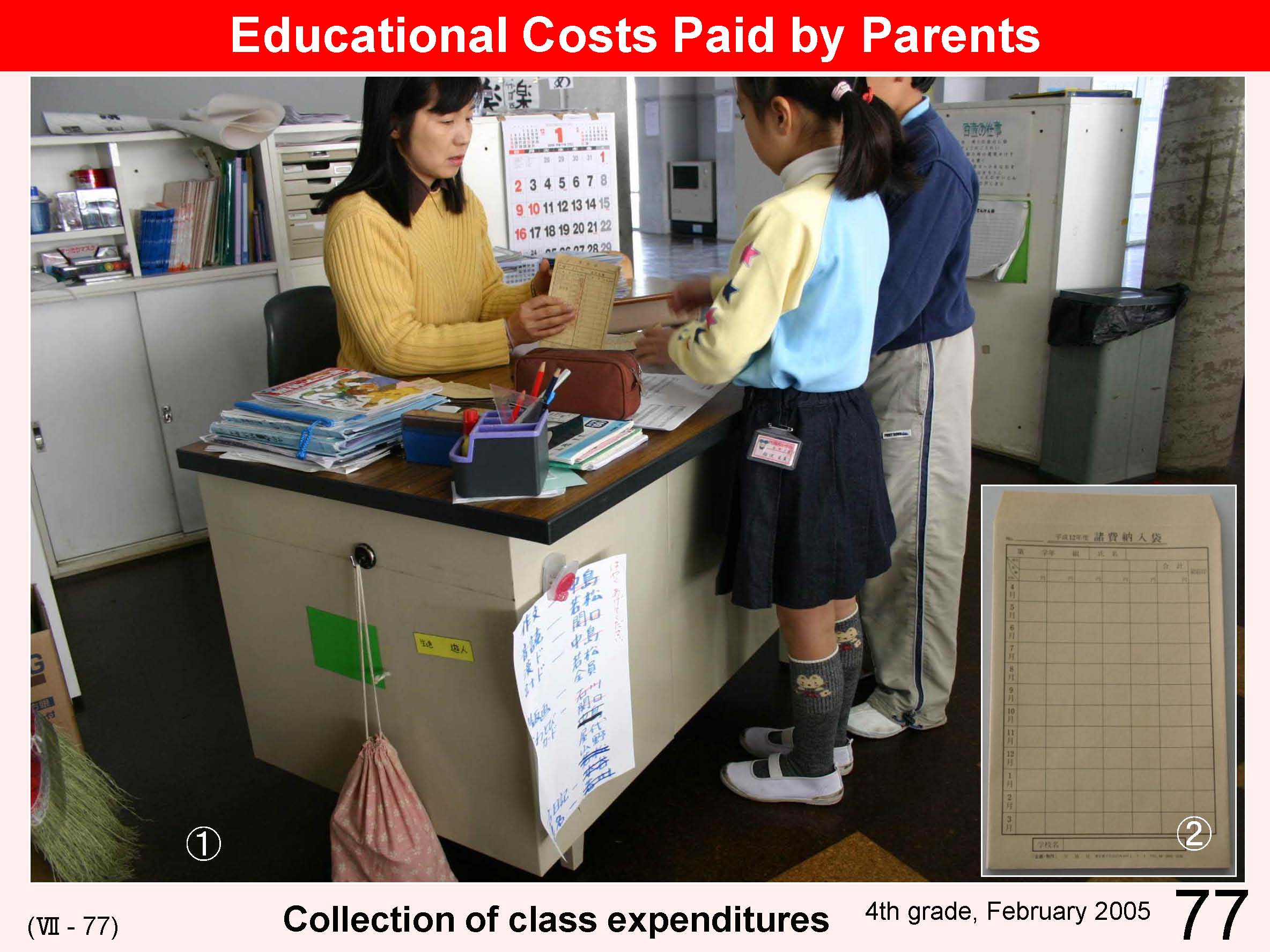 |
An envelope is often used to notify parents of class expenditures and their collection. On the envelopes the home-room teachers write the total amount and breakdown of costs, and the date of collection. These are handed to parents through students. The parents then enclose the exact amount of money needed in the envelop and their children hand it in to teachers at school. The teachers check the collected amount of money and stamp the receipt. If necessary, teachers enclose any change required and repay it to the parents. |
| TOP | ||
Please send your comments and concerns here
kamada@criced.tsukuba.ac.jp
Center for Research on International Cooperation in Educational Development (CRICED) University of Tsukuba
1-1-1, Tennodai, Tsukuba-shi, IBARAKI
305-8572 JAPAN